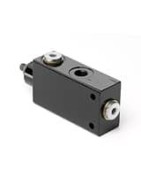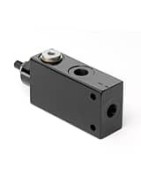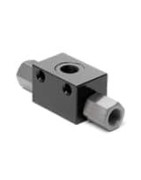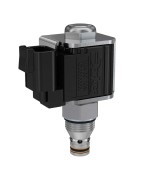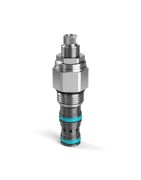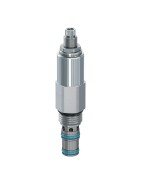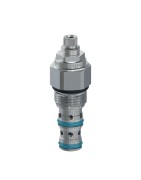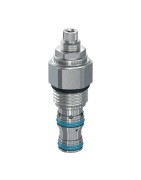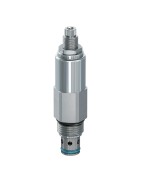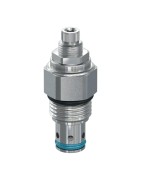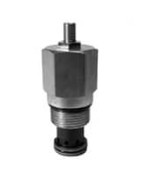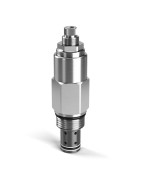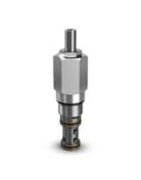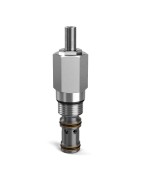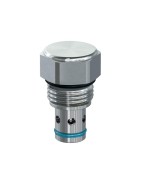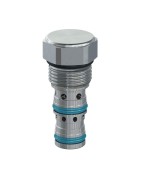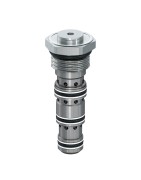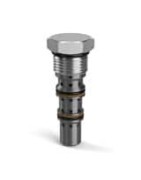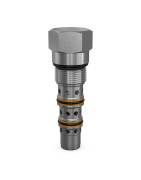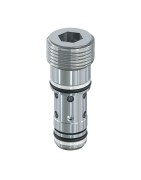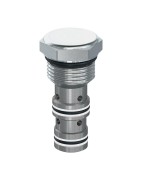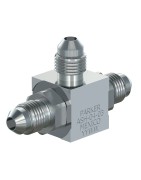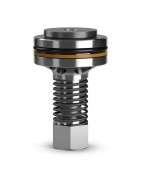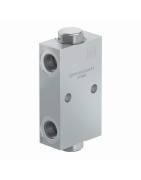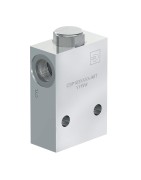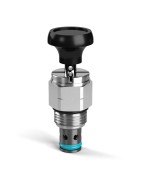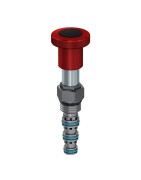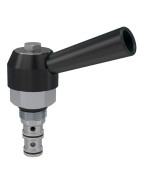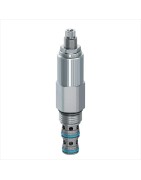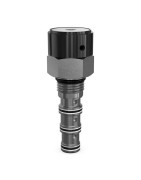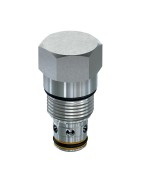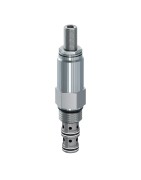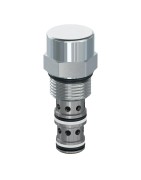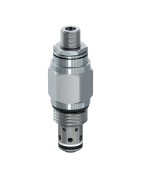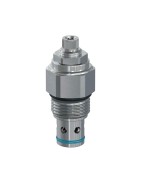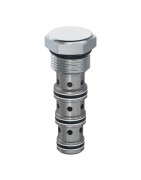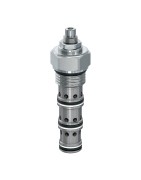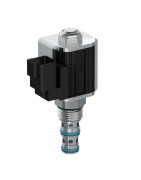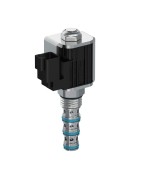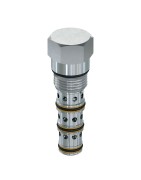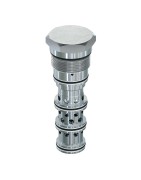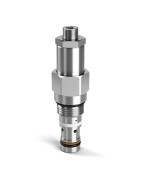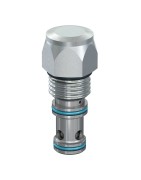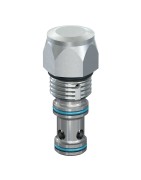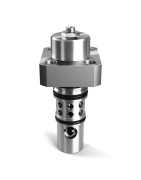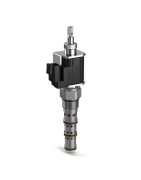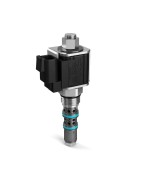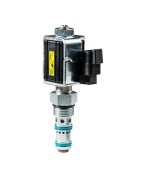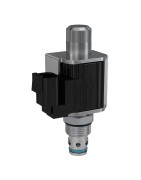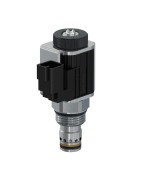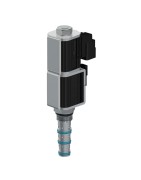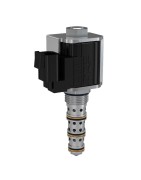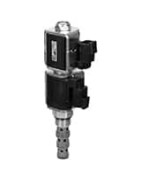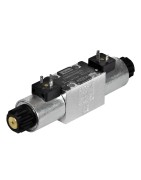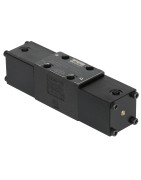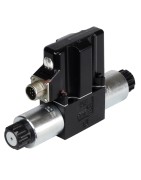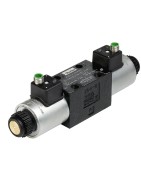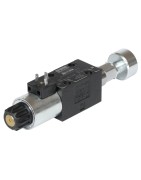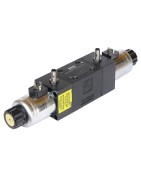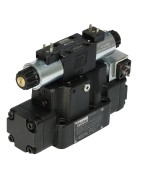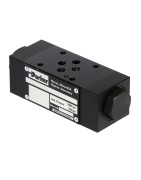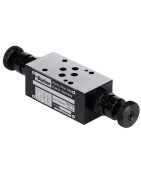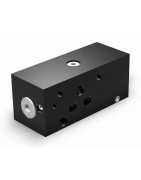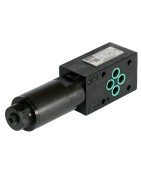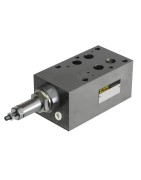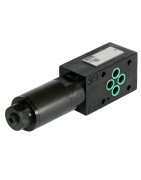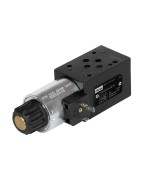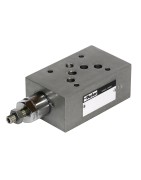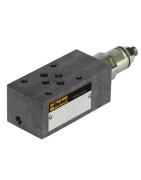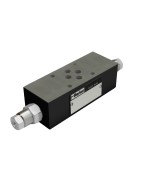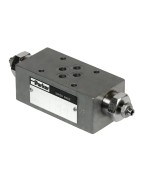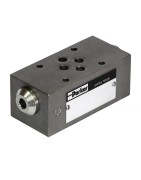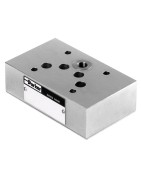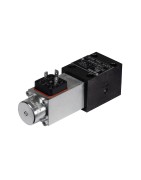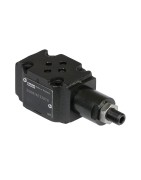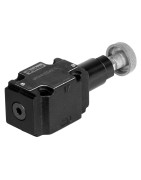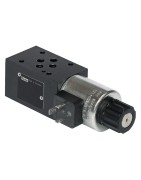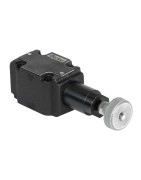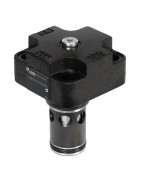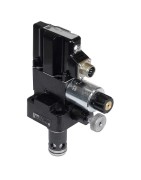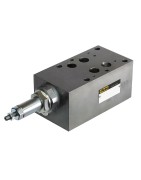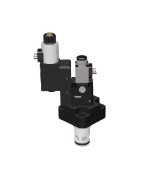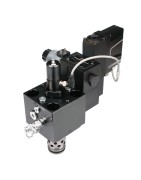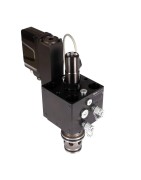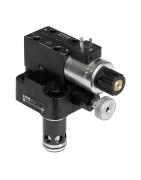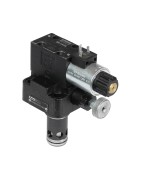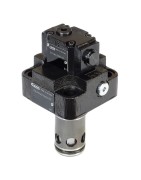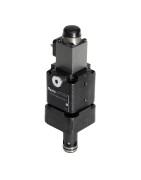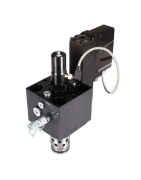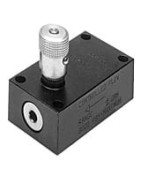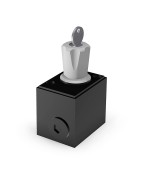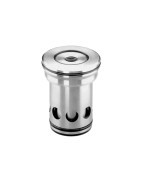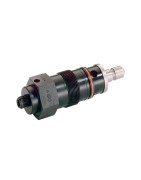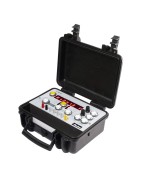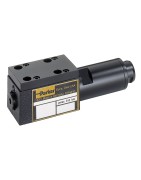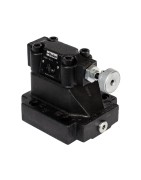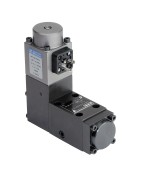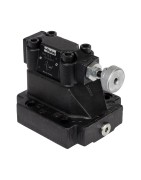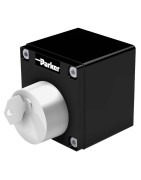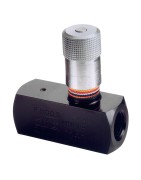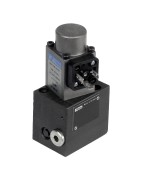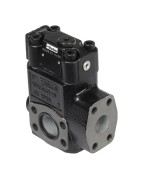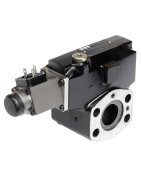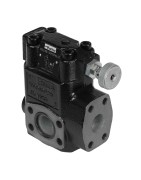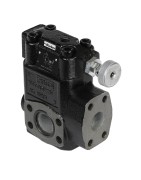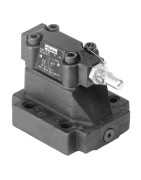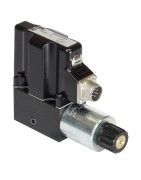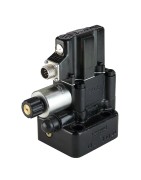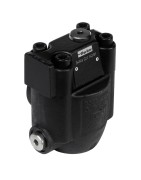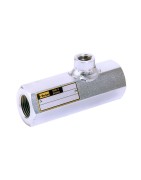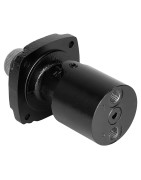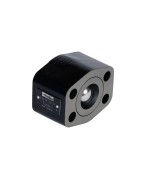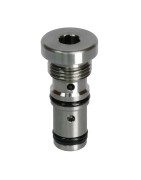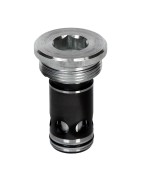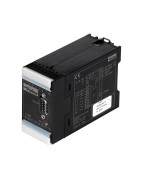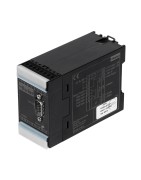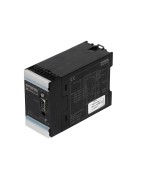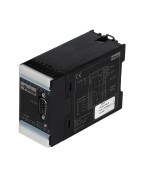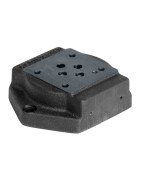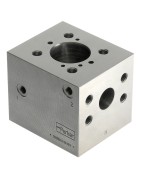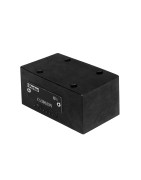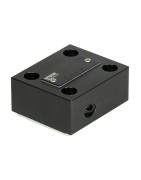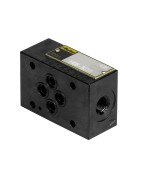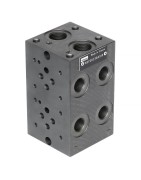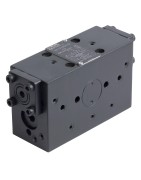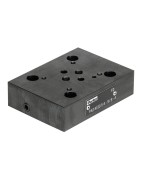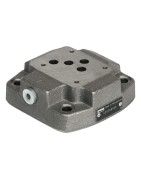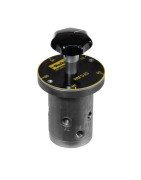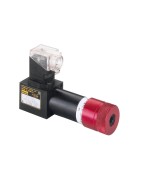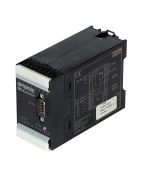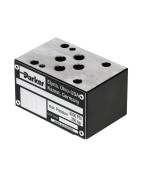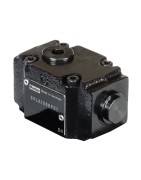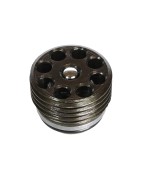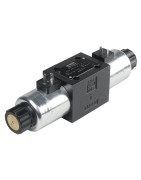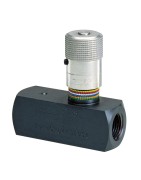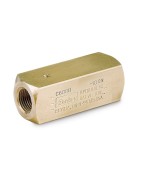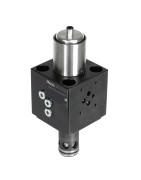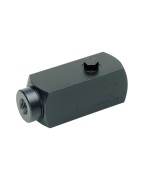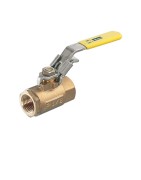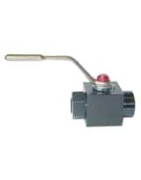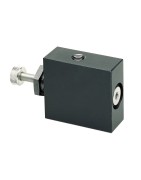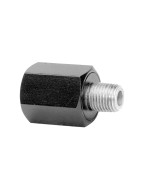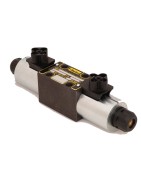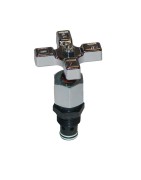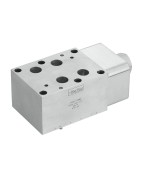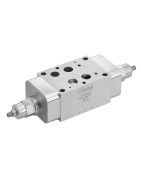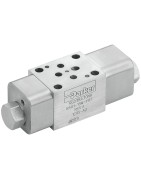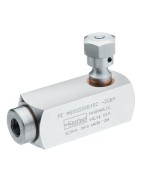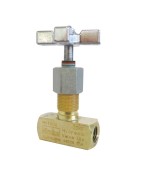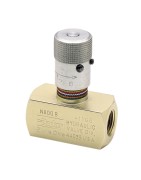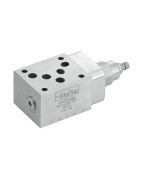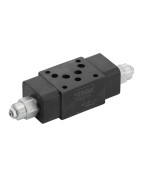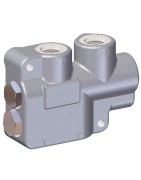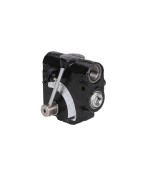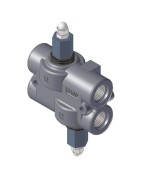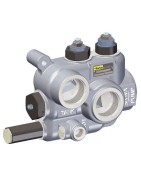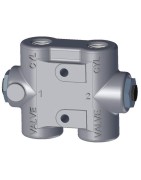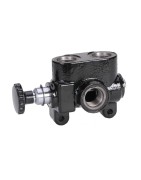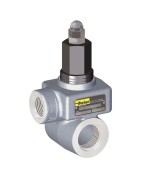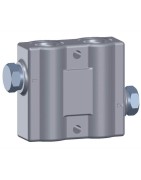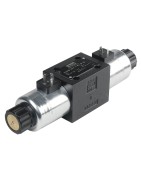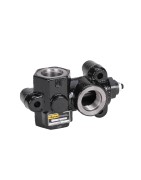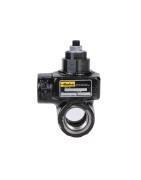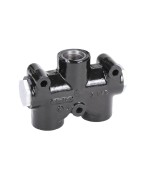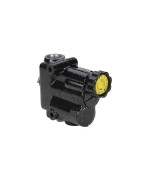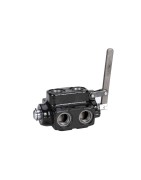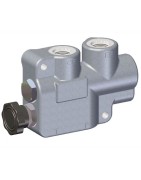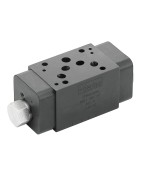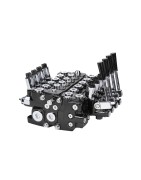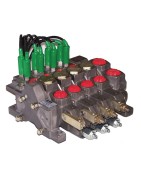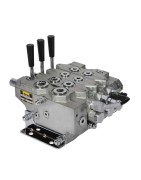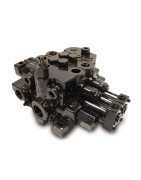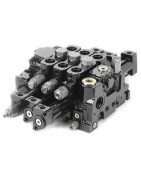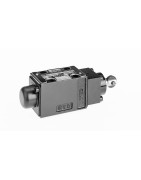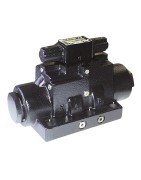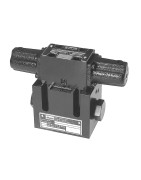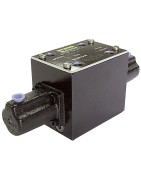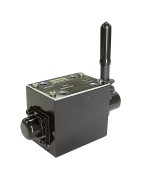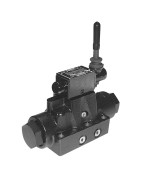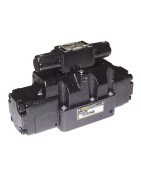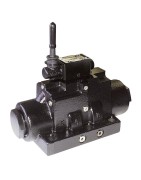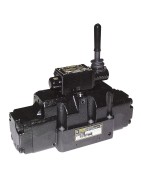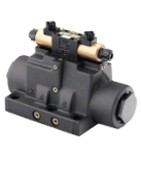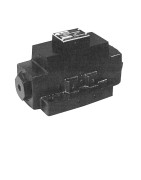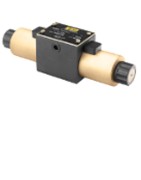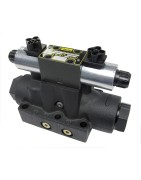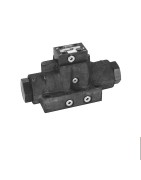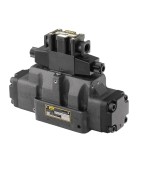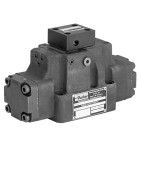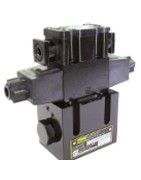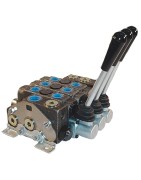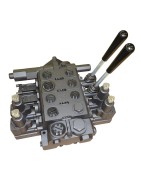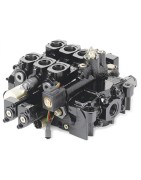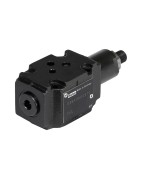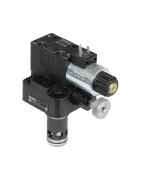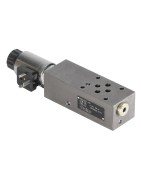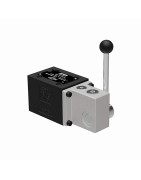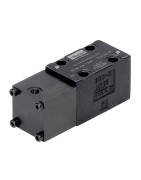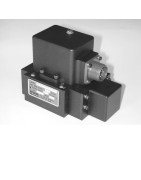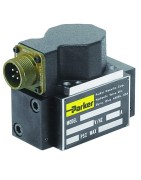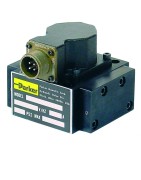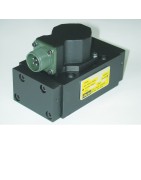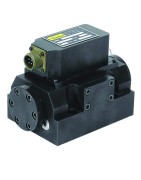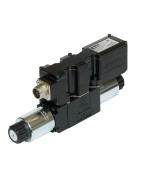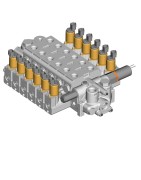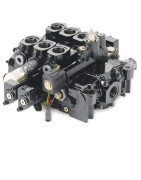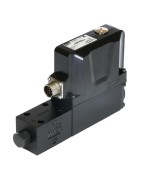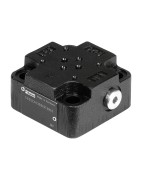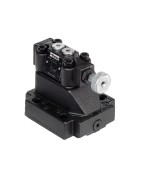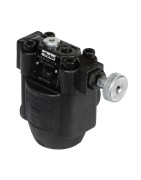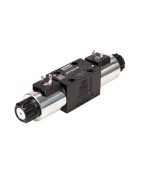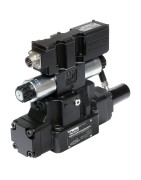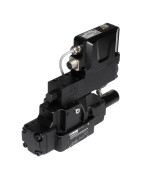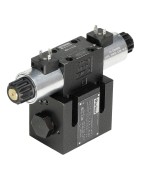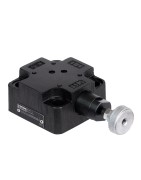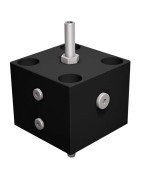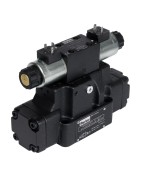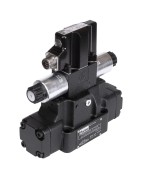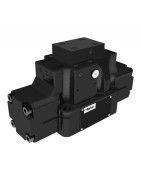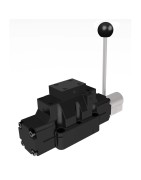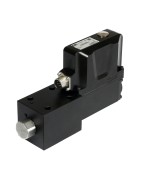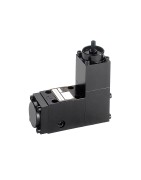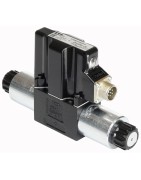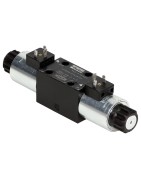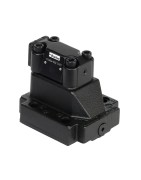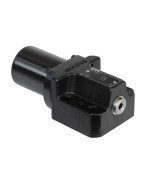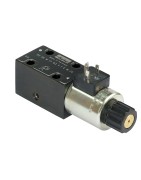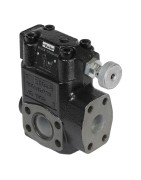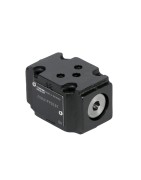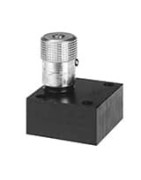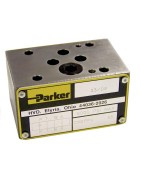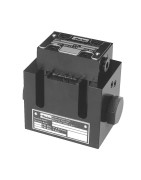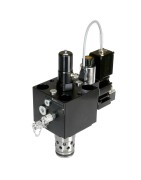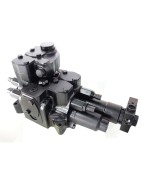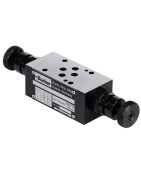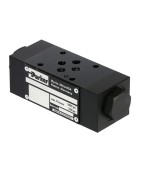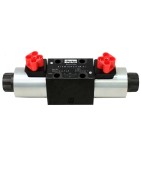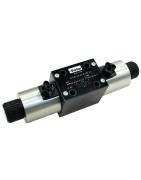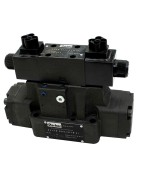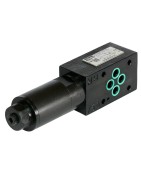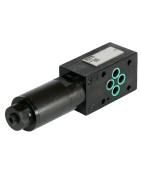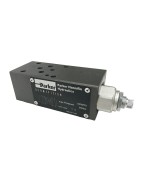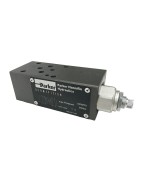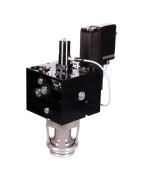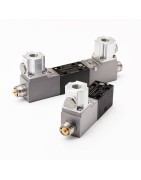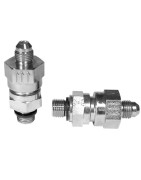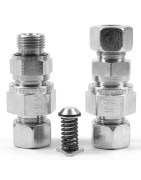Zawory hydrauliczne
Firma Parker oferuje zawory hydrauliczne, które umożliwiają i usprawniają pracę maszyn przemysłowych i sprzętu mobilnego. Dostarczamy innowacyjne komponenty i kompletne systemy odbiorcom na całym świecie, współpracując z klientami w celu po
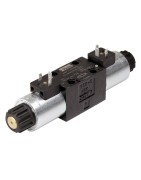
-
PRS6 Pressure reducing valve
The PRS6 is a 3-way pressure reducing valve for hydraulic circuits. The valve maintains the secondary pressure setting constantly, regardless of pressure variations on the primary side. -
QDS6 Sequence valve, 3-way
The QDS6 sequence valve is designed to open or close a hydraulic pilot signal when it reaches a predetermind pressure level. The QDS6 is a 3-way, pilot operated valve. Its directional function can be normally open or normally closed. -
VV6 Hydraulic shuttle valve
The VV6 The valve consists of a housing, a poppet and two valve seats. It has two inlets and one outlet.
The pressure differential that arises when oil flows through the valve pushes the poppet to the opposite inlet and blocks it, at the same time as the outlet is opened.
The valve can only be used with the direction of flow going from the inlets to the outlet. -
2-drogowy, dwukierunkowy zawór elektromagnetyczny typu...
2-drogowe, dwukierunkowe, grzybkowe zawory elektromagnetyczne firmy Parker mają sprawdzoną konstrukcję, która zapewnia bardzo niski poziom wycieków, gdy przepływ jest blokowany w dwóch kierunkach oraz zminimalizowany spadek ciśnienia w pozycji przepływu swobodnego. Zawory mogą pracować w układach hydraulicznych o natężeniu przepływu do 285 l/min i ciśnieniu do 350 barów w konfiguracjach normalnie otwartych lub normalnie zamkniętych. Niektóre 2-drogowe, dwukierunkowe, grzybkowe zawory elektromagnetyczne firmy Parker mają wbudowane odciążenia termiczne ustawione na 36 barów, ale wszystkie idealnie nadają się do zastosowań związanych z odciążaniem lub utrzymywaniem obciążenia, które wymagają niskiego poziomu wycieków zapewnianego przez rozwiązania typu grzybkowego przeznaczone na rynki urządzeń mobilnych, przemysłowych lub produkcyjnych.
Rynki:
• Przemysł
• Produkcja
• Urządzenia mobilne
Cechy/zalety:
• Krótki czas reakcji
• Jednoczęściowa obudowa kartridżu.
• Dostępne wbudowane odciążenie termiczne.
• Wszystkie części zewnętrzne ocynkowane.
Zastosowania:
• Zastosowania z blokowaniem w dwóch kierunkach
• Obwody odciążające
• Utrzymywanie obciążenia
• Układy podnoszenia
Dodatkowe informacje techniczne:
2-drogowe zawory grzybkowe firmy Parker to zawory elektromagnetyczne sterowane pośrednio o niskim poziomie wycieków. Podobnie jak zawory zwrotne, zawory te blokują przepływ w jednym kierunku przy bardzo małych przeciekach (5 kropli na minutę lub mniej). Po aktywacji zawory te umożliwiają przepływ. Zawory te są zazwyczaj wybierane ze względu na ich niski stopień przecieków oraz możliwość stosowania do wyższych przepływów. Zawory grzybkowe są często stosowane razem z siłownikami jednostronnego działania lub w funkcji odciążania. Są one dostępne w wersjach normalnie zamkniętej i normalnie otwartej oraz w wersjach o krótkim czasie reakcji.
Dwudrogowe, dwupołożeniowe zawory grzybkowe firmy Parker składają się z grzybka głównego, grzybka pilotującego, sprężyny i cewki elektromagnesu.
Wersja normalnie zamknięta tych zaworów grzybkowych działa jako zawór zwrotny, gdy elektromagnes nie jest zasilany. Blokuje przepływ w jednym kierunku, umożliwiając przepływ w kierunku przeciwnym Po włączeniu zasilania cewki grzybek jest sterowany do pozycji otwartej (podnosi się) i umożliwia swobodny przepływ w uprzednio zablokowanym kierunku, zwykle w kierunku od strony bocznej zaworu do jego końcówki.
W przypadku wersji normalnie otwartej tych zaworów grzybkowych, po wyłączeniu zasilania cewki możliwy jest swobodny przepływ z bocznego przyłącza zaworu (przyłącze 2) do końcówki zaworu (przyłącze 1). Włączenie zasilania cewki powoduje przesunięcie grzybka i zablokowanie przepływu w kierunku 2 do 1.
Zasada działania: normalnie zamknięty zawór grzybkowy utrzymywany jest w gnieździe przez sprężynę, blokując przepływ pilotowy. Dzięki temu ciśnienie na przyłączu wlotowym (przyłącze 2) może utrzymać grzybek w gnieździe, uniemożliwiając przepływ przez zawór (od przyłącza 2 do przyłącza 1).
Jeśli ciśnienie na końcówce kartridżu (przyłącze 1) jest wystarczające, aby pokonać siłę sprężyny i wypchnąć grzybek z gniazda, możliwy będzie przepływ przez przyłącze 1 do przyłącza 2. Po włączeniu zasilania cewki grzybek sterujący jest podnoszony z gniazda, uwalniając ciśnienie wewnątrz grzybka do przyłącza 1. Powoduje to nierównowagę ciśnienia na grzybku głównym, a w konsekwencji jego podniesienie i umożliwienie przepływu z boku na końcówkę (z 2 do 1). Ponieważ zawory te są sterowane pośrednio, konieczna jest minimalna różnica ciśnień (25–50 psi) oraz przepływ między przyłączami 2 i 1, aby pokonać siłę sprężyny i podnieść grzybek.
Pilot zaworu normalnie otwartego jest utrzymywany poza gniazdem przez siłę sprężyny. Pilot jest drenowany do przyłącza 1, powodując niezrównoważenie ciśnienia, które sprawia, że grzybek główny się porusza. Ta różnica powoduje podniesienie grzybka, umożliwiając przepływ z boku zaworu na jego końcówkę (z 2 do 1). Zawory grzybkowe są sterowane pośrednio, więc minimalna różnica ciśnienia (25–50 psi) między przyłączami 2 powoduje pokonanie siły sprężyny i przemieszczenie pilota zaworu i grzybka głównego do ich gniazd, blokując w ten sposób przepływ z przyłącza 2 do 1. Jeśli występuje ciśnienie na końcówce kartridżu (przyłącze 1), pokonuje ono siłę sprężyny i siłę elektromagnesu, wypychając grzybek z gniazda i umożliwiając ograniczony przepływ przez nabój (z 1 do 2). -
Pilot Operated Pressure Reducing Valves
Pilot operated pressure reducing valves are designed for continuous duty applications. Due to their stability and low pressure rise, the pilot operated pressure reducing valves are the best option for setting the pressure of a hydraulic system sub-circuit.
• Spool design provides low hysteresis
• Low parasitic loss
• High pressure capable
• Multiple pressure ranges available for more accurate pressure control
• Adjustable and tamperproof versions available
• All external parts zinc plated
• Hardened, precision ground parts for durability
• “D”-Ring seal standard on Winner's Circle
• Low profile adapter for minimal space requirements
Common circuit applications include: brake release, dual pressure circuits, pilot pressure control and downstream pressure control. -
Direct Acting Pressure Reducing Relieving Valves
Direct Acting Reducing/Relieving valves are applied in a circuit in order to reduce system pressure to the setting of valve to limit the pressure available to a specific branch of a hydraulic circuit. The direct acting function of the normally open valve allows the spool to operate directly against a control spring that is set using the valves internal adjustment setting. As hydraulic pressure is applied to the valve inlet, the spool will shift closed against the spring to limit the pressure that is available to the regulated port to the control setting. The valve will also function as a relief valve to the regulated port in the event of a rise in downstream pressure, protecting the regulated branch of the circuit from pressure spikes. Direct acting reducing/relieving valves are intended or intermittent duty applications with lower duty cycles that will not stress the mechanical operation of the valve. For best performance in the direct acting reducing/relieving valve, the inlet pressure setting should not exceed 1000 PSI (69 Bar) above the reducing valve setting, as high pressure differential could result in instability in the direct acting product. For continuous duty applications or applications where a high differential is required, the pilot operated version of this product should be considered as an alternative solution.
Typical applications are in mobile & industrial equipment, where a branch of the system is intended to operate at a lower setting than high system pressure. Hydraulic functions such as brake circuits, clamping or clutch circuits, suspension systems, street sweepers, or seeding and planting rows in agricultural equipment are common applications for these products.
• Hardened, precision ground parts for durability
• All External parts zinc plated
• Adjustable and tamperproof versions available
• Multiple pressure ranges available for more accurate pressure control -
Zawory redukcyjne i odciążające sterowane pośrednio
Rodzina sterowanych pośrednio zaworów redukcyjnych i odciążających firmy Parker zapewnia doskonałą regulację ciśnienia w zastosowaniach, w których potrzebne jest konkretne ciśnienie regulowane lub otwarcia w celu zapewnienia precyzyjnego działania funkcji wymagających regulowanego ciśnienia do 380 barów (5500 psi) i natężenia przepływu do 150 l/min (40 gal/min). Sterowane pośrednio zawory redukcyjno-odciążające firmy Parker zaprojektowano do kilku zakresów ciśnień, aby zapewnić wyższy stopień kontroli dzięki różnym dostępnym sposobom regulacji. Dodatkowa stabilność uzyskana dzięki sterowaniu pośredniemu sprawia, że zawory te doskonale się nadają do obsługi wrażliwych funkcji, takich jak podnoszenie lub docisk, zaciskanie lub hamowanie w różnych typach maszyn na rynkach mobilnym i przemysłowym.
Rynki:
• Rolnictwo
• Sprzęt budowlany
• Przemysł
• Produkcja
• Urządzenia mobilne
Cechy/zalety:
• Dostępność wielu zakresów ciśnień pozwala na dokładniejszą regulację ciśnienia.
• Kompaktowe rozmiary ograniczają wymagania przestrzenne
• Dostępne wersje regulowane i odporne na ingerencję.
• Możliwość pracy pod wysokim ciśnieniem.
• Wszystkie części zewnętrzne ocynkowane.
Zastosowania:
• Hamulce
• Opaski zaciskowe
• Układy zawieszenia
• Układy podnoszenia/docisku
Dodatkowe informacje techniczne:
Typowe zastosowania to urządzenia mobilne i przemysłowe, w których gałąź układu ma działać przy ustawieniu niższym niż wysokie ciśnienie układu. Funkcje hydrauliczne, takie jak obwody hamulcowe, obwody zaciskowe lub sprzęgła, układy zawieszenia, zamiatarki uliczne, lub rzędy siewu i sadzenia w sprzęcie rolniczym są typowymi zastosowaniami tych produktów. -
Pilot Operated Ventable Relief Valves
Ventable relief valves are pilot operated, spool type pressure controls. Like other pilot operated relief valves, the ventable relief has a main pilot spring chamber, and a bias spring chamber separated by a pilot orifice. The internal adjustment controls the main pilot spring setting. When pressure in the system builds above the setting of the main pilot setting, the pilot seat will lift allowing the spool to travel to the open position passing flow. What makes ventable relief valves unique is the valve offers an isolated vent chamber that is connected to the bias spring chamber. This allows for the valve to open at a lower pressure than the setting of the main spring.
The circuit designer has the ability to apply an external control valve or valves to set the operating pressure of the bias spring that must be overcome to allow the valve to open. This is an ideal solution in applications that may require variable pressure settings in normal operation.
One must consider the leakage component when applying any pilot operated spool type relief valve, as by design, the spool will pass a small leakage flow.
Typical applications are in mobile & industrial equipment, where multiple pressure settings may be required. Applications such as press or lift circuits where multiple pressure settings may be required.
• High flow capacity
• Full tank line back pressure capability
• Excellent flow pressure characteristics for consistent pressure setting
• Ideal for pump relief and remote control or unloading via vent (port 3)
• Integral 250 micron pilot flow filter
• Hardened working parts for maximum durability
• Adjustable and tamperproof versions available
• All external parts zinc plated
• Low override curve
• Ball-type pilot for added stability
• High accuracy - pilot operated design
• Hardened, precision ground parts for durability
• Compact size for reduced space requirements
• All external parts have yellow zinc dichromate. This coating is ideal for salt spray applications. -
Direct Acting Differential Area Relief Valves
Parker Hannifin's RD and RDH line of differential area relief valves provide excellent pressure control in applications where a fast acting, low leakage relief valve is necessary. Parker's family of differential relief valves are available in three sizes (size -08, -10, and -16) with flow capability of up to 40 gpm. The size -16 family is limited to 3500 psi while the rest of the family is capable of 5500 psi. Unlike the direct acting family of relief valves, Parker's differential area relief valves are designed to have the pressure controlled at port 2 of the cavity. This ensures low leakage across the valve, essential in some holding applications. Designed using industry common cavities, the RD and RDH line of reliefs can easily be used in various system applications with ease.
Industries where commonly found:
• Turf
• Agriculture
• Aerial
• Construction
• Mining
• Industrial
• Truck -
Zawory nadmiarowe sterowane pośrednio
Zawory nadmiarowe sterowane pośrednio firmy Parker cechują się stabilną konstrukcją o małym spadku ciśnienia. Przeznaczone są do zastosowań ciągłych przy pracy o niższym poziomie hałasu hydraulicznego. Zawory mają niezawodną i kompaktową konstrukcję i mogą pracować przy ciśnieniu do 420 barów (6000 psi) i natężeniu przepływu do 400 l/min (106 gal/min). Zawory nadmiarowe sterowane pośrednio firmy Parker idealnie nadają się do ograniczania ciśnienia w układzie lub w standardowych zastosowaniach zaworów nadmiarowych w urządzeniach mobilnych i przemysłowych, takich jak urządzenia rolnicze, lotnicze, do przetwarzania odpadów, przemysłowe systemy bloków energetycznych, urządzenia górnicze i inne obwody regulacji ciśnienia płynów przeznaczone do pracy ciężkiej.
Rynki:
• Przemysł
• Produkcja
• Urządzenia mobilne
Cechy/zalety:
• Wysokie ciśnienie i natężenie przepływu.
• Konstrukcje kulowe i grzybkowe o niskim wycieku.
• Kompaktowa konstrukcja.
• Wewnętrzne filtry.
• Hartowane, precyzyjnie szlifowane części zapewnia trwałość
• Wszystkie części zewnętrzne ocynkowane.
Zastosowania:
• Ogranicznik ciśnienia w układzie
• Przyłącze/upust między przyłączami
• Wychylany upust
• Hamowanie silnikiem
Dodatkowe informacje techniczne:
Ta rodzina zaworów najlepiej nadaje się do układów o pracy ciągłej, w których wymagana jest praca zaworu poza okresami użytkowania przerywanego. Mogą być używane do utrzymywania ciśnienia w układzie przez długi czas. Dodatkowo w systemach, w których mogą występować duże szybkości zmian przepływu, zawory sterowane pośrednio mogą dostosować się do tych zmian bez nadmiernego wzrostu ciśnienia. Ze względu na obszary otwarcia przepływu przez zawór zawory suwakowe będą działać ciszej niż konwencjonalne zawory bezpośredniego działania. Należy również wziąć pod uwagę poziom wycieków, ponieważ suwak ze względu na swoją konstrukcję przepuszcza niewielki wyciek, natomiast zawór bezpośredniego działania nie przepuszcza znaczącego przepływu do momentu osiągnięcia ciśnienia otwarcia. Suwakowych zaworów nadmiarowych nie należy używać do utrzymywania obciążenia. -
Unloading Relief Valves
Parker’s RU101 and M04A4J offer design flexibility by allowing the use of hydraulic components to automatically control pump flow to one or more accumulators. These are low flow pilot valves that can be used to control higher pump flows in fixed displacement or load sense systems.
The RU101 is externally piloted and rated for flows up to 1 GPM and pressures up to 3000 psi. It is typically used with fixed displacement pumps and can directly unload flows up to 1 GPM or be used to pilot a logic element to unload higher pump flows. Once the accumulators are charged to the adjustable or factory preset maximum pressure, the pump will automatically unload back to tank. Due to the differential area design, when the pressure drops to 80% of the RU101 maximum setting, the unloading valve will direct pump flow to the accumulators for recharging.
The M04A4J is internally piloted and is rated for flows up to .53 GPM and pressures as high as 6000 psi. It is typically used with load sense pumps to control accumulator charging. When the accumulators are charged to the unload pressure, the pump’s load sense port is directed to tank allowing the pump to go to its standby pressure. Once the accumulator pressure falls to the M04A4J reload pressure, the pump’s load sense port is fed the accumulator pressure and the pump comes on stroke to charge the accumulator back up to the unload pressure. Controlling only the pump load sense signal allows a small cartridge valve to control a wide range of flows from small to larger displacement load sense pumps.
Parker’s unloading pressure control valves offer design flexibility by allowing in-line mounting with standard line bodies, or integration into more complex custom manifolds. They can also be combined with K04G3 shuttles for use in critical applications that require redundant accumulators such as braking and steering. By hydraulically controlling pump unloading for accumulator charging, there may be no need for solenoid valves, pressure sensors, electronic controls, and the associated wiring. Combining the features of the RU101 or M04A4J with the many other products offered by Parker’s Hydraulic Cartridge Division allows for application specific solutions for some of the most demanding applications, including: Construction, Mining, Industrial Power Units, Oil and Gas, Marine, Material Handling. -
Zawory nadmiarowe bezpośredniego działania
Zawory nadmiarowe bezpośredniego działania firmy Parker działają szybko i przeznaczone są do zastosowań ciągłych przy ciśnieniu do 420 barów (6000 psi) i natężeniu przepływu do 200 l/min (53 gal/min) w różnych rozmiarach gniazda. Dzięki różnorodnym dostępnym rodzajom regulacji ciśnienia stanowią ekonomiczne rozwiązanie do obcinania skoków ciśnienia i w razie potrzeby mogą obsługiwać natężenie przepływu całego układu. Zawory grzybkowe bezpośredniego działania mają gniazda o niskim poziomie wycieków i doskonale odciążają przyłącza w zastosowaniach związanych ze sterowaniem siłownikami. Małe zawory bezpośredniego działania firmy Parker o niskim natężeniu przepływu sprawdzają się dobrze podczas sterowania obwodami pilotowymi lub ograniczania ciśnienia wykrywania obciążenia.
Rynki:
• Przemysł
• Produkcja
• Urządzenia mobilne
Cechy/zalety:
• Hartowane, precyzyjnie szlifowane części zapewnia trwałość
• Kompaktowe rozmiary ograniczają wymagania przestrzenne
• Dostępna konstrukcja zaworu grzybkowego o niskim poziomie wycieków.
• Krótki czas reakcji
• Wszystkie części zewnętrzne ocynkowane.
• W niektórych modelach dostępna jest wersja wysokociśnieniowa (6000 psi).
• Dostępne wersje regulowane, stałe lub odporne na ingerencję,
• Wiele dostępnych zakresów sprężyn.
• Wszystkie zawory są w pełni przetestowane.
Zastosowania:
• Przyłącze/upust między przyłączami
• Odciążanie układu
• Odciążanie ciśnienia sterującego i/lub wykrywania obciążenia
• Hamowanie
Dodatkowe informacje techniczne:
Pełnoprzepływowe zawory nadmiarowe bezpośredniego działania mogą być używane jako główne zawory nadmiarowe w obwodach o małym przepływie. Zawory bezpośredniego działania reagują szybko, dlatego mogą być ekonomicznym rozwiązaniem do obcinania skoków ciśnienia. Zawory grzybkowe bezpośredniego działania mają gniazda o niskim poziomie wycieków i często wykorzystywane są do odciążania przyłączy w zastosowaniach związanych ze sterowaniem siłownikami. Małe zawory bezpośredniego działania firmy Parker o małym natężeniu przepływu sprawdzają się doskonale podczas sterowania obwodami pilotowymi lub ograniczania ciśnienia wykrywania obciążenia. -
Pilot Operated Relief Valve with Free Reverse Check
Pilot operated relief valves are designed for continuous duty applications. Due to their stability and low pressure rise, the pilot operated relief is the best option for setting the pressure of a hydraulic system. The pilot operated valves will typically have a low pressure rise and will operate with less hydraulic noise. This particular model of spool type pilot operated valve has a reverse check. This allows flow to pass in the opposite direction, port 2 to 1. This may be advantageous in an anti-cavitation application, or where reverse flow needs to be accommodated.
Pilot operated relief valves are available is -08 to -20 size cavity configurations. This family of valves is best suited for continuous duty systems where the valve is asked to operate beyond any intermittent use. They can be used to maintain system pressure for long periods of time. Additionally, where systems may have large rates of change in flow, the pilot operated valves can accommodate these changes without excessive pressure rise or sometimes called pressure override. Due to the flow opening areas through the valve, these spool type valves will operate more quietly than a conventional direct acting valve. One must also consider the leakage component as the spool is, by design, going to pass a small leakage flow, whereas a direct acting valve does not pass significant flow until the cracking pressure is reached.
Typical applications are in mobile equipment, such as agricultural machines, aerial equipment, refuse vehicles, industrial power unit systems, mining equipment, and other heavy duty fluid power pressure control circuits. -
Zawory przełączające bezpośredniego działania
Rodzina przełączających zaworów nadmiarowych bezpośredniego działania firmy Parker charakteryzuje się niskim poziomem wycieków i szybko działającą konstrukcją, która zabezpiecza przed nadmierną zmianą ciśnienia siłowniki dwustronnego działania, siłowniki obrotowe i silniki. Zawory te mogą pracować przy natężeniu przepływu w układzie hydraulicznym do 120 l/min (32 gal/min) i ciśnieniu do 350 barów (5000 psi) z różnymi nastawami ciśnienia i opcjami regulacji. Przełączające zawory nadmiarowe bezpośredniego działania firmy Parker idealnie nadają się do zastosowań, w których wymagane jest zabezpieczenie przed nadmierną zmianą ciśnienia w obu kierunkach obrotowych lub liniowych urządzeń hydraulicznych w sprzęcie mobilnym, przemysłowym lub produkcyjnym.
Rynki:
• Przemysł
• Produkcja
• Urządzenia mobilne
Cechy/zalety:
• Szybko działające różnicowe zawory nadmiarowe pozwalają na wysokie natężenie przepływu.
• Niski poziom wycieków dzięki kulistym grzybkom.
• Mechaniczne ograniczniki eliminują sztywnienie sprężyny.
• Wszystkie części zewnętrzne ocynkowane.
Zastosowania:
• Odciążenie przyłącza
• Wychylany upust
• Hamowanie silnikiem
• Instalacje wymagające odciążania przyłączy
Dodatkowe informacje techniczne:
Podwójne przełączające zawory nadmiarowe, często określane jako odciążenia przyłączy, zabezpieczają siłowniki hydrauliczne dwustronnego działania przed nadmierną zmianą ciśnienia. Zwykle używane są z siłownikami o równych powierzchniach roboczych, m.in. z silnikami, siłownikami z dwustronnym tłoczyskiem i siłownikami obrotowymi. Zapewnienie odciążenia na obu liniach siłownika pomaga zapobiegać ewentualnym uszkodzeniom w wyniku skoków ciśnienia lub braku przepływu w obu kierunkach działania.
Przełączające zawory nadmiarowe ze wspólnym wpustem serii XR101 i A04J2 firmy Parker zabezpieczają siłownik przed nadmierną zmianą ciśnienia w obu kierunkach za pomocą pojedynczego zaworu nabojowego. Mogą być montowane w linii ze standardowymi korpusami do montażu w linii lub wbudowane w niestandardowe bloki zaworowe. Połączenie dwóch funkcji odciążania w jednym kartridżu zmniejsza liczbę komponentów, zajmowaną przestrzeń i koszty.
W przełączających zaworach nadmiarowych serii XRDH firmy Parker wykorzystywane są dwa różnicowe zawory nadmiarowe połączone w jednym korpusie. Zastosowanie dwóch kartridżów pozwala na większe natężenia przepływu przy mniejszych spadkach ciśnienia i mniejszym wzroście ciśnienia. Dostępne są standardowe opcje katalogowe do montażu w linii lub bezpośrednio na silniku. W przypadku serii XRDH103 do montażu na silniku funkcje odciążania znajdują się bezpośrednio na przyłączach silnika, co skraca czas reakcji na nagły spadek ciśnienia, a także ogranicza czynności związane z instalacją hydrauliczną w porównaniu z przełączającymi zaworami nadmiarowymi montowanymi w linii. Seria XRDH103 przeznaczona jest do użytku z silnikami Parker TB i TE o niskiej prędkości i wysokim momencie obrotowym (LSHT). Inne opcje montażu na silniku są dostępne na zamówienie.
Skontaktuj się z nami, jeśli masz pytania lub w przypadku instalacji z przełączającym zaworem nadmiarowym wymagającej wyższego natężenia przepływu i ciśnienia. -
Pilot Operated Sequence Valve with Kickdown
Unlike relief valves which will reset slightly below their pressure setting, Parker’s B04C3 Kick-Down sequence valve will continue to unload pump flow until its supply flow is completely stopped. Two adjustable pressure ranges are standard for 3000 or 6000 PSI maximum operating pressures, and each version is capable of flows up to 42 GPM. Screw, knob, and tamper-resistant adjustment options are available.
B04C3 pilot operated cartridges are normally closed, internally piloted and externally drained. The external drain prevents downstream pressure from having an effect on the valve setting. When inlet pressure at port 1 is lower than the valve’s setting, flow is not allowed to exit port 2. Once the pressure setting is reached, flow from port 1 is unloaded to port 2. The valve does not reset and close until flow is completely removed from port 1. Staying open after the setting is reached creates a requirement for an operator or the system controls to take steps of removing flow before the valve can stop unloading the pump. Functioning in a manner similar to a fuse can provide additional over-pressurization protection and can also help to detect unusual high pressure machine conditions.
Typical Applications include: Machine Tool, Power Units, Presses, Clamping, Forging, Construction, Material Handling -
Pilot Operated Sequence Valve with Reverse Check
B04D3 is an internally piloted and externally drained sequence valve with an integrated reverse free flow check valve. When pressure is below the sequence setting the valve is normally closed. Once the pressure setting is reached the valve is internally piloted open allowing flow to a secondary branch of the circuit. Flow from the secondary branch is allowed to free flow back to the primary branch via the reverse flow check. The external drain should be plumbed directly back to tank to prevent downstream pressure from adding to the sequence setting. Two adjustable pressure ranges are standard for 3000 or 6000 PSI maximum operating pressures, and each version is capable of flows up to 32 GPM. Screw, knob, and tamper-resistant adjustment options are available.
Combining a sequencing function and reverse flow check into a single size 10 cartridge reduces manifold space, complexity and the number of components. The integrated check valve reduces internal drillings and can also allow for multiple double acting functions to be operated with a single directional control valve. Parker’s B04D3 offers design flexibility that can be utilized an many applications including: Clamp and Drill, Machine Tools, Presses, Power Units, Material Handling, Construction, Agriculture, -
Standardowe zawory zwrotne
Solidne grzybkowe i kulowe zawory zwrotne firmy Parker przeznaczone są do najbardziej wymagających zastosowań przy natężeniu przepływu do 303 l/min (80 gal/min) i ciśnieniu do 420 barów (6000 psi) na wielu rynkach, takich jak rolnictwo, budownictwo i produkcja przemysłowa. Zawory mają hartowaną grzybkową lub kulową konstrukcję z gniazdem, która utrzymuje stopień wycieków na poziomie zaledwie 5 kropli na minutę lub mniej, jednocześnie wydłużając okres eksploatacji dzięki ulepszonej charakterystyce zużycia. Ponadto szeroki wybór dostępnych ciśnień otwarcia zapewnia łatwą integrację z układem i niezawodne działanie.
Rynki:
• Rolnictwo
• Sprzęt budowlany
• Sprzęt do transportu materiałów
• Przemysł
• Produkcja
• Urządzenia mobilne
Cechy/zalety:
• Szeroki zakres rozmiarów korpusów, ciśnień zadziałania i natężeń przepływu.
• Niski stopień wycieków — mniej niż 5 kropli na minutę.
• Prosta konstrukcja — wyjątkowa opłacalność.
• Wysoka tolerancja na zanieczyszczenia.
• Wszystkie części zewnętrzne ocynkowane.
Zastosowania:
• Utrzymywanie obciążenia
• Izolacja komponentów
• Zapobieganie przepływowi wstecznemu
• Ochrona antykawitacyjna
• Rynki, na których problemem jest czystość
Dodatkowe informacje techniczne:
Konstrukcja kulowych zaworów zwrotnych firmy Parker obejmuje kulę dociskaną do gniazda przez sprężynę. Blokuje to przepływ w jednym kierunku, ale umożliwia przepływ w kierunku przeciwnym, gdy ciśnienie jest wystarczająco wysokie, aby unieść kulę z gniazda. Ciśnienie, przy którym dozwolony jest przepływ wsteczny, nazywa się ciśnieniem otwarcia. Dzięki zastosowaniu hartowanej kuli i wykańczanego gniazda poziom wycieków wynosi mniej niż 5 kropli na minutę w kierunku blokowania. -
Single Pilot Operated, Pilot to Open Check Valves
Parker’s reliable pilot piston style P.O. check valves are designed for critical applications where safety and load holding is required and flows from 19 to 150 lpm (5 to 40 gpm) and pressures up to 420 bar (6,000 psi) are needed. These valves are available with pilot supply to either the 1st port or 3rd port depending on circuit need, and are generally used in conjunction with linear actuators across several markets within mobile or industrial hydraulics, such as aerials, material handling, and construction where durable and low leak valves are necessary to keep the machinery and operators safe.
Markets:
• Aerial
• Construction
• Material Handling
• Miscellaneous Mobile
Features/Benefits:
• Spherical poppet for low leakage
• Hardened precision ground parts for durability
• “D”-Ring design eliminates back-up rings
• Optional sealed pilot piston
Applications:
• Load holding without fine metering
Additional Technical Insight:
Pilot operated check valves, also known as P.O. checks, are used to lock a cylinder in a holding position with minimal leakage or drift. P.O. check valves that can be opened to allow flow in the reverse direction with an external signal to the pilot port. The valves work best when used in conjunction with a control valve that vents the valve ports to tank when centered. Pilot pressure to open the checks for reverse flow is a ratio of the holding pressure, and are typically 3:1 or 4:1. A 3:1 ratio with a 3000psi load requires a 1000psi signal to the pilot port. -
Cartridge Style Dual Pilot Operated Check Valves
The CPD084P rated at 3000 PSI with a flow rating of up to 5 GPM. The integrated pilot piston has a 3:1 pilot ratio. At rest the internal checks remain seated, blocking flow from exiting the cylinder and locking the cylinder in place. When pressure is applied to either valve port, the check valve will open allowing free flow from the inlet to the actuator port across the check valve. As pressure is applied to shift the cylinder, the internal piston will also shift to mechanically shift open the flow path across the opposite check valve, allowing flow to pass back across the valve in the return direction.
These valves are ideal for load holding applications, where metering conditions are not required. -
Cartridge Spool Type Inverse Shuttle Valves
Parker’s K04G3 shuttle is typically used mobile braking circuits where two accumulators are used. It serves two functions: Ensuring that the accumulators are charged equally and at the same rate, and as a guard against pressure loss should one of the accumulators fail. Connected to the main supply source, the K04G3 will divide flow between two hydraulic accumulators and charge them to be used as an auxiliary source of power for braking circuits. Used in conjunction with a check valve and unloading valve (Parker RU101), the accumulators charge to a preset pressure and will unload the charge pump, or divert flow to other parts of the system. In the event one of the accumulators fail, the K04G3 valve will shift to protect the good one. Parker’s K04G3 is rated for 30 LPM (7.9 GPM) and up to 350 Bar (5000 PSI). -
Cartridge Spool Type Shuttle Valves with All Ports Closed
In closed loop hydrostatic transmission systems, it is often necessary to bleed off some of the oil from the circuit and replace it with cool, clean oil from a charge replenishing pump. The hot oil is typically routed through a filter and cooler before returning to the reservoir. System designers use a hot oil shuttle valve to achieve this. Higher pressure fluid from the loop causes the shuttle valve to shift allowing oil from the low pressure side of the loop to be ported out the common port. These valves are usually used in conjunction with a relief valve. Parker’s K04C3 and K3A125 valves are high flow (15 gpm and 28 gpm respectively) with the K04C3 capable of 6000 psi and 5 switching pressures and K3A125 capable of 5000 psi and 2 switching pressures. -
Insert Shuttle Valves
Parker insert shuttle valves are three port devices that consist of two inlet ports and one outlet. The insert feature creates design flexibility and reduces space by allowing the cartridges to be buried inside manifolds. The valves act as resolvers by allowing flow from the inlet port with the highest pressure to be directed to the outlet port. Flow from the lower pressure inlet port is blocked. K2A005 is a robust poppet type shuttle valve capable of flows up to 10GPM and pressures as high as 5000 PSI. KSWA3 utilizes a ball type design and is capable of 2.5GPM flows and pressures up to 6000 psi.
Typical applications include Load Sense and brake release functions and typical markets include Power Units, Agriculture, Construction, Material Handling and Cranes. -
Cartridge Ball Type Shuttle Valve
Shuttle valves accept the flow and pressure from two different sources and direct the highest pressure to a single outlet port. Shuttle valves are typically used in Load Sensing circuits as well as Brake circuits. Parker offers many different types of shuttles, including ball type, spool type, and poppet type. There are a number of configurations available such as cartridge type, insert type, and an in-line version. -
Inline Shuttle Valves
ASH shuttle valves are in-line mounted three port devices that consist of two inlet ports and one outlet. The valves act as resolvers by allowing flow from the inlet port with the highest pressure to be directed to the outlet port. Flow from the lower pressure inlet port is blocked. ASH-06 consists of a steel body with three SAE-6 ports and an internal shuttle ball. ASH-04 is identical in design but adds three JIC port adapters to allow connection to -4 JIC hoses or tube fittings.
Typical applications include Load Sense and brake release functions and typical markets include Power Units, Agriculture, Construction, Material Handling and Cranes. -
Insert Check Valves
Capable of up to 38 gallons per minute, the D1A060 ball type check valve is available in a wide variety of spring sizes from 3 psi to 145 psi. Ii is capable of up to 38 gallons per minute. The D1B125 is capable of up to 132 gallons per minute and has spring sizes from 0 psi to 72 psi. Both of these valves are the perfect solution for high flow, low leakage holding valve applications. -
Pilot Piston Style Dual Pilot Operated Check Valves
Parker’s dual pilot operated check valves are available in pressures up to 5000 PSI and flow rates as high as 50 gallons per minute. The CDP(H) series uses a standard pilot piston and two standard Parker check valves in an assembled body.
At rest the check valves remain seated, blocking flow from entering and exiting the cylinder and locking the cylinder in place. When system pressure is applied to either valve port, the check valve will open allowing free flow from the inlet to the actuator port across the check valve. As pressure builds to shift the cylinder, the internal pilot piston, utilizing a 3:1 or 4:1 ratio, will respond quickly to the system pressure and will shift against the return check. This action mechanically pilots the valve open to allow return flow to pass through the valve from the actuator back to tank. With both ports now open, the valve is unlocked and the hydraulically powered cylinder is free to move. When system pressure is shut off to the valve, the valve will return to the holding condition restricting actuator movement and locking the system in place.
These valves are ideal for load holding applications, where metering conditions are not required. -
Pilot Piston Style Pilot Operated Check Valves
Parker’s single pilot operated (P.O.) check valves are available in pressures up to 5000 PSI and flow rates as high as 50 gallons per minute. The CSP(H) series uses a standard pilot piston and a standard Parker check valve in an assembled body.
At rest the check valve remains seated, blocking flow from exiting the actuator port and locking the circuit in place. When pressure and flow are opened to the valve inlet, the check valve will allow free flow to the actuator. The valve assembly also utilizes an internal pilot piston with a 3:1 or 4:1 ratio. When sufficient pressure is applied to the pilot port, the piston will respond quickly and will shift against the return check. This action mechanically pilots the valve open, unlocking the circuit, to allow return flow to pass through the valve from the actuator back to tank. When system pressure is shut off to the valve, the valve will return to the holding condition restricting actuator movement and locking the system in place.
These valves are ideal for load holding applications, where metering conditions are not required. -
Pilot Operated Sequence Valves
SVH081, SVH101, and SVH161 pilot operated sequence valves are internally piloted and externally drained. All three versions are normally closed spool-type valves that prevent flow from passing through the valve until the adjustable pressure setting is reached. When the inlet pressure exceeds the sequence setting the valve is internally piloted open allowing flow downstream to a secondary function. An external drain port plumbed directly to tank ensures that downstream pressure does not affect the pressure setting. Clamp and machine, or unlock and dump, are typical applications since they require one function to happen before another one.
SVH102 and SVH162 are externally piloted and internally drained sequence valves. Both are normally closed and prevent flow from passing through the valve when the pilot pressure is below the pressure setting. When the external pilot source exceeds the adjustable pressure setting, the valve opens allowing flow to go downstream. Back pressure on the downstream port is added to the valve setting due to the internal drain, therefore it is most common to connect the sequenced port to tank. High-Low Pump Unloading is a common application.
SVCH101 is an inline mounted combination of an internally piloted, externally drained sequence valve and a reverse flow check. An SVH101 sequence valve and a CVH103 check valve are incorporated into a single body with SAE-8 work ports and an SAE-6 drain.
Parker’s pilot operated sequence valves have multiple pressure ranges up to 5000 PSI and flow capabilities up to 40 GPM. Fixed, screw, knob, or tamper-resistant pressure adjustment options are available. Typical markets and applications include: Clamp and Drill, Un-Lock and Dump, High-Low Pump Unloading, Industrial Power Units, Machine Tools, Material Handling, Construction, Agriculture, etc. -
2 Position, 2 Way Normally Closed Poppet Type Manual Valve
Parker’s selection of 2-position, 2-way normally-closed manual poppet valves provide a low leak solution to simple 2-way manually operated circuits. These valves are capable of flows up to 49 lpm (13 gpm) and pressures as high as 210 bar (3000 psi). Parker’s 2-position, 2-way normally-closed manual poppet valves are available with knob, stem, lever, or lock pin manual controls in a normally-closed configurations and are ideal for on/off style applications, such as emergency lift/lower circuits or just simple actuation or motor control on a variety of machinery within the construction, material handling, or industrial markets.
Markets:
• Construction
• Material Handling
• Miscellaneous Industrial
• Miscellaneous Mobile
Features/Benefits:
• Low leak poppet design
• External parts zinc plated
Applications:
• On/off applications
• Emergency lower/actuate applications
Additional Technical Insight:
DL081 is a manually operated 8 GPM (30 LPM) check valve that is rated for 3000 psi (210 Bar) and has leakage rates of less than 5 drops per minute. In the unactuated state oil at port 2 is prevented from exiting port 1. Once the valve is actuated, oil is allowed to pass from port 2 to port 1. Back pressures on port 1 greater than 80 psi (5.5 Bar) will prevent the internal spring from closing the poppet, so care should be taken to ensure port 1 is plumbed back to the reservoir with minimum restriction. Knob, Stem, Lever, and Lock Pin actuators are standard options.
DL101 is a manually operated 13 GPM (49 LPM) check valve that is rated for 3500 psi (240 Bar) and has leakage rates of less than 5 drops per minute. In the unactuated state oil at port 2 is prevented from exiting port 1. Once the valve is actuated, oil is allowed to pass from port 2 to port 1. Back pressures on port 1 greater than 250 psi (17.3 Bar) will prevent the internal spring from closing the poppet, so care should be taken to ensure port 1 is plumbed back to the reservoir with minimum restriction. Knob and Stem actuators are standard options.
Parker’s DL081 and DL101 manual check valves are ideal for emergency lowering applications and for on-off applications where manual actuation is desired to allow flow to return to a reservoir with limited back pressure. -
3 Position, 4 Way Pull/Push to Shift Spool Type Manual Valve
DMH085 manual 4-way 3-position valves allow for directional control of bi-directional motors, double acting cylinders, and rotary actuators by pushing or pulling an integrated knob which is attached to a spool inside the cartridge. The spool is spring centered and available with multiple neutral position options including closed-center, float-center, tandem-center, and open-center. Multiple spool configurations provide design flexibility for use with fixed or variable displacement pumps, various actuator types, and different load holding approaches. Application engineers are available to help determine the best solution for your system. Typical applications include, hoists, material handling, construction, agriculture, oil and gas, machine tools, presses, forging, power units, grinders, mixers, drills and refuse. -
3 Way Rotary Type Manual Valve
DM103 valves are 3-way manually operated rotary spool type directional control valves. Knob, Finger-Knob and Lever actuators are available. Versions K, LD and FKD are 2-position valves that are actuated by turning the knob or lever a full 90 degrees. LN and FKN versions are 3-position valves which have a closed center condition and can be actuated by rotating the knob 45 degrees in either direction. All versions except K come standard with detents.
Parker’s DM103 series of manually operated valves can be applied as normally open or normally closed and can also be used as selectors. Typical applications include, hoists, material handling, construction, agriculture, oil and gas, machine tools, presses, forging, power units, grinders, mixers, drills and refuse. -
Direct Acting Sequence Valve
Parker’s family of direct acting sequence valves are fast acting and designed for sequenced applications with pressures up to 420 bar (6000 psi) and flows up to 56 lpm (15 gpm) in a variety of sizes. The selection of pressure adjustment styles and piloted or vented controls makes these valves an ideal solution for controlling multiple circuit sections that operate at different pressure settings. Normally-open and normally-closed valves are available in either 2 position 2-way or 2 position 3-way configurations. These direct acting sequence valves can be used within clamping circuits or high/low system applications within several industrial and mobile markets.
Markets:
• Agriculture
• Construction
• Material Handling
• Miscellaneous Industrial
• Miscellaneous Manufacturing
• Miscellaneous Mobile
Features & Benefits:
• Fast response
• Internal mechanical stops limiting spool travel
• Hardened, precision ground parts for durability
• All external parts zinc plated
• Adjustable, fixed, or tamper resistant adjustments available
Applications:
• Dump circuits
• High/low systems
• Sequencing applications
Additional Technical Insight:
Direct acting sequence valves are spool-type devices that allow multiple functions to operate in sequence without the need for solenoid valves, limit switches, or complex control systems. Parker’s B02, B04, and SV10 sequence valves provide design options for 2-position 2-way or 2-position 3-way sequencing with pilot signals and drains provided internally or externally. Externally drained versions are not sensitive to downstream pressure if they are drained to the tank. One or more sequence valves can be used in a circuit to allow multiple functions to operate in a specific order based on pressure. Normally closed and normally open versions are available to allow for design flexibility.
Parker’s B04H4, B04J4, and SV104 series of direct acting sequence valves are Externally Piloted and Externally Drained. The Normally Closed B04H4 is a 2-position 2-way valve that blocks flow in both directions until an external pilot supply pressure overcomes the sequencing setting. B04J4 and SV104 are Normally Open 2-position 2-way valves that allow bi-directional flow until the external pilot supply reaches the sequence setting. All three valves are insensitive to back pressure when their drain line is connected to tank.
Parker’s B04F3, B04G3, B04K4, and SV105 series of direct acting sequence valves are Externally Piloted and Internally Drained. The Normally Closed B04F3 and SV105 are 2-postion 2-way valves that prevent flow from passing from port 3 to 2 until an external pilot supply pressure overcomes the sequencing setting. Once the sequence pressure is reached the valve will open allowing flow from port 3 to 2. B04G3 is a 2-position 2-way Normally Open valve that allows flow from port 2 to 3 until the external pilot pressure reaches the sequence pressure blocking flow from 2 to 3. B04K4 is a 2-position 3-way normally open valve that allows bi-directional flow between ports 2 and 3 until the sequence pressure is met. Once the pilot pressure exceeds the set pressure, port 2 is blocked and flow is allowed from port 3 to port 4. The internal drain causes downstream pressure to be additive to the valves pressure setting, therefore it is most common for the downstream port to be connected to tank.
Parker’s B02E3F and B04E3 direct acting 2-position 3-way sequence valves are Internally Piloted and Internally Drained. Flow from port 2 to 1 is normally open until the pressure at port 1 exceeds the valves setting which closes port 3 and allows flow from port 1 to port 2.
Parker’s SV103 direct acting 2-position 3-way sequence valve is Internally Piloted and Externally Drained. Flow from port 1 to 2 is Normally Closed until the pressure at port 1 exceeds the sequence setting which allows flow from port 1 to 2. Port 3 is a dedicated spring chamber vent which makes the valve insensitive to downstream pressure at port 2.
Please contact Parker Hydraulic Cartridge Division if you have a sequencing application that requires higher flow rates. Pilot Operated Sequence Valves are capable of flows up to 42 GPM. Higher flows up to 130 GPM can be achieved with the use of logic elements and small pilot valves. -
4 Way Rotary Type Manual Valve
DM104 valves are 4-way manually operated rotary spool type directional control valves. Knob, Finger Knob and lever actuators are available. Versions K, LD and FKD are 2-position valves that are actuated by turning the knob or lever a full 90 degrees. LN and FKN versions are 3-position valves which have a closed center condition and can be actuated by rotating the knob 45 degrees in either direction. All versions except K come standard with detents.
Parker’s DM104 series of manually operated valves are perfect for many 4-way directional control applications where manual operation is required. Typical applications include, hoists, material handling, construction, agriculture, oil and gas, machine tools, presses, forging, power units, grinders, mixers, drills and refuse. -
Check Valve with Thermal Relief
Parker’s D04F2 is a poppet style check valve capable of flows up to 40 gallons per minute. Integral to this valve is a thermal relief valve that protects the circuit from expansion of the hydraulic fluid due to temperature rise. This relief will also act to relieve pressure spikes due to shock. Designers can use Parker supplied pilot spools to create a pilot operated check valve with the thermal relief functions. Common industries where these valve are found:
Forestry
Aerial Lift
Crane
Construction Equipment
Industrial Equipment -
Pressure Compensated Priority Flow Control Valves
Priority style pressure compensator flow control valves maintain constant priority flow to one leg of a circuit regardless of any changes in load or inlet pressure. Once the priority flow is satisfied, any excess flow may be used in other parts of the circuit.
The valve consists of a control orifice housed within a spring biased compensator spool. This orifice may be fixed or adjustable. The priority port is normally open while the bypass port is normally closed. As flow enters the inlet port of the cartridge, it passes through the control orifice. A pressure differential is created across the compensator spool. If the inlet flow exceeds the setting of the valve, the force produced by this pressure differential exceeds the spring force and shifts the compensator spool; opening up the bypass port, and bypassing the excess flow. If the load pressure at the bypass port is greater than the load pressure at the priority port, the compensator spool will further shift restricting the priority flow to that of the valve setting. However, caution should be taken if the priority gets blocked so that no flow can pass through the control orifice, the compensator spool will shift, blocking the bypass port and allowing inlet pressure to go to full system relief pressure. It is common to place an external relief valve downstream of the priority flow port to prevent a no flow condition.
Parker offers four styles of Pressure Compensated Priority Flow Controls ranging from 4 to 24 gallons per minute. Parker’s offering is as follows:
J02D3 - 4 gpm rated flow, 6000 psi, and is available with adjustment styles of Screw adjust, Knob adjust, and a Tamper resistant cap. Customers can request specific flow settings. Buna and Fluorocarbon seals available.
FP101 - 8 gpm rated flow with 15 gpm max inlet, 3500 psi, with adjustment styles of Fixed, Knob, and Screw. Nitrile and Fluorocarbon seals available.
J04D3 - 12 gpm rated flow, 6000 psi, and is available with adjustment styles of Screw, Knob, and Tamper Resistant cap. Customers can request specific flow settings. Nitrile and Fluorocarbon seals available.
J1A125 - 24 gpm rated flow, 5000 psi, and is available with adjustments styles of Screw, Knob, and Tamper Resistant. Customers can request specific flow settings. Nitrile and Fluorocarbon seals available.
Pressure compensated priority flow control valves are typically used in meter-in type circuits like steering (mobile equipment) or actuator speed control (industrial equipment) where a fixed displacement pump is being used. -
Pressure Compensators/Control Elements
Inlet flow (upstream of the orifice or flow control valve) is split with one portion going to the compensator port inlet, the other portion passes through the orifice, or flow control valve, to the supply port. As pressure drop across the orifice reaches the selected compensator pressure drop, the higher pressure (pre-orifice) starts to shift the compensator spool into a throttling position. The valve works to maintain a constant pressure drop across the orifice. Using this type of valve allows greater flexibility in design and flows as these valves can flow as much as 40 gallons per minute.
Compensator valves are used in circuits where a constant flow is desired regardless of upstream or downstream loads. As the pressure downstream of the compensator increases, the valve is forced open to maintain the constant pressure drop across the fixed, or adjustable, orifice. Conversely, if the pressure increases upstream of the orifice, the compensator valve will be forced closed to maintain the constant pressure drop across the orifice.
Parker offers two sizes of restrictive type of pressure compensators ranging in flows from 10 gallons per minute to 40 gallons per minute, and pressures up to 3500 psi.
FCR101 - 10 gpm rated flow (38 lpm), 3500 psi. Differential pressure ranges of 40, 80, and 160 psi and is available with Nitrile or Fluorocarbon seals.
FCR161F - 40 gpm rated flow (150 lpm), 3500 psi. Differential pressure ranges of 40 and 160 psi and is available with Nitrile or Fluorocarbon seals.
Pressure compensators can typically be found in applications such as conveyor circuits in saw mills, or lumber yards, steel mills, or cylinder control circuits in steel mills or foundries. -
Pressure Compensated Flow Control Valves
Parker offers a wide range of spool type restrictive pressure compensated flow controls to allow for speed control of motors, cylinders, and rotary actuators. Pressure compensation allows the flow devices to maintain a constant flow even with varying loads and inlet pressures. Tunable and fully adjustable versions are available with screw or knob adjusters that can be made tamper resistant with the addition of an optional cap.
FR101 is a tunable pressure compensated flow regulator which compensates for varying loads and pressures in one direction but in the other direction flow is metered across a fixed orifice but not compensated. In order to allow pressure compensated flow control in one direction and full free flow in the opposite direction, Parker offers an internal check valve in the tunable FC101 cartridge. Because both versions are tunable and not fully adjustable, the valve will need to be specified with the appropriate flow range for the application. Changes in flow rates are achieved by mechanically varying the spring force acting on a spool that has a fixed orifice and metering compensator.
J02E2, J04C2, and J04E2 are fully adjustable pressure compensated flow regulators. In the opposite flow direction they only meter through a fixed orifice and do not compensate. In order to achieve fully adjustable pressure compensated flow control while allowing reverse full flow, the FA101 includes an internal check valve to bypass the compensator and metering orifice.
Typical applications and industries include Accumulator Bleed-off, Motor Speed Control, Cylinder Speed Control, Bleed-Off Flow, Power Units, Oil and Gas, Material Handling, Construction, Drills, Presses, Mixers, Agriculture, Balers, Combines, etc. -
Needle Flow Control Valves
Needle valves offer economical solutions for applications that require basic adjustable control of hydraulic flow. The effective orifice size inside the valve is varied with screw or knob adjustments and the valve can be made tamper resistant with the addition of an optional cap. Shutoff can be achieved when the valve is adjusted completely closed. Once the adjustment is set, the valve acts as a fixed orifice. Like all fixed orifices, any changes in pressure will cause changes in flow. If constant flow is required regardless of system or load pressure, please consider Parker’s pressure compensated flow controls.
Parker’s J02A2, NVH081, NVH101, and J06A2 cartridges are basic 2-port needle valves with fine adjustment options available. The orifice will meter in both directions, but flow from port 2 to 1 is preferred. If unrestricted reverse flow is required, an additional check valve will need to be used with these needle valve versions.
Parker also offers J02B2, FV101, and FV102 needle valves with internal reverse free flow checks in order to reduce manifold size and component quantities. Typical applications and industries include Accumulator Bleed-off, Motor Speed Control, Cylinder Speed Control, Bleed-Off Flow, Power Units, Oil and Gas, Material Handling, Construction, Drills, Presses, Mixers, Agriculture, Balers, Combines, etc. -
Flow Divider/Combiner Valves
Each of Parker’s four flow divider/combiner versions can be used as a divider or combiner depending on the direction of flow. Two inter-locking spools allow for pressure compensated flow division and combination to be proportioned based on the selected ratio and flow range. When port 3 is supplied flow it is divided by a fixed ratio to work ports 2 and 4. For example, if a 50:50 ratio is selected half of the flow will exit port 2 and the other half will exit port 4. If the actuators have the same area or displacement they will operate at the same speed. If different actuator speeds are required, alternative ratios can be selected to supply different flows to each port. Ratios other than 50:50 can allow speed synchronization of two actuators that have different areas or displacements. The flow to each actuator port is proportional to the inlet flow based on the flow division ratio.
When used as a combiner, flow applied to ports 2 and 4 is combined and the total flow exits port 3. The flow from the combiner inlet ports is pressure compensated and the flow ratio determines how much flow is allowed from each port. Just like the divider mode, the combiner mode allows for actuator speed variation or synchronization.
Typical flow accuracy is +/- 10% between ports 2 and 4. When trying to synchronize 2 cylinders or motors, cross-port relief valves or balancing orifices can be used to help maintain tighter synchronization.
Parker’s FDC101, L04A3, L06A3 and L1A300 flow divider/combiners operate in the same manner with each having a different maximum flow and multiple standard ratios and flow ranges. Typical applications and industries include cylinder synchronization, motor synchronization, flow partitioning, transmission differentials, construction, oil and gas, material handling, military, grinders, mixers, drills, snow blowers, etc. -
Priority Pressure Compensators
Parker offers two styles of Priority Pressure Compensators, ranging in flows from 10 to 20 gallons per minute, and pressure capabilities of 3500 psi and 5500 psi. Flow through the external orifice (fixed or variable) enters the supply port and produces a pressure drop across the compensator spool. When the inlet pressure exceeds the initial setting of the valve, the force produced by the pressure differential across the spool exceeds the spring force and shifts the compensator spool to throttle, or restrict, the flow, thus maintaining constant flow through the priority port. The excess flow is bypassed out to the system to be used by another function, or back to the system reservoir. Flow out the regulated port must be maintained for bypass flow to continue. For this reason, common practice dictates a pressure control (relief) be installed in the priority line.
Parker offers the following styles of Priority Pressure Compensators:
FCP101 - Up to 10 gallons per minute priority flow rate (38 lpm), 15 gallon per minute maximum inlet flow (56 lpm), 3500 psi. Available with differential pressure settings of 40, 80, and 160 psi. Nitrile and Fluorocarbon seals available.
FCPH121 - Up to 20 gallons per minute priority flow rate (75 lpm), 25 gallons per minute maximum inlet flow (95 lpm), 5500 psi. Available with fixed (customer specified) or variable differential pressure settings. Adjustments are knob or screw adjust, with a tamper resistant cap available.
Priority Pressure Compensators are used where the design calls for constant flow to a particular segment of the circuit, regardless of upstream or downstream pressure (load) changes. A common application is for speed control on a conveying system. Should the load on the conveyor increase, the pressure increases at the compensator and the valve modulates to maintain the desired pressure differential across the valve. This modulation allows more flow to pass through the valve thus maintaining a constant desired speed. Conversely, should the load on the conveyor decrease, the opposite happens and the compensator modulates, restricting some flow to maintain the desired pressure differential, thus providing constant speed.
Parker Priority Pressure Compensators may be found in steering circuits, conveying systems, lift/lower systems in markets such as mobile/agricultural companies, steel or lumber mills, or off-highway mobile equipment. -
2-drogowy zawór elektromagnetyczny typu grzybkowego
2-drogowe grzybkowe zawory elektromagnetyczne firmy Parker mają sprawdzoną konstrukcję gwarantującą niskie przecieki wewnętrzne, gdy przepływ jest blokowany w jednym kierunku oraz zminimalizowany spadek ciśnienia w pozycji przepływu swobodnego. Zawory te mogą pracować w układach hydraulicznych o przepływach do 260 l/min i ciśnieniach do 350 bar w konfiguracjach: normalnie otwarty lub normalnie zamknięty. 2-drogowe grzybkowe zawory elektromagnetyczne firmy Parker są idealne do odciążania i utrzymywania obciążenia, gdy wymagane są niskie przecieki zapewnione przez konstrukcję typu grzybkowego, przeznaczone na rynki urządzeń mobilnych, przemysłowych lub produkcyjnych.
Rynki:
• Podnośniki osobowe
• Budownictwo
• Transport materiałów
• Przemysł
• Produkcja
• Urządzenia mobilne
Cechy i korzyści:
• Wymienne jednoczęściowe cewki o niskim poborze prądu
• Dostępny krótki czas reakcji
• Opcje sterowania ręcznego
• Kulisty grzybek zapewniający niskie przecieki
• Wszystkie części zewnętrzne ocynkowane
Zastosowania:
• Obwody odciążające
• Utrzymywanie obciążenia
• Układy podnoszenia
Dodatkowe informacje techniczne:
2-drogowe zawory grzybkowe firmy Parker to sterowane pośrednio zawory elektromagnetyczne o niskich przeciekach. Podobnie jak zawory zwrotne, zawory te blokują przepływ w jednym kierunku przy bardzo małych przeciekach (5 kropli na minutę lub mniej). Po aktywacji zawory te umożliwiają przepływ. Zawory te są zazwyczaj wybierane ze względu na ich niski stopień przecieków oraz możliwość stosowania do wyższych przepływów. Zawory grzybkowe są często stosowane razem z siłownikami jednostronnego działania lub w funkcji odciążania. Są one dostępne w wersjach normalnie zamkniętej i normalnie otwartej oraz w wersjach o krótkim czasie reakcji.
Dwudrogowe, dwupołożeniowe zawory grzybkowe firmy Parker składają się z grzybka głównego, grzybka pilotującego, sprężyny i cewki elektromagnesu.
Wersja normalnie zamknięta tych zaworów grzybkowych działa jako zawór zwrotny, gdy elektromagnes nie jest zasilany. Blokuje przepływ w jednym kierunku, umożliwiając przepływ w kierunku przeciwnym Po włączeniu zasilania cewki grzybek jest sterowany do pozycji otwartej (podnosi się) i umożliwia swobodny przepływ w uprzednio zablokowanym kierunku, zwykle w kierunku od strony bocznej zaworu do jego końcówki.
W przypadku wersji normalnie otwartej tych zaworów grzybkowych, po wyłączeniu zasilania cewki możliwy jest swobodny przepływ z bocznego przyłącza zaworu (przyłącze 2) do końcówki zaworu (przyłącze 1). Włączenie zasilania cewki powoduje przesunięcie grzybka i zablokowanie przepływu w kierunku 2 do 1.
Zasada działania: Normalnie zamknięty zawór grzybkowy jest utrzymywany w gnieździe przez sprężynę, blokując drenaż pilota. Dzięki temu ciśnienie na przyłączu wlotowym (przyłącze 2) może utrzymać grzybek w gnieździe, uniemożliwiając przepływ przez zawór (od przyłącza 2 do przyłącza 1).
Jeśli ciśnienie na końcówce naboju (przyłącze 1) jest wystarczające, aby pokonać siłę sprężyny i wypchnąć grzybek z gniazda, możliwy będzie przepływ w kierunku 1 do 2. Po włączeniu zasilania cewki grzybek pilotujący jest podnoszony z gniazda, uwalniając ciśnienie wewnątrz grzybka do przyłącza 1. Powoduje to nierównowagę ciśnienia na grzybku głównym, a w konsekwencji jego podniesienie i umożliwienie przepływu z boku na końcówkę (z 2 do 1). Ponieważ zawory te są sterowane pośrednio, konieczna jest minimalna różnica ciśnień (25–50 psi) oraz przepływ między przyłączami 2 i 1, aby pokonać siłę sprężyny i podnieść grzybek.
Pilot zaworu normalnie otwartego jest utrzymywany poza gniazdem przez siłę sprężyny. Pilot jest drenowany do przyłącza 1, powodując niezrównoważenie ciśnienia, które sprawia, że grzybek główny się porusza. Ta różnica powoduje podniesienie grzybka, umożliwiając przepływ z boku zaworu na jego końcówkę (z 2 do 1). Ponieważ zawory grzybkowe są sterowane pośrednio, minimalna różnica ciśnienia (25–50 psi) między przyłączami 2 i 1 powoduje pokonanie siły sprężyny i przemieszczenie pilota zaworu i grzybka głównego do ich gniazd, blokując w ten sposób przepływ z przyłącza 2 do 1. Jeśli występuje ciśnienie na końcówce naboju (przyłącze 1), pokonuje ono siłę sprężyny i siłę elektromagnesu, wypychając grzybek z gniazda i umożliwiając ograniczony przepływ przez nabój (z 1 do 2). -
2 Way Spool Type Solenoid Valve
Parker’s readily available Winners Circle line includes common cavity C08-2 and C10-2 direct acting 2-way, 2-position spool valves.
The DSL082 and DSL102 series of valves are rated for 3600 psi (250 bar.) For applications that require pressures up to 5000 PSI (350 BAR,) Parker also offers the DSH082 and DSH102 valve series. All versions are available normally-open, or normally-closed and can be provided with optional Pull & Release or Push & Twist manual overrides. Direct acting spool valves are fast to respond to coil voltage and will block flow in both directions. Some leakage will be present due to spool clearances so please consider Parker’s 2-way Poppet Valves if leakage less than 5 drops per minute is required. Even though flow is bi-direction, due to flow forces, the preferred flow path is from the side of the cartridge (port 2) to the nose (port 1.)
In addition to the Winners Circle product, Parker also offers the direct acting 2-way, 2-position GS02 series of valves with flows up to 4 GPM (15 LPM) and pressures as high as 5000 PSI. GS02 22 is normally-closed and GS02 27 is normally-open. Both versions are available with optional Push and Release, or Detented Screw-type manual overrides.
Parker also offers a 20 GPM (75 LPM) 3000 PSI (210 BAR) direct acting 2-way, 2-position spool valve for applications that require higher flow rates. The DS162 cartridge valve is available normally-open or normally-closed and comes standard with a Push and Release manual override.
Combined with Parker’s wide range of Coil options which include AC and DC voltages and extensive termination options, the 2-way direct acting spool valve offering allows for application specific solutions in the most demanding applications and markets including: Power Units, Oil and Gas, Material Handling, Construction, Drills, Presses, Mixers, Agriculture, Balers, Combines, etc. -
3 Way Spool Type Solenoid Valve
Parker’s readily available Winners Circle line includes common cavity C08-2 and C10-2 direct acting 3-way, 2-position spool valves capable of flows up to 8 GPM (30 LPM.) The DSL083 and DSL103 series of valves are rated for 3600 psi (250 bar.) For applications that require pressures up to 5000 PSI (350 BAR,) Parker also offers the DSH083 and DSH103 valve series. Normally-open, normally-closed, and selector spool variations are available for all versions and each can be provided with optional Pull & Release or Push & Twist manual overrides. Direct acting spool valves are fast to respond to coil voltage and will allow flow passage between 2 ports while blocking the remaining port. Some leakage will be present due to spool clearances.
Parker also offers a 15 GPM (57 LPM) 3000 PSI (210 BAR) direct acting 3-way, 2-position spool valve for applications that require higher flow rates. The DS163 cartridge valve is available normally-open or normally-closed, and can be used as a selector. A Push and Release manual override is standard.
Combined with Parker’s wide range of Coil options which include AC and DC voltages and extensive termination options, the 3-way direct acting spool valve offering allows for application specific solutions in the most demanding applications and markets including: Power Units, Oil and Gas, Material Handling, Construction, Drills, Presses, Mixers, Agriculture, Balers, Combines, Single Acting Cylinder Control, Uni-Direction Motor Control, Circuit Selectors, etc. -
4 Way 2 Position Spool Type Solenoid Valve
Parker’s readily available Winners Circle line includes common cavity C08-2 and C10-2 direct acting 4-way, 2-position spool valves capable of flows up to 8 GPM (30 LPM.) The DSL084 and DSL104 series of valves are rated for 3600 psi (250 bar.) For applications that require pressures up to 5000 PSI (350 BAR,) Parker also offers the DSH084 and DSH104 valve series. Multiple spool variations are available for application flexibility and all versions can be provided with optional Pull & Release or Push & Twist manual overrides. Direct acting spool valves are fast to respond to coil voltage and can quickly re-direct or block flow to actuator ports. Some leakage will be present due to spool clearances.
In addition to the Winners Circle product, Parker also offers a direct acting 4-way, 2-position GS02 series capable of flows up to 5 GPM (19 LPM) and pressures as high as 5000 PSI. GS02 42 comes with one standard spool configuration and optional Push and Release, or Detented Screw-type manual overrides are available.
Parker also offers a 30 GPM (114 LPM) 5000 PSI (350 BAR) direct acting 4-way, 2-position spool valve for applications that require higher flow rates. The DSH164 cartridge valve comes with one standard spool configuration and manual overrides are not available as a standard option.
Combined with Parker’s wide range of Coil options which include AC and DC voltages and extensive termination options, the 4-way direct acting spool valve offering allows for application specific solutions in the most demanding applications and markets including: Power Units, Oil and Gas, Material Handling, Construction, Drills, Presses, Mixers, Agriculture, Balers, Combines, Double Acting Cylinder Control, Bi-Direction Motor Control, Circuit Selectors, etc. -
3 Way Pilot Operated Directional Control Valves
Parker’s three way pilot operated spool valves are used to direct flow alternately from either side of a closed loop transmission for cooling or filtering. With flow ranging from 10 gpm to 24 gpm, and pressures up to 5000 psi, these valves are a versatile solution to many hydrostatic applications.
Parkers DH103 series valve is rated for 10 gpm at 3500 psi. This 3 ported valve is available in both normally open and normally closed orientation. Two versions of the normally open series are available. The DH103A series in its neutral (deactivated) position allow Port 3 open to Port 2, with port 4 blocked. Pilot pressure at Port 1 shifts the spool blocking Port 2, allowing Port 3 to be open to Port 4. The DH103A valve is a vent to atmosphere valve allowing pressure equalization in the spring chamber.
Parker’s DH103B configuration is a normally closed version of the valve. In its neutral (deactivated) orientation, Port 2 is blocked while Port 4 is open to Port 3. When a pilot signal is applied to Port 1, the spool is shifted blocking Port 4, allowing Port 3 to be open to Port 2. Unlike DH103A, the spring chamber is vented to Port 4. Care must be taken to be aware of back pressure in Port 4 being additive to the spring setting.
Parker’s DH103C series is a normally open version, operating like the DH103A series, with the exception of the vented spring chamber.
The DH103 series of valves are available with three switching pressures (40 psi, 80 psi, 160 psi) and Nitrile or Fluorcarbon seals.
Parker’s N04A4 and N04B4 are higher flow versions of the DH103B and DH103C valves. The N04A4 series operation in its neutral (deactivated) position allow Port 3 to be open to Port 4, with Port 2 blocked. When a pilot signal is activated at Port 1, the spool shifts against the spring allowing Port 3 to be open to Port 2, with Port 4 blocked. The spring chamber is vented to Port 4 so care needs to be taken with back pressure at Port 4 additive to the spring setting.
Parker’s N04B4 series operation in its neutral (deactivated) position allows Port 3 to be open to Port 2, with Port 4 blocked. When a pilot signal is activated at Port 1, the spool shifts against the spring allowing Port 3 to be open to Port 4, blocking Port 2. The spring chamber is vented to Port 4 so care needs to be taken with back pressure at Port 4 additive to the spring setting.
Parker’s N04 series of Pilot Operated Directional Valves are available with switching pressures of 73 psi and 145 psi, and are available with either Nitrile or Fluorocarbon seals. -
5 Way/2 Position Pilot Operated Directional Control Valves
N5 cartridge valves from Parker provide design flexibility for high pressure and high flow applications because they are actually 5-ported cartridges. Each version has 3 work ports, 1 Main pilot port, and one spring chamber vent that can sometimes be used as a second pilot / sense port. Each cartridge contains a spool that is offset by a spring to allow a non-piloted flow configuration. Once pilot pressure is applied to port 1, the spool shifts against the spring creating a second flow configuration. Multiple spool configurations, transition types, and switching pressures are available to cover a wide range of applications.
N5A125 and N5A300 cartridge valves have an open transition which connects all 3 work ports together during the shifting of the spool. Both versions operate in the same manner with the key difference being flow rating. The N5A125 is rated for 42 GPM (160 LPM) and the N5A300 is rated for 105 GPM (400 LPM.) They can be used as normally-open, normally-closed and selector directional control valves and in a wide range of pressure and/or flow control circuits. The 5th port spring chamber can be vented to tank or used as a sensing port for applications that require high flow pressure or flow control. Pressure compensation, priority flow control, pressure reducing, pressure relieving, and pressure sequencing are just a few of the applications for these extremely versatile cartridge valves.
N5B125 and N5B300 have the same respective flow ratings and operate in the same manner as the respective N5A125 and N5A300. The key difference is that N5B cartridges have a closed condition transition. Please contact your Parker Application Engineer for assistance selecting the best transition condition for your application.
N5C and N5D are similar in their operation to N5A and N5B cartridges but without the transition conditions and with either all work ports blocked or all work ports open. N5C125 and N5C300 cartridges have spools that are spring offset to a condition where all 3 work ports are open. Once pilot pressure is applied to port 1, all 3 work ports are blocked. N5D125 and N5D300 valves are spring offset to an all ports blocked condition. Once pilot pressure is applied, the spool shifts and all ports are connected together. Flow ratings for both size 125 styles is 42 GPM (160 LPM) and the size 300 styles are rated for 105 GPM (400 LPM.)
Parker’s N5 high flow 3-way 2-position control valve offering allows for application specific solutions in the most demanding applications and markets including: Power Units, Oil and Gas, Material Handling, Construction, Drills, Presses, Mixers, Agriculture, Balers, Combines, Priority Steering, Priority Braking, High Flow Pressure Compensation, etc. -
2 Way Pilot Operated Directional Control Valves
Parker’s R04* series of directional valves are available both normally-open and normally-closed. Flow ranges up to 26 gpm and pressure rating of 6000 psi, these valves are used as a switching valve by sensing pressure in other parts of the circuit.
The R04*3 series valve is a 2 way, 2 position valve that is 3 ported. With port one (nose) of the valve the pilot port, main flow goes through ports 2 and 3. The spring chamber is ported to port three so care needs to be taken making sure this is the low pressure side of the circuit.
When a pilot signal is given at port one, pressure acts upon the spool lifting it against the spring and closing flow from port two to port three. Spring chamber is vented internally out port three. When the pilot signal is removed, the spring acts upon the spool forcing it open to allow flow from ports two to three. Switching pressures of 5 bar and 10 bar are available. This valve is also available in a normally closed configuration.
The R04*4 series valve is a 2 way, 2 position valve that is 4 ported. Like the R04*3 series of valves, this valve received the pilot signal at port 1, shifting the valve against the spring and closing flow from port two to port three. A fourth port is connected to the spring chamber allowing the oil to vent independently of pressure at port three.
The R04 series of valve are used as a high flow directional control valve or unloader valve. Typical markets include, but are not limited to: Aerial lift, fork lift, off-road earth moving contruction equipment, industrial special machinery, conveying systems. -
Motor Control Valves
Load Holding, Hose Break and Overrunning Load Protection can be easily achieved with Parkers Low-Speed-High-Torque motors with the use of direct flange mounted MMB counterbalance packages. Space saving and plumbing reduction can be achieved when used with Parker TB, TE, TF, and TG motors. Both motor control packages are available with two pilot ratio options, and can be supplied vented, non-vented and with or without a motor brake release port. Superior counterbalance functionality is accomplished with the use of single or double MHC series load and motor control valves.
Parker’s offering of motor mounted counterbalance control valves allow design flexibility in the most demanding applications and markets including and not limited to: Refuse, Oil and Gas, Material Handling, Construction, Drills, Presses, Mixers, Agriculture, Balers, Combines, Load Holding, Hose Break Protection, Overrunning Load Control, Hydrostatic Drives, etc. -
Standard Pilot Vented Load Control Valves
Parker’s counterbalance, or load control, valves are available either vented, or non-vented style. The vented valves are available in flow ranges from 5 gallons per minute up to 48 gallons per minute, and pressures up to 5000 psi.
Typical uses of these valves are in applications where:
• Loads are lowered and a smooth operation is required to prevent a runaway condition
• Loads are handled using a cylinder operating in an over center condition
• Load drift needs to be eliminated due to control valve spool leakage
Sizing a counterbalance valve needs care in that the flow required is usually higher than system pump flow, as in the case with a cylinder application (retract flow could be twice the system flow). Oversizing the valve could cause instability. When the pressure setting is critical, a vented load control is preferred. Pressure in the spring chamber of the valve is vented to atmosphere and therefore independent of any back pressure from the tank line.
The pilot ratio is the ratio of the pilot area versus the differential area poppet. Thus, the higher the pilot ratio, the less pressure that is needed to assist the load pressure in unseating the poppet. This means there is less restriction to the overrunning load, resulting in less horsepower required and more control of the load. So higher pilot ratio equates to less restriction to the overrunning load, less control and less horsepower required. Lower ratio equates to more restriction to the overrunning load, more control and more horsepower required. The pilot ratio decision is one of Horsepower versus Control. For reference the most popular ratio is 6:1.
Parker offers counterbalance valves with adjustable and non-adjustable pressure settings. Non-adjustable, or shimmed version, is recommended for most applications as it prevents tampering or improper adjustment by uneducated users. -
Spool Type Logic Element
Spool type logic elements offered by Parker come in four basic variations with multiple sizes for each variation. Different sizes within each variation perform the same, but the larger the size (“_ _”) the more flow the valve is capable of passing. The advantage of using logic element technology is that high flows can be controlled using smaller pilot devices which can lead to more compact and efficient systems. Spool-type logic elements are typically used to control virtually any pressure or flow function since the spool is allowed to modulate. However, spool valves have clearances, so Parker also offers Poppet-Type logic elements for high flow 2-way, 2-position low leak requirements.
The first step to applying logic elements is to determine if the application requires direction, pressure, or flow control. Direction control is typically the simplest due to the fact logic elements are only 2-way devices that can be internally or externally piloted. If pressure or flow control is desired, designers have flexible options that can be implemented by selecting from four basic types of spool-type logic elements. The four types below are grouped together based on whether the valve is normally-open or normally-closed, and internally or externally piloted.
Type 1: _ _SLC2-A and R_ _E3 series are normally closed, external pilot to close cartridges that flow from port 1 to port 2. This simply means that the spool normally blocks flow from port 1 to port 2 due to the internal bias spring. If no external pilot source is applied to the bias spring chamber, via port 3, then flow will pass from port 1 to port 2 at the bias spring pressure setting. When pilot pressure is applied to port 3 it becomes additive to the bias spring setting. Pilot pressure at port 3 needs to be supplied and/or controlled from an external source. Typical high flow functions for these logic elements include pressure reliefs, sequence valves, priority compensation, unloading and load-sense unloading.
Type 2: _ _SLC2-B and R_ _F3 series are identical to Type 1, with the exception of an orifice drilled in the spool allowing pressure from port 1 into the bias spring chamber and port 3, thus providing an internal pilot supply.
Type 3: _ _SLC3-A and R_ _H3 series are normally open, external pilot to open cartridges that flow from port 2 to port 1. This simply means that the spool normally allows flow from port 2 to port 1. If no external pilot source is applied to the bias spring chamber, via port 3, flow from port 2 to port 1 will begin to meter and restrict flow at the bias spring pressure setting. When pressure is applied to port 3 it becomes additive to the spring setting helping to hold the valve open. Pilot pressure at port 3 needs to be supplied and controlled from an external source. Typical high flow functions for these logic elements include restrictive flow control, pressure compensation, and pressure reducing.
Type 4: _ _SLC3-B and R_ _G3 series are identical to Type 3, with the exception of an orifice drilled in the spool allowing pressure from port 1 into the bias spring chamber and port 3, thus providing an internal pilot supply.
Parker’s extensive high flow spool-type logic elements allow for application specific solutions in the most demanding applications and markets including: Power Units, Oil and Gas, Material Handling, Construction, Drills, Presses, Mixers, Agriculture, Balers, Combines, Priority Steering, Priority Braking, High Flow Pressure Compensation, Fixed Pump Unloading, Load-Sense Unloading, Priority Flow Control, etc. -
Poppet Type Logic Element
Parker’s logic valves offer system designers a versatile range of screw-in elements that, when used in the proper combinations, can provide flexible design solutions for many common cartridge valve applications. They offer system designers the advantage of applying cartridge valve technology in applications where the flow and pressure conditions may exceed the limits of typical cartridge valves. Logic valves are essentially high flow poppet or spool elements that are controlled by small pilot devices. They can be used to control flow, pressure, or direction, and when applied in the proper arrangements, can perform multi-task control functions. Parker’s logic valves offer system designers alternative products that can help reduce the size, cost, and complexity of integrated manifold systems.
Poppet type logic valves are 3 ported, 2-way on/off valves that switch flow between port 1 and port 2. The poppet’s on/off action is operated by controlling pilot oil at port 3 of the valve. A small low flow solenoid or pilot valve is an ideal control for this purpose. Parker offers vent-to open and pilot-to-close style poppet logic valves.
Note: Poppet logic valves are an unbalanced 2:1 ratio poppet design. The opening and closing of the poppet is dependent on the force balances on the areas of the poppet at port 1, port 2, and port 3.
Vent-to-open logic valves:
Vent-to-open logic valves are primarily used for unidirectional flow switching applications. The poppet in the vent-to-open logic valve is spring biased to the closed condition. The pilot oil source that operates the logic element is generated internally by direct pressure from either work port 1 or 2, depending on the option chosen. Venting the pilot oil at port 3 allows the valve to open and pass flow between port 1 and port 2 at the bias spring setting. Blocking the pilot at port 3 causes the valve to close. When closed, the 2:1 ratio poppet design provides a positive low leak seal. Because the pilot source is generated internally within the valve, vent-to-open logic valves are best suited for uni-directional applications.
Parker’s 16SLC1-C Vent-to-open logic element is a size 16 valve capable of up to 50 gpm, 3500 psi. Standard spring settings of 50, 75, 100, and 150 psi are available. Manufactured with hardened, precision ground parts for durability, the 16SLC1-C is only available with Polyurethane seals only.
Pilot-to-close logic valve:
Pilot-to-close logic elements are primarily used for bidirectional flow switching applications. The poppet in the pilot-to-close logic valve is spring biased to the closed condition. With no pilot signal at port 3, the valve will open allowing flow in either direction between work ports 1 and 2 once pressure at one of the work ports reaches the biased spring setting. Appling a sufficient externally generated pilot force to port 3 of the valve closes the poppet creating a low leak seal between port 1 and port 2.
2-way, 3-way, and 4-way Directional Control:
Poppet logic valves are typically used to perform high flow directional switching operations using small low power pilot valves to control the sequence of the directional operation.
• A single logic valve can be used to control 2-way, on/off switching.
• Multiple elements in a bridge arrangement can control 3-way or 4-way directional switching.
• Since each logic valve is individually controlled, the timing, sequence, and overlap of directional functions can be controlled very precisely.
• Uni-directional or bi-directional flow can be achieved, depending on the valve selected.
• Flows in excess of 80 gpm can be controlled through a single logic element, and more than one logic valve can be used in parallel to control flow in excess of the rated flow of a single element.
• Poppet construction provides a low leak directional control.
Parker offers a wide variety of pilot-to-close logic elements ranging from 15 gpm to 80 gpm, 3500 psi. Spring ranges of 50, 75, 100, and 150 psi are available. Manufactured with hardened, precision ground parts for durability, these valve are available with Polyurethane seals only.
Common applications for logic elements are directional control valves, creating 2 way, 3 way, and 4 way valves, usually using a solenoid operated cartridge valve. Bridge circuits capable of up to 80 gpm can be controlled with a size 10, low flow directional cartridge valve. Also common are pressure and flow control circuits.
These valves can be found in all markets but most commonly used in mobile construction equipment, aerial devices, cranes, and excavation equipment. Applications include, but are not limited to, boom extension/retraction, outrigger control, winch control, conveying, steering, and auger control. -
Standard Pilot Assisted Load Control Valves
Counterbalance valves are devices used to control cylinder and motor loads helping to restrict overrunning loads, assist with controlling speed and position for varying loads, and they are also used as load holding devices with built in thermal relieving functionality. Standard counterbalance valves are pilot operated devices that allow free flow in one direction and restricted flow in the opposite direction. The load is held in place until the counterbalance setting is overcome by sufficient pressure generated by the pump, thermal expansion, or from external forces acting on the actuator. Once the pressure falls below the required setting, the valve closes and holds the load in place. In order to save horsepower, pilot pressure assists in the opening of the valve allowing the load to be controlled with a lower than load induced pressure as long as the available pilot pressure is greater than the ratio between the valve setting and the selectable pilot ratio. Standard counterbalance valves are non-vented meaning the control spring chamber is connected to the valve outlet which will cause any downstream pressure to be additive the valves pressure setting. If excessive downstream pressure may be present or if the counterbalance pressure setting is critical, Parker also offers several series of externally vented counterbalance valves.
Parker’s CB101, MHC-010-S, MHC-022-S, and E2 series of counterbalance valves are all standard non-vented load and motor control valves. Each series has multiple pilot ratio options, adjustment styles, and available pressure ranges. They can also be supplied with fixed factory settings, or with tamper proof caps. Typically higher pilot ratios are used for simple load holding applications where the moving load is controlled by external means and the main purpose of the counterbalance is to hold the load in position when not being operated, and to provide thermal and hose-break protection. Lower pilot ratios are typically used to assist in applications where cylinder or motor speed and positioning needs to be controlled with varying loads.
MHB-015-L and MHB-030-L are counterbalance valve assemblies consisting of an in-line or gasket mounted body and one or two counterbalance valves. In-line mounted bodies can allow the counterbalances to be placed remotely on the machine and plumbed from a distance or directly to an actuator using hose, pipe, or tubing. Gasket mounted version reduce required plumbing and also leak points by allowing the counterbalances to be mounted directly on the motor, cylinder, or rotary actuator.
Parker’s extensive line of counterbalance load and motor control valves allow design flexibility in the most demanding applications and markets including and not limited to: Power Units, Refuse, Oil and Gas, Material Handling, Construction, Drills, Presses, Mixers, Agriculture, Balers, Combines, Load Holding, Hose Break Protection, Overrunning load control, etc. -
3 Way Flow Control Proportional Valves
Parker’s proportional flow control valves provide electronically variable flow control. Varying coil current will create a proportional flow out to an actuator allowing control of speed, acceleration, and deceleration. AC and DC coil options are available, along with a wide range of connection types. Current Controlled Pulse Width Modulation (PWM) valve drivers are preferred as they adjust for variations in coil temperature and also provide the ability to apply a dither frequency.
Priority Bypass is the last type of proportional flow control manufactured by Parker. Two sizes are available and the largest version is capable of flows up to 20 GPM (75 LPM.) Priority bypass flow controls are 3-way spool-type valves that consist of an inlet port, a priority port, and a bypass port. When no current is applied to the coil, all inlet flow exits the bypass port. As current is increased the spool shifts allowing a proportional amount of pressure compensated flow to the priority port while bypassing any remaining flow to the bypass port. Bypass flow is not allowed unless the priority ports has achieved the commanded proportional flow rate based on the input current. This allows for a priority of flow to one part of a circuit regardless of varying load conditions in both parts of the circuit. Typical priority applications include braking and steering.
Combined with Parker’s wide range of Coil options, the extensive proportional flow control offering allows for application specific solutions in the most demanding applications and markets including: Power Units, Oil and Gas, Material Handling, Construction, Drills, Presses, Mixers, Agriculture, Balers, Combines, Double Acting Cylinder Control, Bi-Direction Motor Control, Circuit Selectors, Skid-Steers, etc. -
Pressure Reducing Proportional Valves
Parker’s proportional pressure reducing valves provide electronically variable reduced pressure to protect system components and assist in force and torque control. Pressure reducing relieving valves are of spool-type design and consist of an inlet port, a reduced pressure port, and a tank port. Varying coil current will create a proportionally lower output pressure in the reduced pressure port when supplied a higher pressure at the inlet port. When no current is applied the reduced pressure port is vented to tank and the inlet port is blocked by the spool. Once current is applied the spool shifts and meters flow from the inlet port to the reduced pressure port and maintains a constant pressure at the reduced pressure port. Higher current results in a higher reduced pressure. The reduced port pressure is relieved to tank if it exceeds the valves input command pressure. AC and DC coil options are available, along with a wide range of connection types. Current Controlled Pulse Width Modulation (PWM) valve drivers are preferred as they adjust for variations in coil temperature and also provide the ability to apply a dither frequency.
Combined with Parker’s wide range of Coil options, proportional pressure reducing / relieving valves allow for application specific solutions in the most demanding applications and markets including: Power Units, Oil and Gas, Material Handling, Construction, Drills, Presses, Mixers, Agriculture, Balers, Combines, Double Acting Cylinder Control, Bi-Direction Motor Control, Circuit Selectors, Skid-Steers, etc. -
Pressure Compensated Proportional Poppet Valves
Parker Hydraulic Cartridge Systems Division combines Parker’s precision ground poppet and SuperCoil technology with a newly patented integral compensator design, bringing you a flow control product with best in class repeatability and a truly exceptional level of control.
In conditions of varying load, the FAPC series maintains predictable and repeatable performance through the introduction of our new fully integrated compensator. Built directly into the FAPC series valves, the innovative new compensator maintains a tight seal for load holding without any requirement for additional sealing. When open, the compensator responds to changing load conditions independently. With no seal friction to overcome, the FAPC valve maintains the repeatable and predictable performance customers can rely on. This additional feature eliminates the need for complex programming algorithms, and any requirement for an external compensator to improve the operator’s control.
• Excellent metering capability and control throughout the full flow range
• Reduced drift
• Low leak control (less than 5 dpm)
• Modular solution to applied problem
• Low leak compensator, requiring no additional seals, results in very low hysteresis (< 10%)
• Maintains constant flow regardless of load condition
• Patented integrated low leak compensator
How it works:
The FAPC utilizes a control current to proportionally raise and lower a poppet creating a variable orifice allowing flow to pass through from the inlet to the outlet. There is also a low leak integral compensator that responds to load changes in the hydraulic circuit by varying the outlet orifice, metering the flow rate that can be passed through and maintaining constant flow independent of load conditions.
The fully compensated FAPC is rated to flows up to 115 LPM (22 GPM).
Common markets and applications include the aerial markets (boom raise/lower), fork lift (lift/lower) and vehicle lift. -
Proportional Poppet Valves
Parker Hydraulic Cartridge Systems Division combines Parker’s precision ground poppet and SuperCoil technology with a newly patented integral compensator design, bringing you a flow control product with best in class repeatability and a truly exceptional level of control.
Parker’s innovative new flow control product is available in a non-compensated (FAP) format. The FAP series offers repeatable and accurate operation throughout the full control range of the valve. Available in flow ranges from 7 gpm to 31 gpm and pressures up to 3000 psi, the FAP proportional flow control poppet valves come both normally open and normally closed. The FAP utilizes a control current to proportionally raise and lower a poppet creating a variable orifice allowing flow to pass through from the inlet to the outlet.
• Excellent metering capability and control throughout the full flow range
• Reduced drift
• Low leak control (less than 5 dpm)
• Modular solution to applied problem
• Improved control throughout the control range
Common markets and applications include the aerial markets (boom raise/lower), fork lift (lift/lower) and vehicle lift. -
Pressure Relieving Proportional Valve
Parker offers direct and pilot operated proportional relief valves. Two styles are available; increasing pressure with increasing current, and decreasing pressure with increasing current. All styles offered normally opened or normally closed.
Normally Closed Proportional Relief Valve
Normally closed proportional relief valves are used to electronically control the system pressure. These valves are ideal for circuits with varying system pressures demands. A small flow pilot version of the normally closed proportional relief is also offered for piloting a larger logic element or vented relief valve. The normally closed relief defaults to a maximum pressure setting (i.e. 3000 psi) when there is no current applied.
OPERATION - With the solenoid coil de-energized, the pilot dart is held closed by the spring. As current is applied to the coil, the pilot dart is moved creating less restriction of the pilot flow. As this restriction is reduced with the increasing current, the pressure setting also decreases. Once a constant electronic signal is given, the pilot dart is held in a given position, holding the pressure setting. This is maintained by the balance between the electronic spring force and the inlet pressure.
Normally Open Proportional Relief Valve
Normally open proportional relief valves are used to electronically control the system pressure. These valves are ideal for circuits with varying system pressure demands. A small flow pilot version of the normally open proportional relief is also offered for piloting a larger logic element or vented relief valve. The normally open relief defaults to minimum system pressure (i.e. 150 psi) when there is no current applied. Normally closed versions are also available upon request.
OPERATION - With the solenoid coil de-energized, the pilot dart is held open by the spring. This allows the main spool to open at minimum pressure 10.4 Bar (150 psi). As current is applied to the coil, the pilot dart is moved towards the pilot seat restricting pilot flow. This restriction raises the effective pressure setting of the valve. Once a constant electronic signal is given, the pilot dart is held in a given position, holding the pressure setting. This is maintained by a balance between electronic spring force and inlet pressure. As the electronic signal is reduced, the pilot dart is moved away from the pilot seat. This lowers the effective pressure setting of the valve.
Parker’s normally open series of Proportional Relief Valves include the following product families:
Series Flow Pressure Ranges
AP02B2YP .35 gpm-1.4 gpm 1000 psi – 5000 psi
AP04G2YP 25 gpm 1500 psi – 5000 psi
Parker’s normally closed series of Proportional Relief Valves include the following product families:
Series Flow Pressure Ranges
AP02B2YR 0.5 gpm-1.4 gpm 1000 psi – 5000 psi
AP04G2YR 25 gpm 1500 psi – 5000 psi
Proportional relief valves are used in conjunction with larger valves to achieve high flow, proportional pressure control, or with the AP04G2YP can be used as a stand-alone pressure control valve.
Commonly found markets include, but are not limited to mobile construction equipment, aerial devices, industrial specialty machinery, and hydraulic power units. -
Directional Control Proportional Valves
Parker’s 4-way, 3-position spool-type proportional directional control valves allow for actuator speed and direction control in a single cartridge. Varying current to one of two coils will create a proportional flow out to one of the actuator ports allowing control of speed, acceleration, and deceleration. The second coil controls proportional flow in the opposite direction. AC and DC coil options are available, along with a wide range of connection types. Current Controlled Pulse Width Modulation (PWM) valve drivers are preferred as they adjust for variations in coil temperature and also provide the ability to apply a dither frequency.
GP02 proportional valves are designed to fit in a common C08-4 cavity and they are available in low, standard, or high flow versions. The High flow cylinder spool configuration is capable of flows up to 5.5 GPM (21 LPM). A high flow motor spool is available for flows up to 4.5 GPM (17 LPM.) Standard and low flow versions are offered to allow for greater resolution depending on the maximum flow rate of the application. All GP02 versions are capable of pressures as high as 5000 PSI (350 BAR) and are available with manual overrides.
DSP105 proportional valves are designed to fit in a common C10-4 cavity and they are capable of flows up to 8.5 GPM (32 LPM) and pressures up to 3000 PSI (210 BAR.) Motor and cylinder spool configurations are available and manual overrides are optional.
Combined with Parker’s wide range of Coil options, the 4-way proportional spool valve offering allows for application specific solutions in the most demanding applications and markets including: Power Units, Oil and Gas, Material Handling, Construction, Drills, Presses, Mixers, Agriculture, Balers, Combines, Double Acting Cylinder Control, Bi-Direction Motor Control, Circuit Selectors, etc. -
2 Way Flow Control Proportional Valves
Parker’s selection of 2-way flow control proportional valves provide repeatable and precise controls to circuits requiring proportional flow control through a single line in a normally-open or normally-closed configuration. These valves are capable of handling flows up to 227 lpm (60 gpm) and pressures as high as 210 bar (3000 psi). These valves can achieve pseudo pressure compensation in both normally-open and normally-closed versions due to the pressure drop across the spool orifices, but an external compensator can also be used if finer control is required, making these valves ideal for variable applications that need exact control and do not demand the exact same flow every time a function is operated. Parker’s 2-way flow control proportional valves pair well with any Current Controlled Pulse Width Modulation (PWM) valve driver and can be used on a variety of mobile and industrial applications within the agriculture, construction, and manufacturing markets.
Markets:
• Agriculture
• Construction
• Material Handling
• Miscellaneous Industrial
• Miscellaneous Manufacturing
• Miscellaneous Mobile
Features/Benefits:
• Low hysteresis
• Hardened working parts for maximum durability
• All external parts zinc plated
Applications:
• Applications requiring precise controls
• Variable flow applications
Additional Technical Insight:
Recommended to be used with a Current Controlled Pulse Width Modulation (PWM) valve driver. -
4 Way 3 Position Spool Type Solenoid Valve
Parker’s readily available Winners Circle line includes a common cavity C10-4 direct acting 4-way, 3-position spool valve capable of flows up to 7 GPM (26 LPM) and pressures as high as 3600 PSI (250 BAR). The DSL105 cartridge valve is available with multiple spool variations including Cylinder/Blocked-Center, Open-Center, Tandem-Center, and Motor-Center. Direct acting spool valves are fast to respond to coil voltage and can quickly re-direct or block flow to actuator ports. Some leakage will be present due to spool clearances.
In addition to the Winners Circle product, Parker also offers the direct acting 4-way, 3-position 4.5 GPM (17 LPM) GS02 and 11 GPM (42 LPM) GS04 series of valves which are both capable of pressures as high as 5000 PSI (350 BAR.) Both series are available with multiple spool variations including Cylinder/Blocked-Center, Open-Center, Tandem-Center, and Motor-Center. All versions are available with optional manual overrides.
Parker also offers a 15 GPM (57 LPM) 5000 PSI (350 BAR) direct acting 4-way, 3-position spool valve for applications that require higher flow rates. DSH125 cartridge valves are available with multiple spool variations including Cylinder/Blocked-Center, Open-Center, Tandem-Center, and Motor-Center. All versions come standard with manual overrides.
Combined with Parker’s wide range of Coil options which include AC and DC voltages and extensive termination options, the 4-way direct acting spool valve offering allows for application specific solutions in the most demanding applications and markets including: Power Units, Oil and Gas, Material Handling, Construction, Drills, Presses, Mixers, Agriculture, Balers, Combines, Double Acting Cylinder Control, Bi-Direction Motor Control, Circuit Selectors, etc. -
Kierunkowy zawór regulacyjny — seria D1MW/D3MW
Kierunkowe zawory regulacyjne sterowane bezpośrednio serii D1MW (NG06 / CETOP 03 / NFPA D03) i D3MW (NG10 / CETOP 05 / NFPA D05) firmy Parker charakteryzują się doskonałą ochroną antykorozyjną korpusu zaworu, cewki elektromagnesu i rurki kotwiącej, co sprawia, że te zawory załączające doskonale nadają się do zastosowań mobilnych.
D1MW bazuje na serii D1VW, a D3MW na serii D3W. Oba zawory 3-komorowe sterowane są bezpośrednio przez elektromagnesy z trzpieniami zanurzonymi w oleju. Zapewniają typowe przyłącza elektromagnesów dla rynku mobilnego, takie jak AMP Junior Timer i DT04-2P „Deutsch".
Rynki:
• Urządzenia mobilne
Cechy/zalety:
• Solidna konstrukcja — idealna do trudnych zastosowań.
• Szeroka gama suwaków i łączników — uniwersalne zastosowanie, pasują do wszystkich układów hydraulicznych.
• Powłoka antykorozyjna zgodna z DIN EN ISO 9227 NSS (standard w przypadku serii D3MW, opcja w przypadku serii D1MW) — doskonałe zabezpieczenie powierzchni.
• Rozszerzone sterowanie ręczne z gumową powłoką (opcja w przypadku serii D1MW).
• Krótki czas dostawy — brak konieczności magazynowania.
Zastosowania:
• Sprzęt budowlany
• Sprzęt do transportu materiałów
• Maszyny rolnicze
• Maszyny leśne -
Direct Operated Directional Control Valve Series D1VA
Pneumatically controlled directional control valves of series D1VA are based on the standard D1VW design. The main spool is operated via an auxiliary spool of lager diameter. Thus enables low operating pressures from 3 to 5 bar.
Pneumatic connection via thread G1/8 in the end caps. -
Proporcjonalny zawór redukcyjny z wbudowaną elektroniką —...
Solidne proporcjonalne zawory redukcyjne serii D1FV z wbudowaną elektroniką w rozmiarze NG06 / CETOP 03 doskonale nadają się do precyzyjnego sterowania pilotowego, a tym samym pozwalają zoptymalizować dokładność procesu dzięki doskonałej regulacji ciśnienia.
Rynki
• Przemysł
Cechy/zalety:
• Kompaktowa, sprawdzona konstrukcja oparta na naszym wieloletnim doświadczeniu w dziedzinie hydrauliki siłowej.
• Znakomita regulacja ciśnienia — idealna do sterowania pilotowego.
• Niska histereza — zapewnia wysoką powtarzalność, a tym samym lepszą dokładność procesu i produktu
• Szeroka gama dostępnych poleceń — uniwersalność zastosowań.
• Krótki czas dostawy — brak konieczności magazynowania
• Sterowanie ręczne — umożliwia uruchomienie zaworu bez prądu
• Barometryczne sprzężenie zwrotne.
• Stopnie ciśnienia 25 barów i 45 barów.
Zastosowania:
• Do ogólnych zastosowań hydraulicznych
Specyfikacja techniczna:
Zawór D1FV OBE reguluje ciśnienie w przyłączach A lub B na zasadzie barometrycznego sprzężenia zwrotnego. Wbudowana elektronika cyfrowa znajduje się w solidnej metalowej obudowie, co umożliwia użytkowanie w trudnych warunkach otoczenia. Wartości nominalne są ustawione fabrycznie. Kabel do podłączenia do interfejsu szeregowego RS-232 dostępny jest jako wyposażenie dodatkowe. Wartości parametrów można edytować w programie ProPxD. -
Kierunkowy zawór regulacyjny (8 W) — seria D1VW
Kierunkowy zawór regulacyjny serii D1VW o poborze mocy 8 W w rozmiarze NG06 (CETOP 03 / NFPA D03) umożliwia bezpośrednie połączenie ze sterownikiem programowalnym (PLC) lub węzłem magistrali i tym samym pozwala uniknąć stosowania przekaźnika. Ten zawór załączający zapewnia wysokie przepływy graniczne do 60 l/min przy bardzo małym spadku ciśnienia dzięki zoptymalizowanym kanałom przepływu, co przekłada się na oszczędność energii. Maksymalne ciśnienie wynosi 350 bar.
Rynki:
• Przemysł
Cechy/zalety:
• Kompaktowa, sprawdzona konstrukcja oparta na naszym wieloletnim doświadczeniu w hydraulice siłowej.
• Niewielki spadek ciśnienia — małe straty energii w trakcie pracy
• Szeroki wybór suwaków — do wszystkich układów hydraulicznych.
• Najkrótszy czas dostawy — brak konieczności magazynowania.
Zastosowania:
• Obrabiarki
Zawory serii D1VW o poborze mocy 8 W oferowane są ze standardowym przyłączem elektromagnesu (zgodnym z normą EN175301-803) i przyłączem M12×1. Wersja z przyłączem M12×1 i diodami LED jest zgodna z normą DESINA (technologia DistributEd and Standardised INstAllation) dotyczącą obrabiarek i systemów produkcyjnych. -
Kierunkowy zawór regulacyjny z indukcyjną kontrolą położenia —...
Kierunkowy zawór regulacyjny sterowany bezpośrednio serii D1VW firmy Parker z indukcyjną kontrolą położenia w rozmiarze NG06 (CETOP 03 / NFPA D03) charakteryzuje się niskimi stratami energii dzięki zoptymalizowanym kanałom przepływu. Zapewnia wysokie przepływy graniczne do 80 l/min i może pracować przy maksymalnym ciśnieniu 350 barów.
Ten zawór włączający/wyłączający jest zwykle wykorzystywany w zastosowaniach związanych z bezpieczeństwem. Spełnia wymagania dyrektywy maszynowej 2006/42/WE do stosowania jako zawór zaciskowy zgodnie z normą EN 201:2010. Położenie początkowe lub końcowe można monitorować. Kontrola położenia jest dostępna w przypadku zaworów z jednym i dwoma elektromagnesami.
Rynki:
• Przemysł
• Formowanie
Cechy/zalety:
• Wysoka funkcjonalność — niewielkie siły zapewniające bezpieczną pracę również przy dużych natężeniach przepływu
• Niewielki spadek ciśnienia — małe straty energii w trakcie pracy
• Szeroka oferta produktów — wiele różnych opcji — wszystkie zawory z jednego źródła
• Krótki czas dostawy — brak konieczności magazynowania.
Zastosowania:
• Wszystkie rodzaje zastosowań związanych z bezpieczeństwem
• Formowanie wtryskowe (element zabezpieczający zgodnie z dyrektywą maszynową 2006/42/WE)
Uwaga:
Kontrola położenia jest ustawiona fabrycznie i zaplombowana. Wymiana i naprawy mogą być wykonywane wyłącznie przez firmę Parker.
Położeniem bezpiecznym zaworu kierunkowego podczas awarii zasilania jest położenie przesunięte ustalone przez sprężynę lub położenie środkowe. -
Kierunkowy zawór regulacyjny z indukcyjną kontrolą położenia —...
Sterowany bezpośrednio kierunkowy zawór regulacyjny z indukcyjną kontrolą położenia serii D3W firmy Parker w rozmiarze NG10 zapewnia wysokie przepływy graniczne do 150 l/min przy bardzo małym spadku ciśnienia, co przekłada się na oszczędność energii. Ten zawór włączający/wyłączający jest zwykle wykorzystywany w zastosowaniach związanych z bezpieczeństwem. Spełnia wymagania dyrektywy maszynowej 2006/42/WE do stosowania jako zawór zaciskowy zgodnie z normą EN 201:2010. Położenie początkowe lub końcowe można monitorować. Położeniem bezpiecznym zaworu kierunkowego podczas awarii zasilania jest położenie przesunięte ustalone przez sprężynę.
Rynki:
• Przemysł
• Formowanie
Cechy/zalety:
• Wysoka funkcjonalność — niewielkie siły zapewniające bezpieczną pracę również przy dużych natężeniach przepływu
• Niewielki spadek ciśnienia — małe straty energii w trakcie pracy
• Szeroka oferta produktów — wiele różnych opcji — wszystkie zawory z jednego źródła
• Krótki czas dostawy — brak konieczności magazynowania.
Zastosowania:
• Wszystkie rodzaje zastosowań związanych z bezpieczeństwem
• Formowanie wtryskowe (element zabezpieczający zgodnie z dyrektywą maszynową 2006/42/WE)
Uwaga:
Kontrola położenia jest ustawiona fabrycznie i zaplombowana. Wymiana i naprawy mogą być wykonywane wyłącznie przez firmę Parker. -
Regenerative and Hybrid Pilot Operated Directional Control...
The series of regenerative and hybrid directional control valves D31NWR, D*1VWR, D*1VWZ are available in four sizes:
D31NWR size NG10 (hybrid function with adaptor plate)
D41VWR, D41VWZ size NG16
D91VWR, D91VWZ size NG25
D111VWR, D111VWZ size NG32
The innovative integrated regenerative function in the A-line allows energy saving circuits with differential cylinders. The hybrid version can switch between regenerative mode and standard mode.
Series D31NWR has to be used in combination with adaptor plate. For regenerative- and hybrid function please see adaptor plates series A10 and sandwich plates series H10.
Features:
- Energy saving A-regeneration
- Switchable hybrid version -
Pilot Operated Check Valve Series CPOM
Pilot operated check valves series CPOM are part of Parker's complete range of sandwich plate valves. They ensure the easy configuration of conventional stack systems.
Depending on the function required, one or two pilot operated check valves are arranged in the ports A and/or B. The free flow direction is always from the valve side to the manifold side.
Function
The check valves open when flowing to the consumer side, where the opposing check valve is hydraulically-mechanically pilot operated simultaneously by a control spool, and thus the return flow is enabled from other consumer sides.
Features
• The valve bodies of the Parker Manapak valve series CPOM are made of steel
• The valve poppet is precisely guided into the steel sleeve and ensures a good seal on the seat
• When the valve poppet is open, the large cross-section allows high flow rates at low differential pressure
• Different control ratios can be chosen with the NG06 and NG10 valves
• Pre-opening for CPOM*HT to achieve smooth opening
Benefits
• Reliable operation in conventional stack systems
• Very good price-perfomance ratio
• Short delivery times -
Throttle Check Valve - Series FM
Double-throttle check valves series FM in NG06, NG10, NG16 and NG25 are part of Parker's complete range of sandwich plate valves and provide high flow at low pressure drop for precise and energy-efficient processes. They ensure an easy configuration of conventional stack systems. Throttle and check valves are located in ports A and B.
Markets:
• Industrial
• Machine tools
Features/Benefits:
• Compact, proven design - ensures reliable operation in conventional stack systems
• Two types of metering needle design (FM2 and FM3) - enable to select the optimum throttle characteristics required to suit the application
• Large bypass check valves - allow high flow at low pressure drop
• Very good price-perfomance ratio
• Short delivery time - no warehousing necessary
• Four sizes:
- NG06 (CETOP 03 / NFPA D03)
- NG10 (CETOP 05 / NFPA D05)
- NG16 (CETOP 07 / NFPA D07)
- NG25 (CETOP 08 / NFPA D08)
Applications:
• Suitable for general hydraulic applications
• Machine tools
Function:
FM2 and FM3 can be used as meter-in or meter-out throttle by changing the mounting position. FM4 can be selected by ordering code as meter-in or meter-out throttle. FM6 is only available as meter-out control.
The throttle check valve can also be used to influence the switching time of pilot operated directional valves. In this case, the valve is positioned between the pilot stage (CETOP 03, NG06) and the main stage (CETOP 05, NG10 up to CETOP 10, NG32). -
Pressure Compensator Series LCM
2-way pressure compensators series LCM are sandwich plate valves designed for stacking beneath a proportional directional control valve with a standardized mounting pattern.
The valve maintains a constant pressure differential between ports P and A or P and B across the directional valve. When the cross sectional opening of the directional valves is held steady, a constant flow rate is achieved, regardless of consumer load fluctuations.
The control pressure applied to the spring side of the compensator spool is supplied from port A or B via a shuttle valve. Flow rate regulation is automatically effective in the port with the highest pressure. -
Zawór redukcyjny sterowany bezpośrednio — seria PRDM
Jako dojrzały element modułowego systemu zaworów wielowarstwowych firmy Parker zawory redukcyjne sterowane bezpośrednio serii PRDM charakteryzują się szybką reakcją i minimalną histerezą, dzięki czemu zapewniają stałą, wysoką wydajność. Regulują ciśnienie w jednym obszarze obwodu hydraulicznego na z góry określonym poziomie poniżej normalnego ciśnienia w układzie. Ponadto w konstrukcji przewidziano funkcję odciążenia dla wtórnego obiegu obniżonego ciśnienia.
Rynki:
• Przemysł
• Obrabiarki
• Przetwórstwo gumy i opon
Cechy/zalety:
• Niezwykła wszechstronność dzięki szerokiemu zakresowi ciśnienia.
• Precyzyjnie wyregulowane stopnie ciśnienia — indywidualnie dostosowane do precyzyjnej regulacji ciśnienia.
• Krótki czas reakcji — optymalizacja działania.
• Sterowana bezpośrednio konstrukcja z amortyzowanym tłokiem — zapewnia niski poziom wycieków i minimalną histerezę.
• Krótki czas dostawy w przypadku większości wersji — brak konieczności magazynowania
• Rozmiary: PRDM2 — NG06 (CETOP 03), PRDM3 — NG10 (CETOP 05).
• 3-drogowa konstrukcja do odciążania strony wtórnej.
• Zmniejszone ciśnienie w przyłączu P, A lub B.
• Nastawy ciśnienia: 25, 70, 160, 210, 350 barów — PRDM2; 19, 50, 100, 150, 210 barów — PRDM3.
• Przyłącze przyrządu pomiarowego.
Zastosowania:
• Nadaje się do ogólnych zastosowań hydraulicznych
• Obrabiarki
• Prasy do opon
Działanie:
Zawory PRDM są urządzeniami normalnie otwartymi, które umożliwiają przepływ płynu przez sterowane przyłącze w stanie nieuruchomionym (spoczynku). Gdy ciśnienie za zaworem przekroczy ustawioną wartość odpowiadającą sile wywieranej przez sprężynę, tłok sterujący odsuwa się od gniazda, zamykając drogę przepływu i tym samym zmniejszając przepływ płynu z układu głównego. Amortyzowany tłok dostosowuje ustawienie, aby utrzymać zadane ciśnienie w tej gałęzi obwodu hydraulicznego. Jeśli z powodu sił zewnętrznych ciśnienie będzie nadal wzrastać w tym obwodzie odgałęzionym, tłok będzie się przemieszczać, pokonując siłę wywieraną przez sprężynę, co umożliwi spuszczenie płynu do zbiornika, a tym samym ograniczenie maksymalnego ciśnienia do nastawy zaworu. -
Zawór redukcyjny sterowany pośrednio — seria PRM
Ciśnieniowe zawory nadmiarowe sterowane pośrednio serii PRM firmy Parker w rozmiarach NG16 / CETOP 07 oraz NG25 / CETOP 08 zapewniają długi okres eksploatacji dzięki korpusom zaworów wykonanym ze stali. Konstrukcja warstwowa umożliwia łatwą konfigurację układów blokowych. Użycie zaworów zwrotnych sterowanych skutkuje płaską krzywą wydajności p/Q.
Funkcja redukcyjna znajduje się w przyłączu P. Redukcję ciśnienia w przypadku żądanego przyłącza osiąga się przez wewnętrzne przyłącza przewodu próbnego i spustowego z odpowiednimi kanałami.
Rynki:
• Przemysł
Cechy/zalety:
• Korpusy zaworów wykonane ze stali — dodatkowa wytrzymałość i trwałość.
• Wewnętrzne elementy ze stali hartowanej — dłuższy okres eksploatacji.
• Szeroki zakres ciśnień — ułatwione wybieranie ustawień.
• Krótki czas dostawy w przypadku większości wersji — brak konieczności magazynowania
• Użycie zaworów zwrotnych sterowanych skutkuje płaską krzywą wydajności p/Q.
• Zakres ciśnienia sterującego można ustawić za pomocą śruby imbusowej (PRM4), pokrętła lub pokrętła z zamkiem cylindrycznym (PRM6).
• Manometr / przyłącza pomiarowe są dostępne w korpusie zaworu.
Zastosowania:
• Nadaje się do ogólnych zastosowań hydraulicznych -
Ciśnieniowy zawór nadmiarowy sterowany bezpośrednio — seria RDM
Ciśnieniowe zawory nadmiarowe serii RDM firmy Parker o konstrukcji warstwowej umożliwiają łatwą konfigurację układów blokowych. Zawory tłokowe sterowane bezpośrednio zapewniają niską histerezę, a tym samym precyzyjną regulację ciśnienia. Zawory serii RDM można stosować jako zawory nadmiarowe P-T lub sterowane zawory równoważące T-T. Korpus zaworu jest wyposażony w przyłącze przyrządu pomiarowego.
Rynki:
• Przemysł
Cechy/zalety:
• Sprawdzona konstrukcja tłokowa ze sterowaniem bezpośrednim i amortyzacją oparta na naszym wieloletnim doświadczeniu w hydraulice siłowej.
• Szybka reakcja, niski poziom wycieków i minimalna histereza — zapewnia większą dokładność procesu i produktu.
• 5 stopni regulacji ciśnienia — umożliwia dokładne dopasowanie do zastosowania.
• Krótki czas dostawy w przypadku większości wersji — brak konieczności magazynowania
• Maks. nastawy ciśnienia:
– 25, 64, 160, 210, 350 barów (RDM2),
– 19, 50, 100, 150, 210 barów (RDM3).
• Tryby regulacji:
– śruba z rowkiem i przeciwnakrętką,
– zamek bębenkowy,
– pokrętło.
• Przyłącze przyrządu pomiarowego
• RDM2 — NG06 (CETOP 03), RDM3 — NG10 (CETOP 05).
Zastosowania:
• Przeznaczone do ogólnych zastosowań hydraulicznych
Funkcja:
Kod PT: ciśnienie uwalniane jest z przyłącza P do T przy ustawionej wartości
Kod TT: wstępne obciążenie ciśnieniem w przyłączu T -
Shut-off Valve Series Z1DW
Direct operated spool-type sandwich DC valves series Z1DW size NG06 are used for shutting off the flow in stack systems. For shut off secondary ports A and B, body version A is applied. P and T are drilled through. For applications with port B drained in a switching position to tank, body version B is used. P and A are drilled through. Valves are sealed to the manifold side. The valves can be ordered with inductive position control optionally.
Attention: The adjustment of the position control is factory set and sealed. Replacement and repairs can only be undertaken by the manufacturer.
Features
- Shut-off sandwich valve NG06
- Inductive position control optional -
Pilot Operated Pressure Reducing Valve - Series ZDR
The proven pilot operated pressure reducing valves series ZDR represent Parker's experience in high-performance components for stack systems. Designed for maximum flow rates up to 120 l/min, these sandwich valves in NG06 (CETOP 03) and NG10 (CETOP 05) offer best conditions for reliable operation.
The reducing function can be located in the ports P, A or B. The sizes NG06 and NG10 are equipped with an integral return flow check valve (reducing function in A or B).
Markets:
• Industrial
• Machine tools
Features/Benefits:
• Compact, proven design that represents our long-term experience in hydraulics - increases reliability
• High flow capacity - optimum efficiency in relation to valve size
• Short delivery time - no warehousing necessary
• Available in two sizes:
ZDR01 - NG06 (CETOP 03)
ZDR02 - NG10 (CETOP 05)
• Pressure function in P, A or B
• With integral return flow check valve
Applications:
• Suitable for general hydraulic applications
• Machine tools -
Pilot Operated Pressure Relief Valve Series ZDV
The proven pilot operated pressure relief valves series ZDV represent Parker's experience in high-performance components for stack systems. The sandwich valves in NG06 (CETOP 03) and NG10 (CETOP 05) are designed for maximum flow rates up to 140 l/min.
The relief function can be located between P and T, A and T, B and T or A and T + B and T for typical pressure relief functions.
For a pre-charge function the ZDV can be ordered with pressure function between A and B + B and A.
Markets:
• Industrial
Features/Benefits:
• Available in two sizes:
ZDV01 - NG06 (CETOP 03)
ZDV02 - NG10 (CETOP 05)
• High flow capacity
• Pressure function in P, A, B or A + B
• Short delivery time -
Counterbalance Valve Series ZNS
Parker counterbalance valves series ZNS in sandwich design control the actuator movement at overrunning loads via a leak-free poppet valve. Thereby they enable a reliable operation and a linear lowering speed of the cylinder.
The return flow from the actuator is piloted and controlled by the inlet flow to the actuator, ensuring a cavitation-free lowering of the load. The counter balance valve operates as a pressure relief valve. The setting pressure is lowered by the pressure in the inlet line.
Please note:
To ensure safe load holding the setting pressure should be approximately 30 % higher than the max. load pressure.
Markets:
• Industrial
Features/Benefits:
• Available in two sizes:
ZNS*01 – NG06 (CETOP 03)
ZNS*02 – NG10 (CETOP 05)
• Controlled movement loads
• Load holding via leak-free poppet valve
• Secondary relief protection for the actuator
• Short delivery time -
Throttle Check Valve - Series ZRD
Throttle check valves series ZRD in size NG06 (CETOP 03) and NG10 (CETOP 05) are part of Parker's complete range of sandwich plate valves. Designed for maximum flow, they ensure the easy configuration of conventional stack systems.
The throttle check function can be located in port A or B as well as in A + B. Meter-in or meter-out functionality can be selected by model code. A low flow/high resolution version in NG06 for sensitive shifting time adjustment of pilot operated directional control valves is available on request.
Markets:
• Industrial
• Machine tools
Features/Benefits:
• Compact, proven design that represents our long-term experience in hydraulics - increases reliability
• High flow capacity - optimum efficiency in relation to valve size
• Various functional arrangements - suitable for almost every application
• Short delivery time - no warehousing necessary
• Available in two sizes:
ZRD01 - NG06 (CETOP 03)
ZRD02 - NG10 (CETOP 05)
Applications:
• Suitable for general hydraulic applications
• Machine tools -
Pilot Operated Check Valve - Series ZRE
Pilot operated check valves series ZRE in size NG06 (CETOP 03) and NG10 (CETOP 05) are part of Parker's complete range of sandwich plate valves and ensure the easy configuration of conventional stack systems. They provide maximum flow rates up to 120 l/min and long lifetime. ZRE valves are typically used in combination with spool type directional control valves to enable an almost leak-free positioning of the actuator.
The inlet flow is free while the outlet flow is blocked. Pressure in the inlet line opens the check valve and allows free outlet flow.
Markets:
• Industrial
• Machine tools
Features/Benefits:
• Compact, proven design - ensures reliable operation in conventional stack systems
• High flow capacity - provides optimum efficiency in relation to valve size
• Long lifetime - offers a very good price-perfomance ratio
• Short delivery time - no warehousing necessary
• Available in two sizes:
ZRE01 - NG06 (CETOP 03)
ZRE02 - NG10 (CETOP 05)
• Check function in A, B or A + B
Applications:
• Suitable for general hydraulic applications
• Machine tools -
Direct Operated Check Valve - Series ZRV
Direct operated check valves series ZRV in NG06 (CETOP 03) and NG10 (CETOP 05) are part of Parker's complete range of high-performance sandwich plate valves and ensure the easy configuration of stack systems. ZRV valves have a cartridge type insert to provide zero leakage and high lifetime. The check function can be located in the P- or in the T-port.
Markets:
• Industrial
• Machine tools
Features/Benefits:
• Compact, proven design - ensures reliable operation in conventional stack systems
• High flow capacity - provides optimum efficiency in relation to valve size
• Leakage-free seat - enables improved process accuracy
• High lifetime - offers low whole-life costs
• Short delivery time - no warehousing necessary
• Available in two sizes:
ZRV01 - NG06 (CETOP 03)
ZRV02 - NG10 (CETOP 05)
• Opening pressure 0.5 bar
Applications:
• Suitable for general hydraulic applications
• Machine tools -
3/2-drogowy gniazdowy kierunkowy zawór regulacyjny — seria D1SE
Kierunkowy zawór regulacyjny serii D1SE firmy Parker w rozmiarze NG06 / CETOP 03 / NFPA D03 łączy w sobie solidną konstrukcję zaworu z zaletami zaworu gniazdowego. Grzybek zaworu ma niemal zerowy poziom wycieków i umożliwia bezpieczne przełączanie nawet po dłuższych okresach przestoju, zapewniając niezawodne działanie.
Rynki:
• Przemysł
• Obrabiarki
• Formowanie
• Przetwórstwo gumy i opon
Cechy/zalety:
• Kompaktowa, sprawdzona konstrukcja będąca efektem naszego wieloletniego doświadczenia w hydraulice siłowej — zwiększa niezawodność
• Solidna konstrukcja w całości ze stali — ważne funkcjonalne części wewnętrzne są hartowane.
• Grzybek i gniazdo szlifowane — praktycznie bez wycieków.
• Krótki czas dostawy — brak konieczności magazynowania.
Zastosowania:
• Nadaje się do ogólnych zastosowań hydraulicznych
• Prasy ogólnego stosowania
• Obrabiarki
• Formowanie wtryskowe
• Formowanie wydmuchowe
• Prasy do opon
Informacja techniczna:
Kierunkowy zawór regulacyjny typu D1SE wyposażony jest w elektromagnes z trzpieniem zanurzonym w oleju i bezodpływowy grzybek stożkowy. Ze względu na konstrukcję 3/2-drogową przyłącze A połączone jest z przyłączem P albo doprowadzone do zbiornika. Położenie neutralne (elektromagnes nieaktywny) jest ustawiane automatycznie przez sprężynę powrotną. To położenie pozostaje do momentu zasilenia elektromagnesu.
Grzybek zaworu wraz z dźwignią uruchamiającą i zwornikami elektromagnesu znajdują się w ciśnieniowej komorze olejowej przyłącza T. Grzybek zaworu zaprojektowano w taki sposób, że nie występuje powierzchnia różnicowa w osiowym kierunku pracy (otwieranie, zamykanie). Dzięki temu jest statycznie zrównoważony ciśnieniowo, a zawór można przełączać w obu kierunkach przepływu nawet pod ciśnieniem. -
ZUDB 2 Way Slip-In Cartridge Valve
Sandwich valve with pressure relief function ZUDB, sandwich plate mounting NG06. MTTFD value 150 years, flow rate maximum 5 l/min. -
2-drogowe zawory nabojowe wsuwane — seria UR06M/US06M
Zawory zwrotne sterujące z funkcją odciążania serii UR06M i US06M w rozmiarze NG06 przyczyniają się do bezproblemowego działania. Mają uniwersalne zastosowanie dzięki dwóm opcjom montażu:
• UR06M — do montażu na płycie
• US06M — do montażu na płycie warstwowej
Zawory uzupełniają szeroką gamę rozwiązań sterowanych pośrednio firmy Parker do zaworów nabojowych DIN. Ten modułowy system pozwala na udokumentowanie wielu funkcji ciśnieniowych.
Rynki:
• Przemysł
Cechy/zalety:
• Kompaktowa, sprawdzona konstrukcja będąca efektem naszego wieloletniego doświadczenia w hydraulice siłowej — zwiększa niezawodność
• Zakres ciśnienia od 70 do 350 barów — umożliwia precyzyjną regulację.
• Średni czas do niebezpiecznego uszkodzenia (MTTFD) wynosi 150 lat — gwarancja długiego okresu eksploatacji.
• Regulacja ciśnienia za pomocą nakrętki kołpakowej z plombą lub zamkiem cylindrycznym (na zamówienie).
• Natężenie przepływu maksymalnie 5 l/min.
Zastosowania:
• Nadaje się do ogólnych zastosowań hydraulicznych -
2-Way Slip-In Cartridge Valve - Series RPDM
Direct operated proportional pressure relief valves of the series RPDM ensure fast response times and a very low pressure drop for efficient operation. They are typically used as remote control valves for flow rates below 3 l/min. The valves complete Parker's wide pilot control range for DIN cartridge valves. By this modular system, many pressure functions are documented.
Markets:
• Industrial
Features/Benefits:
• Fast response time - optimized process speed
• Low pressure drop - resulting in low energy losses in operation
• Very low pressure adjustment of pmin - predestined as remote control valve for cartridge valve combinations
• 4 pressure stages from 105 to 350 bar - enables fine adjustment
• 2 pressure ports, A and P
• MTTFD value 150 years - ensures long service life
• Short delivery time for most versions - no warehousing necessary
• Flow rate maximum 5 l/min
Applications:
• Suitable for general hydraulic applications
Function:
When the pressure in port P or A exeeds the pressure setting at the solenoid, the cone opens to port T and limits the pressure in port P to the adjusted level. The optimum performance can be achieved in combination with the digital amplifier module PCD00A-400. Also available as valve for subplate mounting, see valves series RE06M*W. -
2-Way Slip-In Cartridge Valve - Series S06M
The 2-way slip-in cartridge valve series S06M is a valve with pressure sequence function for sandwich plate mounting in size NG06 and features maximum flexibility in building pressure functions. It completes Parker's wide pilot control range for DIN cartridge valves. By this modular system, many pressure functions are documented. The S06M is available either with hand knob (standard), hexagon screw with lock nut or with cylinder lock for adjustment (on request).
Markets:
• Industrial
Features/Benefits:
• Compact, proven design that represents our long-term experience in hydraulics - increases reliability
• 4 pressure ranges: 70, 175, 250 or 350 bar - enables fine adjustment
• MTTFD value 150 years - ensures long service life
• Short delivery time for most variations - no warehousing necessary
• Flow rate maximum 5 l/min
Applications:
• Suitable for general hydraulic applications -
2-Way Cartridge Check Valve - Series C1DB
Parker's check valve series C1DB is a ready-for-use functional unit using proven components of the modular Parker DIN cartridge system that are also offered as separate items and therefore easy to mount. This 2-way slip-in cartridge valve features a wide range of options. Furthermore it is particularly suited for a compact manifold block installation.
Markets:
• Industrial
Features/Benefits:
• Cavity and mounting pattern according to ISO 7368 - for quick and easy integration
• 8 sizes NG16 to NG100 - allows extremely variable use
• Complete units - easy to mount
• Wide range of options - suitable for almost every application
• Short delivery time - no warehousing necessary
Applications:
• Suitable for general hydraulic applications
• General presses -
Proportional Pressure Relief Valve with Onboard Electronics -...
Parker's proportional pressure relief valves series RE*E*T with onboard electronics, proportional pilot stage and slip-in cartridge main stage provide a favourable pressure/flow (p/Q) behaviour and thus enable a improved process and product accuracy. A mechanical maximum pressure stage is optionally available. For sizes NG25, NG32 and NG40 a screw-in cartridge is used, for sizes NG50 and NG63 an additional sandwich unit.
Series RE*E*T is electronically based on the functionality of the digital amplifier PCD00. The digital onboard electronics is situated in a robust metal housing and can be used in rough environments.
Markets:
• Industrial
Features/Benefits:
• Cavity and mounting pattern according to ISO 7368 - for quick, easy integration
• Favourable pressure/flow (p/Q) behaviour - prevents higher pressure variation
• High nominal flow rates up to 4000 l/min - optimum efficiency in relation to valve size
• 4 pressure stages - enables fine adjustment
• 6 sizes, NG16 to NG63 - makes selection easy
• Onboard electronics in robust housing - ensures long service life in rough environments
• Factory setting - plug and play
• Short delivery time - no warehousing necessary
• Optional mechanical max. pressure stage
• Ramp time adjustment
• Linearized characteristics
Applications:
• Suitable for general hydraulic applications with high flow
• General presses
• Injection molding
Onboard Electronics:
The nominal values of the valves are factory set. Additionally the ProPxD software permits the editing of all parameters. The software is also used for the digital electronic modules. The cable for connection to a serial RS232C interface is available as accessory. The valves are optionally available with a mechanical maximum pressure adjustment.
Note:
Port X is only usable for remote vent function. -
Pilot Operated Pressure Relief Valve - Series RM
Parker Manapak pilot operated pressure relief valves series RM ensure a long service life due to valve bodies manufactured from steel. The sandwich design enables an easy configuration of stack systems. Depending on type, pressure limiting can be achieved in ports P, A or B with unloading to port T. RM valves may only be mounted in the defined mounting position.
Markets:
• Industrial
Features/Benefits:
• Valve bodies are made of steel - extra strength and durability
• Internal hardened steel components - provide longer service life
• Wide pressure range - makes selection easy
• Short delivery time for many variations - no warehousing necessary
• The pressure can be set by hexagon socket screw or cylinder lock
• Piloting results in a flat p/Q performance curve
• The orifices located in the main spool limit the pilot oil flow
Applications:
• Suitable for general hydraulic applications -
Proporcjonalny zawór dławiący z zaworem odcinającym — seria TEA
Proporcjonalne zawory dławiące nabojowe firmy Parker z zaworem odcinającym serii TEA łączą sterowanie wysokimi przepływami z krótkimi czasami reakcji, zapewniając w ten sposób wysoką sprawność. Te zawory rozładowania akumulatorów są zalecane do układów hydraulicznych, w których występują wysokie natężenia przepływu z akumulatorów hydraulicznych w krótkim czasie (rzędu milisekund).
Typowe zastosowania obejmują maszyny do odlewania ciśnieniowego, wtryskarki i prasy hydrauliczne. Zasadniczo funkcja zaworu do rozładowywania akumulatorów odpowiada funkcji zaworu dławiącego TDA. Dodatkowy rozdzielacz zabudowany w obwodzie sterującym zapewnia zgodność rozwiązania z odpowiednimi przepisami dotyczącymi bezpieczeństwa.
Rynki:
• Przemysł
• Odlewanie
Cechy/korzyści:
• Gniazdo i sposób montażu zgodne z normą ISO 7368 — szybka i łatwa integracja
• Maksymalne ciśnienie robocze do 350 bar — odpowiednie do wymagających zastosowań hydraulicznych
• Wysokie natężenia przepływu do 9500 l/min — umożliwia wysoką sprawność układu
• Różne rozmiary, od NG25 do NG100 — wyjątkowo szeroki zakres zastosowań
• Krótki czas dostawy w przypadku większości rozmiarów — brak konieczności magazynowania
Zastosowania:
• Prasy ogólnego stosowania
• Formowanie wtryskowe
• Odlewanie ciśnieniowe
Funkcja bezpieczeństwa:
Zabudowany rozdzielacz zapewnia funkcję bezpieczeństwa. Gdy elektromagnes jest pozbawiony napięcia, a sprężyna znajduje się w położeniu krańcowym, ciśnienie sterujące z X wciska suwak sterujący w dolne położenie krańcowe i grzybek główny jest zamknięty. W wyniku tego przepływ z B do A lub z układu zbiorników do maszyny jest zablokowany. -
2/2 Way Throttle Valve with Shut-Off Valve Series TEP
2/2 way throttle valves series TEP base on the TDP range. Additionally, TEP valves are equipped with a direction control valve for shutting off the pilot system.
In the de-energized position of the shut-off valve, the upper pilot control surface of the main spool is pressurized, the lower one is relieved to tank. Without pilot pressure, the main spool is closed by spring force. Independent of the DFplus pilot valve, the main spool remains always closed, if the shut-off valve is not activated.
If the solenoid of the shut-off-valve is energized, the position of the main spool is controlled by DFplus pilot valve and LVDT.
The shut-off valve can be ordered with position control
optionally.
Features:
- Active pilot operated 2/2 way throttle valve
- Flow directions A-B and B-A
- Cavity and mounting pattern according to ISO 7368 (except for size NG125)
- Fast step responses
- Completely mounted and adapted unit with integrated electronics
- Fail save position at electrical and/or hydraulic power down
- 8 sizes NG25 up to NG125
- Shut-off function -
3-drogowy zawór o szybkiej reakcji — seria TPQ
Aktywne, sterowane pośrednio, 3-drogowe zawory nabojowe o wysokiej czułości serii TPQ przeznaczone są do zastosowań, w których konieczne jest precyzyjne sterowanie wysokim natężeniem przepływu przy maksymalnej dynamice. W ten sposób zapewniają zwiększoną dokładność procesu i wyższą wydajność maszyny. Typowe zastosowania obejmują maszyny do odlewania ciśnieniowego, wtryskarki i prasy hydrauliczne.
Rynki:
• Przemysł
• Formowanie
Cechy/zalety:
• Schemat montażu zgodny z ISO 7368, gniazdo zgodne z normą Parker House.
• 6 rozmiarów od NG25 do NG80 — pasuje do prawie wszystkich układów hydraulicznych.
• Odpowiedni do sterowania kierunkiem, prędkością, położeniem, siłą i ciśnieniem — umożliwia niezwykle różnorodne zastosowanie.
• Bardzo solidna konstrukcja zaworu — zapewnia krótsze przestoje.
• Sterowanie natężeniem przepływu w zamkniętej pętli — zwiększona dokładność procesu dzięki wysoce precyzyjnej produkcji.
• Szybka reakcja krokowa — wyższa wydajność maszyny dzięki krótszym czasom cykli.
• Krótki czas dostawy — brak konieczności magazynowania
• Kierunek przepływu od A do T oraz od P do A.
• Całkowicie zmontowane i dostosowane urządzenie z wbudowaną elektroniką.
• Pozycja bezpieczna w przypadku awarii zasilania elektrycznego i/lub hydraulicznego.
Zastosowania:
• Nadaje się do ogólnych zastosowań hydraulicznych
• Odlewanie ciśnieniowe
• Formowanie wtryskowe
• Prasy ogólne
Funkcja
Model TPQ ma konstrukcję dwustopniową składającą się z zaworu zwrotnego sterującego DFplus oraz stopnia głównego z suwakiem i LVDT.
Dzięki zaworowi zwrotnemu sterującemu DFplus wersja TPQ osiąga niezwykle krótkie czasy reakcji: od 7 ms (NG25) do 20 ms (NG80) z dokładnością < 0,1% nominalnego natężenia przepływu. Zawór zwrotny sterowany aktywnie steruje grzybkiem — niezależnie od warunków ciśnienia w przyłączach głównych.
Zasadniczo wymagane jest, aby ciśnienie sterujące było na poziomie ciśnienia w układzie. Przy niskim ciśnieniu w układzie ciśnienie sterujące powinno wynosić min. 140 bar, gdy wymagana jest wysoka dynamika działania zaworu.
Wbudowana elektronika w zaworze sterującym zaworu TPQ ma dwie pętle sterowania — do stożka głównego i do suwaka sterującego. -
Proportional Pressure Relief Valve - Series RE*E*W
The proportional pressure relief valve series RE*E*W has been specially developed for a favourable pressure/flow (p/Q) behaviour and thus enables a improved process and product accuracy. A mechanical maximum pressure stage is optionally available. For sizes NG25, NG32 and NG40 a screw-in cartridge is used, for sizes NG50 and NG63 an additional sandwich unit.
The RE*W model code embraces the pilot valves, covers and cartridges that are also offered as separate items. In combination with the digital power amplifier PCD00A-400 the valve parameters can be saved, changed and duplicated.
Markets:
• Industrial
Features/Benefits:
• Cavity and mounting pattern according to ISO 7368 - for quick, easy integration
• Favourable pressure/flow (p/Q) behaviour - prevents higher pressure variation
• High nominal flow rates up to 4000 l/min - optimum efficiency in relation to valve size
• 4 pressure stages - enables fine adjustment
• 6 sizes, NG16 to NG63 - makes selection easy
• Short delivery time - no warehousing necessary
• Optional mechanical max. pressure stage
Applications:
• Suitable for general hydraulic applications with high flow
• General presses
• Injection molding
Note:
Port X is only usable for remote vent function. -
Unloading Valves - Series UR*E / US*E
The unloading valve series UR*E consists of a mechanical pilot stage and a slip-in cartridge main stage. These valves are used to unload a circuit at low pressure. The mechanically adjustable pressure signal to unload the main stage has to be applied to port X. The nominal pressure differential between opening and closing is 15 %.
In addition the series US*E is vented by electrical operation. The UR*E/US*E model codes embrace the pilot valves, covers and cartridges that are also offered as separate items.
Features:
• 6 sizes NG16 to NG63
• Pilot operated unloading valve
• Cavity and mounting pattern according to ISO 7368
• 4 pressure stages
• 2 switching types (series US*E)
• 2 adjustment modes:
- Hand knob
- Turning knob with key lock
• Short delivery time - no warehounsing necessary
Note: Port X only usable for remote vent function -
Hydraulically Pilot Operated Check Valve Series SVLB
Parker's hydraulically pilot operated check valve series SVLB in cartridge design are used to shut-off the cylinder. It allows free flow from A to B. The counter-flow direction is blocked. When pressure is applied to control port X, the ring chamber flow from B to A is released.
Features
• Pilot operated check valve
• 5 sizes, NG16 to NG50
• Cavity and mounting pattern acc. to ISO 7368
• Nominal flow up to 1800 l/min
• Pilot control ratio is 6:1
• Optionally with dampening poppet
Benefits
• Reliable cylinder shut-off
• Short delivery times
Function
When no pressure is applied to the X-port, the flow from B to A is blocked, because the pressure in B is also effective on top of the poppet. Pressurizing the X-port relieves the area on top of the poppet to the drain port and allows flow from B to A. The seat design of the SVLB valve series provides leakfree separation of port A and B in the closed position. -
Proporcjonalny zawór dławiący — seria TDA
2-drogowe proporcjonalne zawory dławiące serii TDA firmy Parker zapewniają wyjątkowe właściwości, takie jak wysoka rozdzielczość i powtarzalność, a także korzystny stosunek ceny do parametrów, umożliwiające niezawodną i oszczędną eksploatację. Zawór TDA służy do sterowania dużymi przepływami oleju. W połączeniu z cyfrowym wzmacniaczem mocy PCD00A-400 parametry zaworów można zapisywać, zmieniać i kopiować.
Rynki:
• Przemysł
• Formowanie
Cechy/zalety:
• Sprawdzona, bardzo solidna konstrukcja z wnęką i schemat montażu zgodny z normą ISO 7368 umożliwiają niezawodne działanie.
• 8 rozmiarów od NG16 do NG100 — szeroki zakres rozmiarów, pasuje do większości układów hydraulicznych.
• Wymaga mniej oleju pilotowego — zapewnia wyższą efektywność energetyczną.
• Wysoka rozdzielczość i powtarzalność — zapewnia większą dokładność produktu.
• Krótki czas dostawy — brak konieczności magazynowania
• Funkcja bezpieczeństwa w przypadku awarii zasilania.
• Brak wycieków z przyłącza B do A.
• Możliwa różnica ciśnień do 350 barów.
Zastosowania:
• Prasy ogólnego stosowania
• Odlewanie ciśnieniowe
• Formowanie wtryskowe
Działanie:
Zawór TDA ma konstrukcję 3-stopniową, składającą się z pierwszego sterowanego elektromagnesem stopnia pilotowego z suwakiem w tulei, drugiego stopnia pilotowego z trzpieniem sterującym i suwakiem sekwencyjnym oraz stopnia głównego z grzybkiem w tulei. Elektrozawór proporcjonalny przestawia suwak sterujący wbrew sprzężeniu zwrotnemu sprężyny sterującej i steruje położeniem suwaka sekwencyjnego. Grzybek główny podąża za położeniem suwaka sekwencyjnego i zapewnia otwarty obszar dla przepływu z B do A (opcjonalnie z A do B) proporcjonalnie do natężenia prądu w elektromagnesie. Grzybek ustawiany jest niezależnie od różnicy ciśnienia, która może osiągnąć nawet maksymalne ciśnienie robocze. -
2-drogowy zawór o szybkiej reakcji — seria TDP
2-drogowe zawory o szybkiej reakcji serii TDP firmy Parker nadają się szczególnie do wymagających układów ze sprzężeniem zwrotnym, w których wysoki przepływ musi być precyzyjnie kontrolowany z najwyższą dynamiką.
Proporcjonalne zawory dławiące mają 2-stopniową konstrukcję składającą się z zaworu pilotującego DFplus i stopnia głównego z grzybkiem i czujnikiem LVDT. Z zaworem pilotującym DFplus zawór serii TDP osiąga niezwykle krótkie czasy reakcji: od 10,5 ms (NG25) do 28 ms (NG100) z dokładnością wynoszącą <0,1% przepływu nominalnego. Zawór pilotujący aktywnie steruje grzybkiem — niezależnie od ciśnienia w przyłączach głównych. Zintegrowana karta sterująca pilota zaworu TDP posiada dwa sprzężenia zwrotne — położenia grzybka głównego i suwaka pilotującego.
Rynki:
• Przemysł
• OdlewanieCechy/korzyści:
• Wysoka precyzja — zapewniająca produkty wysokiej jakości, minimalną ilość odpadów i długą żywotność maszyny
• Niezwykle krótki czas reakcji — skraca czas przetwarzanie materiału, a tym samym długość cykli
• Krótki czas dostawy — brak konieczności magazynowania
• Dynamiczny zawór 2-drogowy sterowany pośrednio o krótkim czasie reakcji
• Gniazdo i sposób montażu zgodne z normą ISO 7368
• Kierunek przepływu B do A i A do B
• W pełni zmontowany i skalibrowany zawór ze zintegrowaną elektroniką
• Pozycja bezpieczna w przypadku awarii zasilania elektrycznego i/lub hydraulicznego
• Aby zapewnić pozycję zamkniętą, wymagane jest ciśnienie sterujące
• 8 rozmiarów — od NG25 do NG100Zastosowania:
• Odlewanie ciśnieniowe
• Prasy ogólnego stosowania
• Formowanie wtryskoweNależy pamiętać:
Zasadniczo wymagane jest, aby ciśnienie sterujące było na poziomie ciśnienia w układzie. Przy niskim ciśnieniu w układzie ciśnienie sterujące powinno wynosić min. 140 bar, gdy wymagana jest wysoka dynamika działania zaworu. -
Flow Control Valve, Subplate Mounted Series PC*MS
Manatrol 2 way flow control valves series PM*CS for pressure compensated regulation of the flow. As a consequence of pressure changes, the set value can vary by ± 5 % within the tolerance range. Changes in viscosity and in temperature have the same effect and are to be observed.
The series PC*MS is additionally equipped with a built-in check valve for the return flow. -
2-drogowy zawór regulacji przepływu — seria GFG2
2-drogowe zawory regulacji przepływu serii GFG firmy Parker zapewniają stały przepływ niezależnie od wahań ciśnienia i temperatury. Model GFG można opcjonalnie wyposażyć we wbudowany zawór zwrotny zapewniający przepływ wsteczny.
Rynki:
• Przemysł
• Obrabiarki
Cechy/zalety:
• Natężenie przepływu kompensowane ciśnieniem — precyzyjne wykonywanie ruchów.
• Szeroki zakres różnych natężeń przepływu — umożliwia precyzyjną regulację.
• Krótki czas dostawy — brak konieczności magazynowania
• Przyłącze zewnętrzne (P) do blokowania przepływu z A do B.
• Opcjonalny zawór zwrotny przepływu wstecznego.
• Pokrętło z zamkiem bębenkowym (opcja S).
Zastosowania:
• Nadaje się do ogólnych zastosowań hydraulicznych
• Obrabiarki
Projekt:
2-drogowe zawory regulacji przepływu używane są z trójkątnym ogranicznikiem natężenia przepływu i następującym po nim kompensatorem ciśnienia. Ustawienie natężenia przepływu można zablokować przed nieuprawnionym przestawieniem (opcja S) za pomocą zamka bębenkowego w pokrętle regulacyjnym.
Funkcja:
Medium wpływa przez przyłącze A przez ogranicznik natężenia przepływu. Za ogranicznikiem natężenia przepływu znajduje się kompensator ciśnienia. Krawędzie sterujące tworzą cztery promieniowe otwory w grzybku, które są całkowicie otwarte do przyłącza B w położeniu neutralnym. Opcjonalnie przepływ z A do B można zablokować przez zewnętrzne ciśnienie sterujące wysłane do przyłącza P (opcja X). Można to wykorzystać, aby uniknąć niezamierzonych początkowych ruchów siłowników. Regulacja natężenia przepływu odbywa się za pomocą pokrętła ręcznego o kącie regulacji 270°. -
2-drogowy zawór nabojowy wsuwany — seria CE, CP
2-drogowe zawory nabojowe wsuwane serii CE i CP firmy Parker to sterowane hydraulicznie zawory gniazdowe o uniwersalnym zastosowaniu przeznaczone do instalacji w formie kompaktowego bloku. Kompletny układ modułowy obejmuje wszystkie rozmiary. Wsuwany kartridż, pokrywa i układ pilotowy to elementy zaworu umożliwiające realizację pojedynczych i połączonych funkcji.
Seria CE obejmuje różne konfiguracje z grzybkiem i tuleją do realizacji funkcji kierunkowych. Seria CP obejmuje kartridż do funkcji ciśnieniowych i wymaga połączenia z odpowiednimi pokrywami.
Rynki:
• Przemysł
• Formowanie
• Przemysł naftowy i gazowy
Cechy/zalety:
• Wpust montażowy i szablon montażowy zgodne z normą ISO 7368 — sprawdzona konstrukcja.
• Kompletny system modułowy — możliwość dostosowania do indywidualnych potrzeb.
• Szeroka gama wariantów — uniwersalność zastosowania:
– pięć kształtów grzybków,
– pięć sprężyn zaworu grzybkowego,
– opcjonalne uszczelnienie między przyłączami B i C,
– pokrywa z regulowanym ograniczeniem skoku,
– pokrywa z szablonem montażowym do montażu zaworu zwrotnego sterowanego,
– kombinacje do realizacji złożonych funkcji.
• Najkrótszy czas dostawy — brak konieczności magazynowania.
Zastosowania:
• Prasy ogólnego stosowania
• Odlewanie ciśnieniowe
• Formowanie wtryskowe -
Ciśnieniowy zawór nadmiarowy sterowany bezpośrednio — seria EVSA
Ciśnieniowy zawór nadmiarowy sterowany bezpośrednio serii EVSA firmy Parker jest zaworem gniazdowym z kompensacją przepływu przeznaczonym do montażu przez wkręcenie i szczególnie nadaje się do odciążania układów hydraulicznych. Nawet przy dużym natężeniu przepływu wstępnie ustawione ciśnienie pozostaje praktycznie stałe. W przypadku tego modelu dostępne są dwa rozmiary (NG06 i NG10) i trzy stopnie ciśnienia.
Rynki:
• Przemysł
• Obrabiarki
Cechy/zalety:
• Wytrzymała konstrukcja zaworu — minimalizacja występowania awarii.
• Prawie stały poziom ciśnienia nawet przy dużych natężeniach przepływu — poprawa dokładności procesu i produktu.
• Krótki czas dostawy w przypadku większości wersji — brak konieczności magazynowania
• Trzy stopnie ciśnienia — ułatwiają wybór i adaptację.
• Dwa tryby regulacji:
– śruba imbusowa,
– zamek bębenkowy.
Zastosowania:
• Nadaje się do ogólnych zastosowań hydraulicznych
• Obrabiarki
Działanie:
Gdy ciśnienie w przyłączu P przekroczy nastawę, stożek otwiera się na przyłącze T i w ten sposób ogranicza ciśnienie w przyłączu P do ustawionego poziomu. Wbudowany suwak tłumiący zapobiega wahaniom ciśnienia w obszarze przejściowym. Ciśnienie ustawiane jest przy użyciu śruby nastawczej blokowanej przez śrubę mocującą. Opcjonalnie nastawa może być zabezpieczona zamkiem bębenkowym.
Uwaga:
Podczas wykręcania zaworu EVSA z bloku zaworowego sprężyna musi być zwolniona. -
ValveMaster® Test Unit Series EX-M05
The EX-M05 ValveMaster® is a compact hydraulic valve testing unit with a wide range of applications. The unit has been especially designed for testing Parker proportional and control valves with on-board electronics as part of the maintenance measures. In addition, machine parts can be fully adjusted hydraulically during commissioning before the programmable logic controller program (PLC) is complete. All functions such as signal measurements or outputting target values can be called up quickly and easily via the clearly arranged operating elements and the integrated display.
The test unit is integrated into a solid, lockable plastic case which protects the electronics and also takes the connection cable supplied in a separate storage compartment. -
Direct Operated Pressure Reducing Valve - Series VM
Series VM is a direct operated, spring loaded 3-way pressure reducing valve with manual adjustment. It is open in neutral position. The valve closes the connection when the pre-set pressure is exceeded.
Features/Benefits:
• Spool type valve
• Subplate mounting acc. to ISO 5781
• 5 pressure stages at NG06
• 3 pressure stages at NG10
• 2 adjustment modes
• Short delivery time - no warehousing necessary -
Pilot Operated Sequence Valve - Series R4S
Parker subplate mounted sequence valves series R4S are exceptional – both in function and design – even under high flow conditions. Pacemaking in design, these valves offer improved features.
The pilot operated R4S valves enable a hydraulic system to operate in a pressure sequence. The design combines a poppet type seat valve with the pilot control. When the system pressure reaches the setting pressure, the valve opens and permits flow to the secondary subsystem. The pilot control reduces the pressure loss from primary to secondary area to a minimum.
Markets:
• Industrial
Features/Benefits:
• High performance - maximum adjustable pressure of 350 bars and a flow capacity ranging from 150 l/min to 650 l/min
• Sophisticated pilot stage design reduces pressure overtravel and cracking flow to a minimum - thus reducing heating, power and production losses at high pressure operation
• Precise adjustment and quick response - eliminate pressure variation and system shocks
• Three spring settings - for sensitive control
• Short delivery time - no warehousing necessary
• 3 pressure stages
• 3 adjustment modes:
- hand knob
- acorn nut with lead seal
- cylinder lock
Applications:
• Suitable for general hydraulic applications -
Proporcjonalny zawór redukcyjny sterowany pośrednio — seria VMY
Działające niezwykle precyzyjnie proporcjonalne zawory redukcyjne serii VMY firmy Parker w rozmiarze NG10 lub NG16 poprawiają dokładność procesu w instalacjach hydraulicznych. Umożliwiają płynną regulację ciśnienia zredukowanego do wartości z przedziału od 0 bar do ciśnienia nominalnego.
Zawór składa się ze stopnia głównego typu suwakowego i proporcjonalnie sterowanego stopnia sterującego. Żądane ciśnienie może być płynnie ustawiane w zależności od sygnału sterującego określonego we wzmacniaczu. Elektromagnes proporcjonalny przekształca prąd wzmacniacza w siłę na grzybku zaworu stopnia sterującego.
Typowe zastosowania to systemy ciśnieniowe, aparatura badawcza i układy przeciwwagi. Optymalną wydajność można osiągnąć w połączeniu z modułem wzmacniacza cyfrowego PCD00A-400 do systemów ze sterowaniem w pętli otwartej lub z modelem PWDXXA-40* do systemów ze sterowaniem w pętli zamkniętej.
Rynki:
• Przemysł
• Obrabiarki
Cechy/zalety:
• Bardzo precyzyjne działanie — pozwala uzyskać bardzo wysoką dokładność procesu.
• Wysoka stabilność oscylacji — chroni materiał i sprzyja poprawie jakości produktu.
• Pięć stopni ciśnienia — możliwość dokładnego nastawienia.
• Krótki czas dostawy w przypadku większości wersji — brak konieczności magazynowania.
Zastosowania:
• Nadaje się do ogólnych zastosowań hydraulicznych
• Obrabiarki
Działanie modelu VMY*K06:
Przy wyłączonych elektromagnesach proporcjonalnych sprężyna główna wymusza ustawienie suwaka głównego w położeniu neutralnym. Przyłącze A połączone jest z przyłączem T. W związku z tym obniżone ciśnienie zależy tylko od przeciwciśnienia w zewnętrznej rurze spustowej i/lub ciśnienia w zbiorniku i można je odpowiednio zmniejszyć do 0 bar. Ciśnienie obecne w przewodzie P powoduje dostarczenie oleju do stopnia sterującego przez zawór regulacji przepływu.
Gdy elektromagnes proporcjonalny jest zasilany, wzrasta ciśnienie w strefie ciśnienia sterującego, a suwak główny się przesuwa, pokonując siłę sprężyny, aż do otwarcia połączenia P–A. Regulacja zredukowanego ciśnienia w przyłączu A odbywa się przez stałe porównywanie rzeczywistego ciśnienia i ciśnienia odniesienia stopnia sterującego.
Działanie modelu VMY*K10:
Suwak zaworu jest zaprojektowany tak, że połączenie B–A jest otwarte w położeniu neutralnym oraz zamknięte w położeniu roboczym. -
Zawór odciążający do montażu na płycie — seria R4U
Montowane na płycie zawory odciążające serii R4U firmy Parker są wyjątkowe zarówno pod względem działania, jak i konstrukcji — nawet w warunkach wysokiego natężenia przepływu. Te wiodące pod względem konstrukcji zawory zapewniają udoskonalone funkcje.
Zawory sterowane pośrednio serii R4U służą do odciążania obwodu przy niskim ciśnieniu. Do przyłącza X musi zostać wysłany mechanicznie regulowany sygnał ciśnienia do odciążenia stopnia głównego. Nominalna różnica między ciśnieniem otwarcia a ciśnieniem zamknięcia wynosi 15 lub 28% nastawy:
• 28% w przypadku stopni ciśnienia 105 i 210 barów,
• 15% w przypadku stopnia ciśnienia 350 barów.
Typowe zastosowania obejmują odciążanie pomp w obwodzie akumulatora lub odciążanie stopnia niskiego ciśnienia podwójnej pompy. Zawór R4U dostępny jest z elektrycznym zaworem odpowietrzającym do bezciśnieniowej cyrkulacji.
Rynki:
• Przemysł
Cechy/zalety:
• Wysoka wydajność — maksymalne regulowane ciśnienie 350 barów i natężenie przepływu od 150 do 650 l/min.
• Stopień sterujący redukuje do minimum przeregulowanie ciśnienia i przepływ powodujący otwarcie, zmniejszając w ten sposób straty ciepła, mocy i produkcji podczas pracy pod wysokim ciśnieniem.
• Precyzyjna regulacja i szybka reakcja — eliminacja wahań ciśnienia i wstrząsów w instalacji.
• Krótki czas dostawy — brak konieczności magazynowania
• Trzy stopnie ciśnienia — precyzyjne sterowanie.
• Dwie funkcje zaworu odpowietrzającego.
• Trzy tryby regulacji:
– pokrętło ręczne,
– nakrętka kołpakowa z plombą ołowianą,
– zamek bębenkowy.
Zastosowania:
• Nadaje się do ogólnych zastosowań hydraulicznych -
2-Way Variable Flow Control Valve - Series 2F1C
2-way flow control valves series 2F1C provide pressure and viscosity compensated flow from port A to port B. The counter direction is blocked (standard) or can be open via an integral reverse flow check valve (optional).
Features/benefits:
• 2-way flow control valve
• Subplate mounting according to ISO 6263
• Excellent fine adjustment
• Adjustable response time
• Closed in neutral position
• Optional reverse flow check valve
• 2 sizes, NG10 (3/8“), NG16 (3/4“)
Function
The compensator spool is located in front of the metering spool. The metering spool is closed in the neutral position to avoid undesired initial actuator motion. The oil flow to open the metering spool has to pass a needle valve (not shown in the sectional drawing). The needle valve can be adjusted from the front panel to set the response time of the 2F1C.
The metering spool is adjusted by the main control knob.
The key lock has three positions:
• Lock: Adjustment is locked.
• Adjust: Full adjustment is permitted.
• Trim: Fine adjustment of ±5 % is possible. -
Throttle Check Valve, Subplate Mounted Series FS
Manatrol throttle check valves series FS allow the adjustment of the flow for a defined direction.
A 2 stage needle allows for very exact setting of smaller flow rates with the first 3 rotations of the adjustment knob. After 3 more rotations, the valve is completely open. The valve setting can be locked by a locking screw. -
DUR*L06 2-Way Proportional Flow Control Valve
Proportional flow control valves of the series DUR*L06 are used to generate pressure-compensated flow from A to B. The valve is equipped with a built-in check valve for the return flow.
For meter-in and meter-out control of an actuator a rectifier plate can be used.
Function
When solenoid current is applied, the metering spool opens against the reset spring and the flow is regulated by the pressure compensating spool to port B.
With the aid of the pressure compensating spool, the pressure drop is held constant on the metering window. Thus pressure load changes are compensated, and the oil flow remains constant.
In combination with the digital electronic module PCD00A-400 the valve parameters can be saved changed and duplicated.
Technical features:
- Low hysteresis
- High reproducibility
- Load-independent oil flow
- Bypass check valve
- Mounting pattern to ISO 6263
- 5 flow rates -
Directional Seat Valve with SAE Flange - Series D5S
The highly versatile seat valves series D5S with SAE flange are designed for directional control functions without the need for a manifold block or piping between the valves. They are part of the Parker valve range with SAE flanges which is unique in its variety. A large number of poppets, springs and covers – including shuttle valves, stroke limiters, solenoid valves (VV01) and position control – allows to design individual hydraulic solutions for nominal flow up to 800 l/min.Markets:
• IndustrialFeatures/Benefits:
• Proven, robust design - ensures reliable operation
• Individual configurability, various function options - useable for numerous applications
• Good price-performance ratio - fast return of investment
• Short delivery time - no warehousing necessary
• SAE61 flange - enables compact design
• Leak-free seat valve design
• 3-port bodies
• 4 sizes, SAE ¾", 1", 1 ¼", 1 ½"
• 6 poppet typesApplications:
• Suitable for general hydraulic applicationsNote: D5S with 2-port body is not longer available from Parker, please refer to the recommended products for a replacement, www.parker.com/crossref. -
Proportional Throttle Valve Series F5C
Proportional throttle valves series F5C allow to adjust the flow in proportion to the input signal. The combination of the F5C with pressure compensators R5A or R5P serves as a flow control valve - providing load compensated flow. The F5C is offered with two types of response time:
- standard 350 ms at 1 l/min pilot flow
- code A 250 ms at 2 l/min pilot flow
Features:
- Spool type proportional throttle valve
- SAE61 flange
- Maximum flow 380 l/min
- 3 sizes, SAE 3/4“, 1“, 1 1/4“
- Load compensated flow in combination with R5A and R5P -
R5P 3-Port Pressure Compensator
Direct operated 3 way pressure compensators series R5P can be combined with any type of fixed or adjustable flow resistor (throttle) to provide a load compensated flow.
The combination with the proportional throttle valve F5C serves as a compact 3 way flow control unit in SAE flange design. The R5P is typically used as meter-in compensator in front of the flow resistor.
The R5P is additionally equipped with a pressure relief pilot, that controls the compensator cartridge and operates as system pressure relief valve. The R5P*P2 provides a proportional relief function.
Features:
- Seated type 3 way pressure compensator
- SAE61 flange
- 8.4 bar control pressure
- Pressure relief function (optionally proportional)
- With optional vent function
- 3 sizes, SAE 3/4“, 1“, 1 1/4“
- Load compensated flow in combination with F5C -
Pilot Operated Pressure Unloading Valve, SAE Flange - Series R5U
Pilot operated pressure unloading valves series R5U are exceptional – both in function and design – even under high flow conditions. They are part of the Parker valve range with SAE flanges which is unique in its variety. Series R5U has a similar design to the subplate mounted R4U series.
R5U valves are used to unload a circuit at low pressure. The SAE flange allows to mount the valve directly on the outlet flanges of pumps. A typical application is the unloading of pumps in an accumulator circuit. The combination of an R5U, C5V and R5V on a double pump generates a high pressure/low pressure system without the need of a manifold block or piping between the valves. The R5U is optionally available with a vent function for unpressurized circulation.
Markets:
• Industrial
Features/Benefits:
• Maximum adjustable pressure of 350 bars and flow capacity ranging from 90 l/min to 600 l/min - high performance
• Sophisticated pilot stage design - reduces pressure overshoot and cracking flow to a minimum, thus reducing heating, power and production losses in high pressure operation
• Design combines a poppet type seat valve with the pilot control - precise adjustment and quick response to eliminate pressure variation and system shocks
• Short delivery time - no warehousing necessary
• 3-port body with SAE61 flange - enables compact design
• 4 sizes (SAE ¾", 1", 1¼", 1½")
• 3 pressure stages
• 3 adjustment modes
- Hand knob
- Acorn nut with lead seal
- Cylinder lock
• With optional vent function
Applications:
• Suitable for general hydraulic applications -
Pilot Operated Sequence Valve, SAE Flange - Series R5S
Pilot operated sequence valves series R5S are exceptional – both in function and design – even under high flow conditions. They are part of the Parker valve range with SAE flanges which is unique in its variety.
Series R5S enables a hydraulic system to operate in a pressure sequence. When the system pressure reaches the setting pressure, the valve opens and permits flow to the secondary subsystem. The SAE flanges allow to mount the valve directly on the inlet flanges of actuators or outlet flanges of pumps to achieve a very compact design.
Markets:
• Industrial
Features/Benefits:
• Proven, robust design - ensures reliable operation
• 3-port body with SAE61 flange - enables compact design
• Maximum adjustable pressure of 350 bars and flow capacity ranging from 90 l/min to 600 l/min - high performance
• Sophisticated pilot stage design - reduces pressure overshoot and cracking flow to a minimum, thus reducing heating, power and production losses at high pressure operation
• Design combines a poppet type seat valve with the pilot control - precise adjustment and quick response to eliminate pressure variation and system shocks
• Pilot operated with manual adjustment
• 3 sizes (SAE ¾", 1", 1¼")
• 3 pressure stages
• 2 adjustment modes:
- Hand knob
- Acorn nut with lead seal
• Optional with vent function (on request)
Applications:
• Suitable for general hydraulic applications -
Pilot Operated Pressure Relief Valves - Series R4V/R6V (TUEV)
Parker pilot operated pressure relief valves series R4V/R6V (TUEV) for subplate mounting work stable across the whole pressure range and thus contribute to a smooth-running operation. Both series R4V (DIN 24340 Form D) and R6V (DIN 24340 Form E) include a certification according to directive 97/23/EG for the use in safety-related applications. The valve is set and sealed by the German technical inspection association TUEV (Technischer Überwachungsverein). The valve delivery includes the TUEV certificate of conformity.
For series R6V a vent function with a solenoid operated directional valve is available for circulation at minimum pressure.
Markets:
• Industrial
• Power generation
• Machine toolsFeatures/Benefits:
• TUEV certificate for use in safety-related applications - included in delivery
• Outstanding constant pressure behavior – supports reliable operation
• Very good pressure/flow behavior – contributes to a high energy efficiency of the system
• Compact design and flexible mounting - makes integration easy
• Short delivery time – no warehousing necessary
• Vent function for series R6V availableApplications:
• Suitable for general hydraulic applications
• Machine tools
• General presses -
Proporcjonalny ciśnieniowy zawór nadmiarowy sterowany...
Proporcjonalne ciśnieniowe zawory nadmiarowe serii RE06M*T (NG06) firmy Parker z wbudowaną elektroniką zapewniają szybki czas reakcji i mały spadek ciśnienia dzięki silnemu elektromagnesowi. Z tego powodu zwykle używane są jako zawory regulacyjne przy natężeniu przepływu poniżej 3 l/min. Wbudowana elektronika działa z wykorzystaniem cyfrowego wzmacniacza PCD00 i umożliwia uzyskanie liniowej krzywej sygnału/ciśnienia.
Rynki:
• Przemysł
Cechy/zalety:
• Wbudowana elektronika — umożliwia uzyskanie liniowej krzywej sygnału/ciśnienia.
• Krótki czas reakcji i niski spadek ciśnienia zapewniają wydajne działanie
• Regulacja bardzo niskiego ciśnienia pmin — predestynująca do stosowania jako zawór zdalnego sterowania w kombinacji zaworów nabojowych lub pomp
• Krótki czas dostawy w przypadku większości wersji — brak konieczności magazynowania
• 6 stopni ciśnieniowych — precyzyjne sterowanie.
• 2 przyłącza wlotowe ciśnienia A i P.
Zastosowania:
• Przeznaczone do ogólnych zastosowań hydraulicznych
Działanie:
Gdy ciśnienie w przyłączu P lub A przekroczy nastawę ciśnienia na elektromagnesie, stożek otwiera się na przyłącze T i ogranicza ciśnienie wlotowe do ustawionego poziomu.
Regulacja ciśnienia odbywa się przez doprowadzenie prądu do elektromagnesu. Sygnał sterujący jest modulowany względem prądu elektromagnesu przez elektronikę.
Wbudowana elektronika:
Wbudowana elektronika znajduje się w solidnej metalowej obudowie, co umożliwia użytkowanie w trudnych warunkach. Nominalne wartości zaworów są ustawione fabrycznie. Ponadto oprogramowanie ProPxD umożliwia edycję wszystkich parametrów. Oprogramowanie jest również wykorzystywane do obsługi cyfrowych modułów elektronicznych. Kabel do podłączenia do interfejsu szeregowego RS232C dostępny jest jako wyposażenie dodatkowe.
Połączenie elektryczne dostępne jest w 2 opcjach:
Kod F: połączenie centralne 6 + PE;
sygnał sterujący +/- 10 V;
wyjście napięcia odniesienia +10 V.
Kod R: połączenie centralne 6 + PE;
sygnał sterujący 4…20 mA. -
Pilot Operated Proportional Pressure Relief Valve - Series...
Parker's pilot operated pressure relief valves series R4V OBE (DIN 24340 Form D) and R6V OBE (DIN 24340 Form E) for subplate mounting work stable across the whole pressure range and thus contribute to a smooth-running operation. Additionally they provide a wide range of options and connections for a versatile use in various applications.
The valves operate with a proportional solenoid operated pilot stage with digital electronics which controls a seated type main stage. R4V OBE and R6V OBE are optionally available with a mechanical maximum pressure adjustment.
Markets:
• Industrial
• Power generation
• Machine tools
Features/Benefits:
• Wide range of options – suitable for almost every application
• Outstanding constant pressure behavior – supports reliable operation
• Very good pressure/flow behavior – contributes to a high energy efficiency of the system
• Onboard electronics - permits storage and loading of valve records, for fast configuration
• Electronics situated in a robust metal housing - allows the use in rough environments
• Compact design and flexible mounting - makes integration easy
• Short delivery time – no warehousing necessary
• Optional mechanical maximum pressure adjustment
Applications:
• Suitable for general hydraulic applications
• Machine tools
• General presses
Electrical connection
The electrical connection is available in 2 options:
Code 10V:
6 + PE central connection
0...+10 V command signal
+10 V reference voltage output
Code 4MA:
6 + PE central connection
4…20 mA command signal -
2/2-Way Seat Valve for In-line Mounting - Series D4S
Parker's highly versatile 2/2-way seat valves series D4S for in-line mounting are designed for directional control functions and feature numerous options. A large variety of poppets, springs and covers – including shuttle valves, stroke limiters, solenoid valves (VV01) and position control – allows to design individual hydraulic solutions for nominal flow up to 600 l/min.
Markets:
• Industrial
Features/Benefits:
• Proven, robust design - ensures reliable operation
• Individual configurability, various function options - useable for numerous applications
• Good price-performance ratio - fast return of investment
• Short delivery time - no warehousing necessary
• Leak-free seat valve design
• 2 body designs
- L-body (2-port)
- T-body (3-port)
• Numerous pilot options
• 6 poppet types
• 4 port sizes
- G ½", G 1" for T-body
- G ¾", G 1 ¼" for L-body
Applications:
• Suitable for general hydraulic applications -
Pilot Operated Check Valve for In-line Mounting - Series RH
The hydraulically pilot operated check valves series RH for in-line mounting are proven components of Parker's check valve product range which ensure a leak-free blocking of the flow and thus a reliable operation. They allow free flow in one direction (B to A), the counter flow is blocked (A to B). By applying pilot pressure the ball can be lifted from its seat and allows flow from A to B.
Most common use:
• Keeping cylinders leak-free in position, when spool type directional control valves are used
• Return line discharge, when return flow exceeds functional limits of directional control valve at differential cylinders
• As hydraulically activated drain or circulation valve
Markets:
• Industrial
Features/Benefits:
• Spring-loaded balI seated valve - enables zero leakage
• Proven, robust design - ensures reliable operation
• Flexible, versatile mounting in any orientation - makes integration easy
• Short delivery time for most variations - no warehousing necessary
• Maximum operating pressure up to 700 bar
Applications:
• Suitable for general hydraulic applications
Function:
The valves are available without and with hydraulic predischarging.
Without pre-discharging
These valves have a ball as valve element, which quickly enables the full flow cross-section proportionally during pilot operation. A metering position in the pilot port dampens the control movement of the pilot spool so that pressure shocks (unloading shocks) are mostly suppressed.
With pre-discharging
For valves with pre-discharging a spherical polished valve spool (seat valve function) is built-in instead of a ball. The additional check valve achieves a pre-opening which provides shock-free unloading of the fluid, especially at high working pressure and large volumes. -
Direct Operated Pressure Relief Valve - Series R1E02
Parker's direct operated pressure relief valves series R1E02 are particularly suitable for applications where the reliability and simplicity of a hydraulic remote control is preferred to an electrohydraulic system. These seated type valves are typically used for remote control of pilot operated pressure valves or compensators of variable pumps.
Markets:
• Industrial
• Machine Tools
Features/Benefits:
• Proven design that represents our long-term experience in hydraulics
• Damping spool to minimize oscillations - leads to maximum stability and thus safe operation
• 3 pressure stages - permits an accurate adaption to the application
• Short delivery time - no warehousing necessary
• Body variants:
- front panel mounting
- subplate mounting
• 3 adjustment modes:
- hand knob
- acorn nut with lead seal
- cylinder lock
Applications:
• Suitable for general hydraulic applications
• Machine Tools -
Zawór zwrotny sterowany bezpośrednio z kołnierzem SAE — seria C5V
Zawory zwrotne sterowane bezpośrednio serii C5V firmy Parker zapewniają swobodny przepływ w jednym kierunku i blokują przepływ w kierunku przeciwnym, zapewniając jednocześnie wysokie natężenia przepływu dla optymalnej wydajności. Należą do wyjątkowo różnorodnej gamy zaworów Parker z kołnierzami SAE.
Kołnierze SAE w rozmiarze SAE61 lub SAE62 umożliwiają zamontowanie zaworu C5V bezpośrednio na kołnierzu wylotowym pomp lub na kołnierzu wlotowym siłowników w celu uzyskania bardzo zwartej konstrukcji. Chronią przed uderzeniami ciśnienia z układu.
Rynki:
• Przemysł
Cechy/zalety:
• Sprawdzona, wytrzymała konstrukcja — zapewnia niezawodne działanie.
• Kołnierz SAE61 i SAE62 — umożliwia uzyskanie kompaktowej konstrukcji.
• Maksymalne regulowane ciśnienie 420 barów i natężenie przepływu od 100 do 750 l/min — wysoka wydajność.
• Liczne ustawienia natężenia przepływu i 5 opcji uszczelnienia korpusu — wyjątkowa wszechstronność.
• Hermetyczna sprężyna — zapobiega sztywnieniu.
• Krótki czas dostawy — brak konieczności magazynowania
• Zawory zwrotne sterowane bezpośrednio.
• 4 rozmiary (SAE ¾ cala, 1 cal, 1¼ cala, 1½ cala).
• 3 sprężyny.
Zastosowania:
• Nadaje się do ogólnych zastosowań hydraulicznych -
Pilot Operated Pressure Relief Valve - Series DSDU
Parker's pilot operated pressure relief valves series DSDU limit the system pressure by opening the pressure port to tank and thus enable a safe operation. These slip-in cartridge valves are particularly suitable and mostly used for accumulator pressure relief. The valves are set and sealed by the German technical monitoring association TUEV. The valve delivery includes a copy of the TUEV certificate of conformity.
Markets:
• Industrial
Features/Benefits:
• Installation cavity and mounting pattern according to ISO 7368 - proven design
• TUEV certificate included - tested safety
• CE certification (module G) according to directive 97/23/EC
• 4 opening pressure ranges - enables fine adjustment
• 3 sizes, NG16 to NG32 - makes selection easy
• Short delivery time - no warehousing necessary
• Remote control via port X
Applications:
• Suitable for general hydraulic applications -
2/2-Way Seat Valve for Subplate Mounting - Series D4S
Parker's highly versatile 2/2-way seat valves series D4S for subplate mounting are designed for directional control functions and feature numerous options. A large variety of poppets, springs and covers – including shuttle valves, stroke limiters, solenoid valves (VV01) and position control – allows to design individual hydraulic solutions for nominal flow up to 600 l/min.
Markets:
• Industrial
Features/Benefits:
• Proven, robust design - ensures reliable operation
• Individual configurability, various function options - useable for numerous applications
• Good price-performance ratio - fast return of investment
• Short delivery time - no warehousing necessary
• Subplate mounting according to ISO 5781
• Leak-free seat valve design
• Numerous pilot options
• 6 poppet types:
- D4S03 - NG10
- D4S06 - NG25
- D4S10 - NG32
Applications:
• Suitable for general hydraulic applications -
Shuttle Valve - Series SSR
Parker's solid shuttle valve series SSR is a threaded cartridge valve in size NG06 or NG10 for a wide variety of applications. Since all parts are assembled in one unit, it is easy to mount and thereby ensures a cost-efficient installation.
Markets:
• Industrial
Features/Benefits:
• Little space required - for compact system design
• Easy assembly - saves costly time
• Leak-free - ensures reliable operation
• Short delivery time for most variations - no warehousing necessary
Applications:
• Suitable for general hydraulic applications -
Check Valve - Series SPZBE
The check valves series SPZBE are very functional and robust slip-in cartridge valves providing high flow rates (up to 900 l/min) in relation to the size. They are available in sizes: NG16, NG25, NG32, NG40 and NG50.
The function unit is fixed inside the manifold by a hexagonal plug with slot. The design is based on CE series with same poppet and sleeve. The different mounting cavity has to be considered.
Markets:
• Industrial
• Molding
Features/Benefits:
• High flow rates up to 900 l/min - optimum efficiency in relation to valve size
• Less installation space required - makes integration easy
• Leak-free from port B to A - ensures reliable operation
• Robust design - for long service life even under rough conditions
• Shortest delivery time for most variations - no warehousing necessary
• 4 different opening pressures from 0.1 to 4.0 bar
Applications:
• Suitable for general hydraulic applications
• Injection Molding -
E-Module for Command Signal Processing - Series PZD00A-40*
Parker electronic modules series PZD00A-40* for command signal processing (for rail mounting) are compact, easy to install and provide time-saving wiring by disconnectable terminals. The digital design of the circuit results in good accuracy and optimal adaption for command signal processing by a comfortable interface program. Series PZD00A-40* may be connected in series to proportional valves with onboard electronics as well as to Parker amplifier modules PWD00, PWDXX and PCD00.
Markets:
• Industrial
Features/Benefits:
• Proven design - ensures reliable operation
• Digital circuit design - enables optimum valve performance
• Free PC user software (www.parker.com/propxd) - for comfortable adaption
• Short delivery time - no warehousing necessary
• Six parameterizable command channels with optional additive or priority dependent signal processing
• Output stage with different signal options
• Input stage with different signal options
• Status output
• Four-quadrant ramp function
• Reference output for potentiometer supply
• Status indicator
• Parametering via serial interface RS232C
• Connection by disconnectable terminals
• Compatible to the relevant European EMC standards
• Optional technology function "linearization"
Applications:
• Suitable for general hydraulic applications -
E-Module for Closed Loop Control - Series PID00A-40*
Parker electronic modules PID00A-40* for closed loop control (for rail mounting) are compact, easy to install and provide time-saving wiring by disconnectable terminals. They have been created for proportional directional control valves with integrated electronics and spool position feedback capability to enable position, pressure and velocity control applications. The digital design of the circuit results in good accuracy and optimal adaption for the valves by a comfortable interface program.
Markets:
• Industrial
• Machine tools
Features/Benefits:
• Proven design - ensures reliable operation
• Digital circuit design - enables optimum valve performance
• Free PC user software (www.parker.com/propxd) - for comfortable adaption
• Short delivery time - no warehousing necessary
• Extended PID controls
• Speed control with position feedback
• Differential input stage with different signal options
• Output stage with different output options
• Four-quadrant ramp function
• Status indicator
• Parametering via serial interface RS232C
• Connection by disconnectable terminals
• Compatible to the relevant European EMC standards
Applications:
• Suitable for general hydraulic applications
• Machine tools
• General presses -
Moduł elektroniczny do proporcjonalnych kierunkowych zaworów...
Moduły elektroniczne PWDXXA-40* firmy Parker do zaworów proporcjonalnych (do montażu w szynie) są kompaktowe i łatwe w instalacji oraz ułatwiają podłączanie przewodów dzięki odłączalnym zaciskom. Cyfrowa konstrukcja obwodu zapewnia wysoką dokładność i optymalne dopasowanie do proporcjonalnych kierunkowych zaworów regulacyjnych z przetwornikiem położenia lub zaworami w układach zamkniętej pętli przy użyciu wygodnego programu obsługowego.
Rynki:
• Przemysł
• Obrabiarki
Cechy/zalety:
• Sprawdzona konstrukcja — zapewnia niezawodne działanie
• Cyfrowa konstrukcja obwodu — pozwala zoptymalizować wydajność
• Bezpłatne oprogramowanie komputerowe (www.parker.com/propxd) — do wygodnej adaptacji
• Krótki czas dostawy — brak konieczności magazynowania
• Parametryzowana kontrola położenia suwaka zaworu.
• Sterowanie stałoprądowe
• Różnicowy stopień wejściowy z różnymi opcjami sygnału.
• Monitorowanie skoku suwaka.
• Funkcja przyrostu w czterech kwadrantach
• Wejście sygnału zezwalającego
• Wskaźnik stanu
• Parametryzacja przez interfejs szeregowy RS232C
• Łączenie za pomocą odłączalnych zacisków
• W połączeniu z zaworami bez sprzężenia zwrotnego suwaka:
– kontrola ciśnienia za pomocą zaworu proporcjonalnego ciśnienia i czujnika ciśnienia,
– kontrola położenia za pomocą rozdzielacza proporcjonalnego i przetwornika położenia siłownika.
• Opcjonalna funkcja technologii „linearyzacja"
Zastosowania:
• Nadaje się do ogólnych zastosowań hydraulicznych
• Obrabiarki
• Prasy ogólnego stosowania -
Moduł elektroniczny do proporcjonalnych kierunkowych zaworów...
Moduły elektroniczne firmy Parker PWD00A-400 do zaworów proporcjonalnych (do montażu w szynie) są kompaktowe i łatwe w instalacji oraz można do nich szybko podłączyć przewody dzięki odłączalnym zaciskom. Cyfrowa konstrukcja obwodu zapewnia wysoką dokładność i optymalne dopasowanie do proporcjonalnych kierunkowych zaworów regulacyjnych przy użyciu wygodnego programu obsługowego.
Moduły serii PWD00A-400 mają wszystkie niezbędne funkcje zapewniające optymalną pracę proporcjonalnych kierunkowych zaworów regulacyjnych bez czujnika położenia (serie D1FB/D3FB, D*1FB).
Rynki:
• Przemysł
• Obrabiarki
Cechy/zalety:
• Sprawdzona konstrukcja — zapewnia niezawodne działanie
• Cyfrowa konstrukcja obwodu — pozwala zoptymalizować wydajność
• Bezpłatne oprogramowanie komputerowe (www.parker.com/propxd) — do wygodnej adaptacji
• Krótki czas dostawy — brak konieczności magazynowania
• Cztery parametryzowane kanały poleceń.
• Sterowanie stałoprądowe
• Różnicowy stopień wejściowy.
• Wyjście stanu.
• Funkcja przyrostu w czterech kwadrantach
• Wejście sygnału zezwalającego
• Wskaźnik stanu
• Parametryzacja przez interfejs szeregowy RS232C
• Łączenie za pomocą odłączalnych zacisków
• Zgodność z odpowiednimi europejskimi normami dotyczącymi kompatybilności elektromagnetycznej (EMC).
Zastosowania:
• Nadaje się do ogólnych zastosowań hydraulicznych
• Obrabiarki
• Prasy ogólnego stosowania -
Subplates for Directional Control Valve Series A
Subplates series A are used for directional control valves with metric threads. They are available in size NG06/CETOP 03 and NG10/CETOP 05.
We provide short delivery time for all variations. -
Adaptor Plates for Regenerative and Hybrid Circuits Series A10
The adaptor plates A10 allow energy saving regenerative or switchable hybrid circuits for differential cylinders using the following directional control and proportional directional control valves in size NG10 / CETOP 05:
• D3DWR*
• D31NWR*
• D3FBR*
• D31FBR*
• D31FCR*
• D3FPR*
• D31FPR*
Series A10 is available in two versions: code A10-1664 for A-regeneration, code A10-1665L for hybrid function.
Features
• To be used in combination with the above-mentioned valves. See also series D31NWR and series D3FB, D3FP, D31FB, D31FC and D31FP
• Port T1 is used as single tank port. Port T2 is separated from port T1 by the elimination of the tank bridge and is used for regeneration into the A port
• The circuit conception can be integrated into the manifold block as well
Benefits
• Enables to create energy-saving circuits
• Short delivery times -
Subplate for Pressure Valve Series A102
The solid subplate series A102 in size NG10 is dedicated for mounting the following proven Parker pressure valves:
• Direct operated pressure relief valve series VB
• Direct operated pressure reducing valve series VM
Benefits
• Proven design
• Optimally adapted to the Parker pressure valves
• Short delivery time -
Cartridge Manifold Block - Series CB
Parker cartridge manifold blocks series CB are bodies for 2/2-way slip-in cartridge valves. They are used in systems with only one cartridge valve without the need to design a specific manifold block. The pilot ports X and Y can either be connected to A and B or vice versa by changing the mounting position of the cartridge cover. The wide range of Parker slip-in cartridge valves allows to design solutions for all hydraulic requirements.
Features/Benefits:
• Flanges SAE62 respectively CETOP square flange
• 2 options for pilot oil supply and drain
• 6 sizes
• Short delivery time - no warehousing necessary -
CS06 Sandwich Plates
Sandwich plates for NG06 -
Cover Plates Series D51
Cover plates for NG06 and NG10 -
H06 Sandwich Plates
Sandwich plates for NG06 -
Sandwich Plates for Regenerative and Hybrid Circuits - Series H10
The robust sandwich plates H10 have been specially designed to implement energy saving regenerative or switchable hybrid circuits for differential cylinders to achieve significant energy savings and thus operation cost reductions. They are suitable for the following Parker directional control and proportional directional control valves in size NG10 / CETOP 05:
• D3DWR*
• D31NWR*
• D3FBR*
• D31FBR*
• D31FCR*
• D3FPR*
• D31FPR*
Series H10 is available in two versions: code H10-1662 for A-regeneration, code H10-1666L for hybrid function.
Markets:
• Industrial
Features/Benefits:
• Compact, proven design that represents our long-term experience in hydraulics - increases reliability
• Industry-standard mountings according to DIN ISO, CETOP and NFPA - for quick, easy integration
• Enable to create energy-saving circuits - resulting in lower operation costs
• Short delivery time for all variations - no warehousing necessary
• To be used in combination with the above-mentioned valves. See also series D31NWR and series D3FB, D3FP, D31FB, D31FC and D31FP
Applications:
• Suitable for general hydraulic applications
Function:
• Port T1 is used as single tank port. Port T2 is separated from port T1 by the elimination of the tank bridge and is used for regeneration into the A port
• The circuit conception can be integrated into the manifold block as well -
Wielostanowiskowe bloki zaworowe — seria MSP
Sprawdzone wielostanowiskowe bloki zaworowe serii MSP firmy Parker umożliwiają podłączenie kilku kierunkowych zaworów regulacyjnych do wspólnego przewodu ciśnieniowego i powrotnego, co pozwala zaoszczędzić dużo miejsca. W połączeniu z zaworami warstwowymi i kierunkowymi zaworami regulacyjnymi możliwe są różne układy przełączania.
Rynki:
• Przemysł
Cechy/zalety:
• Kompaktowa, sprawdzona konstrukcja oparta na naszym wieloletnim doświadczeniu w hydraulice siłowej — większa niezawodność.
• Mocowania dostosowane do norm branżowych zgodne z DIN ISO i CETOP — szybka i łatwa integracja.
• Do 8 stacji — umożliwia stosowanie licznych, oszczędzających miejsce układów przełączania.
• Bardzo niski spadek ciśnienia dzięki dużym parametrom wiercenia — niskie straty energii podczas pracy.
• Krótki czas dostawy w przypadku większości wersji — brak konieczności magazynowania
• Przyłącza P i T po obu stronach.
• Dostępne również z przyłączami przyrządu pomiarowego G¼.
• Opcjonalna separacja w kanałach P lub T — prosimy o kontakt z firmą Parker.
Zastosowania:
• Przeznaczone do ogólnych zastosowań hydraulicznych
Uwaga:
Nie wolno usuwać wtyczek bez oznaczenia! -
Pressure Intensifier - Series SD500
Parker's proven pressure intensifiers series SD500 are used wherever a particular section of a hydraulic system has to be pressurized to a substantially higher pressure than the available primary pressure (clamping functions). With an intensification ratio of 1 : 4 (1 : 2, 1 : 6), the SD500 enables a cost-effective system solution for machine tools, especially in clamping applications, with primary pressures up to 125 bar.
A pilot operated check valve can be flanged underneath the pressure intensifier for quick filling and decompression of the high-pressure section.
Markets:
• Industrial
• Machine tools
Features/Benefits:
• Compact design, mounting pattern NG06, DIN 24 340 Design A, CETOP,
ISO - for quick, easy integration
• Proven technology, volume flow formed with low pulsation- enables reliable operation
• High pressure up to 500 bar
• Ensures always the right pressure intensification ratio
• Short delivery time - no warehousing necessary
• Check valve attachable to bottom flange
Applications:
• Suitable for general hydraulic applications
• Machine tools
Main functional parts of the pressure intensifier:
• Piston
• Rocker mechanism
• Slide valve with lock
• 4 check valves which separate the high-pressure section from the low pressure section
• Check valve in the tank port to partition of the tank section from the primary pressure
Function:
After the high-pressure section is filled with oil, (e.g. extension of a clamping cylinder), the pressure intensifier begins operation: The low pressure moves the intensifier piston because of the surface ratio and compresses the oil column in the high pressure section. At the end of the intensifier’s piston stroke, the rocker crossed switching position, and the intensifier piston pumps oil from the piston rod area into the high-pressure section. The process repeats itself until the pressure ratio corresponding to the surface ratio has led to a balance of force on the intensifier piston.
The pressure intensifier switches itself off and immediately on again when the high pressure (e.g. due to external leakage) begins to drop (pay attention to the flow characteristics). The switching speed of the slide valve is dependent on the operating speed of the intensifier piston.
Note:
• To avoid exceeding the admissible maximum pressure, a pressure relief or pressure control valve must be fitted on the primary side (pressure setting, max. 125 bar / 1 : 4, max. 250 bar / 1 : 2 or max. 83 bar / 1 : 6)
• There must be no pressure peak on the primary side when operating in the maximum pressure range
• It is recommended to mount a 10µm filter on the primary side to ensure damage-free operation -
Adaptor Plates - Series PADA
The proven adaptor plates series PADA for HN10 to NG06 are designed to enable the combination of cartridge components in different sizes and thus to benefit from the wide range of functions of Parker's modular DIN cartridge system. The adaptor plates are available in two versions: connection A-B / B-A or connection A-A / B-B.
Markets:
• Industrial
Features/Benefits:
• Compact, proven design that represents our long-term experience in hydraulics - increases reliability
• Enables combination of cartridge components in different sizes, e.g. covers in NG10 and pilots in NG06 - allows tailor-made customizations
• Short delivery time for both versions - no warehousing necessary
• O-rings are included in delivery
Applications:
• Suitable for general hydraulic applications -
Płyty przyłączeniowe do kierunkowych zaworów regulacyjnych —...
Sprawdzone płyty przyłączeniowe serii SPD firmy Parker przeznaczone są do montażu kierunkowych zaworów regulacyjnych z gwintami BSPP (British Standard Pipe Parallel) i zapewniają niezawodne działanie. Dostępne są w różnych wersjach i czterech rozmiarach: NG06 / CETOP 03, NG10 / CETOP 05, NG16 / CETOP 07 i NG25 / CETOP 08.
Rynki:
• Przemysł
Cechy/zalety:
• Kompaktowa, sprawdzona konstrukcja będąca efektem naszego wieloletniego doświadczenia w hydraulice siłowej — zwiększa niezawodność
• Mocowania dostosowane do norm branżowych zgodne z DIN ISO, CETOP i NFPA — szybka i łatwa integracja.
• Krótki czas dostawy w przypadku wszystkich wersji — brak konieczności magazynowania.
Zastosowania:
• Nadaje się do ogólnych zastosowań hydraulicznych -
Subplates for Pressure Valves - Series SPP
Parker's proven subplates series SPP are designed for mounting pressure valves with BSPP (British Standard Pipe Parallel) threads and contribute to a reliable operation. They are available in different versions and three sizes: NG06, NG10 and NG32.
Markets:
• Industrial
Features/Benefits:
• Compact, proven design that represents our long-term experience in hydraulics - increases reliability
• Industry-standard mountings according to DIN ISO - for quick, easy integration
• Optimally adapted to the Parker pressure valves
• Short delivery time for most variations - no warehousing necessary
Applications:
• Suitable for general hydraulic applications -
WM Pressure Gauge Selector Valve
The pressure gauge selector valve series WM allows to connect up to 5 or 10 measuring points to one pressure gauge. When measuring is completed, the gauge is pressure-relieved to prevent it from being damaged by pressure surges. The accuracy and life time of the pressure gauge are thus increased considerably.
Design
Pressure gauge selector valve with locking, pressure-relieving piston. Measuring point selection by marked rotary handle and graduated dial.
Function
To select one of the measuring points from 1 to 5 or 1 to 10, the rotary handle is pulled out fully, and turned to the left or right. When the measuring point is selected by means of the handle marking and the dial, the handle is pushed in and the pressure gauge loaded with the pressure present. The piston is locked in the measuring position by a catch. When measuring is completed, the handle is pulled out, to relieve the pressure gauge via the drain line.
Features
- 5 or 10 measuring positions optional
- Extends the service life of the manometer by unloading the pressure -
Przełącznik ciśnieniowy — seria PSB
Wytrzymałe elektrohydrauliczne przełączniki ciśnieniowe serii PSB firmy Parker zapewniają dużą elastyczność przy montażu z blokami zaworowymi, płytami warstwowymi lub bezpośrednimi połączeniami na linii. Hydraulicznie tłumiony tłok zapewnia dokładną reakcję i dłuższy okres eksploatacji. Maksymalne ciśnienie robocze wszystkich wersji wynosi 315 barów.
Rynki:
• Przemysł
Cechy/zalety:
• Solidna żeliwna konstrukcja. Wytrzymały, ale kompaktowy produkt — zaprojektowany, aby zapewnić długi okres eksploatacji w wymagających zastosowaniach.
• Cztery oddzielne regulowane opcje zakresu ciśnienia — umożliwiają operatorowi precyzyjne ustawienie żądanego ciśnienia.
• Montaż na kołnierzu lub rurze — możliwość instalacji w niemal dowolnym zastosowaniu.
• Opcjonalna regulacja z blokadą kluczykową — zapobiega manipulacjom lub nieautoryzowanym zmianom w krytycznych zastosowaniach.
• Stopień ochrony obudowy elementów elektrycznych IP65 — zachowuje szczelność mimo obecności wilgoci (rozpylanie lub rozbryzgi).
• Krótki czas dostawy w przypadku większości wersji — brak konieczności magazynowania.
Zastosowania:
• Do ogólnych zastosowań hydraulicznych
Działanie:
Obciążony sprężyną tłok jest tłumiony hydraulicznie. Przełącznik PSB zapewnia bardzo dokładną histerezę między punktami przełączania. Wymagane ciśnienie robocze jest regulowane za pomocą śruby nastawczej. Nieautoryzowanym regulacjom można zapobiec, stosując opcjonalny zamek bębenkowy. Układ elektryczny jest mikroprzełącznikiem z łącznikiem migowym. Trzy zaciski umożliwiają działanie urządzenia jako włącznik, wyłącznik lub przełącznik. Połączenie elektryczne realizowane jest przy użyciu 3-biegunowego przyłącza wtykowego zgodnego z normą EN 175301-803 z uziemieniem.
Uwaga:
W przypadku indukcyjnych odbiorników prądu stałego należy stosować iskiernik, aby wydłużyć okres eksploatacji. -
2-Way Slip-In Cartridge Valve Series TDW
The series of active pilot operated 2/2 way throttle valves TDW enables to open and close the main poppet solely by pilot pressure, independent of pressure build-up in the main ports A and B.
The main poppet is designed hollow and mostly pressure balanced. The operation is accomplished via minimal control surfaces resulting in low pilot oil demand and fast switching operations.
TDW is supplied as one unit to ensure easy installation – sleeve and body are screwed together. Additionally, the lower recess in the standardized mounting cavity is no longer required, providing the possibility to minimize pressure losses in the manifold block.
Features:
- Active pilot operated 2/2 way cartridge valves
- Cavity and mounting pattern according to ISO 7368
(except for size NG125)
- Flow direction B to A and A to B
- 8 sizes NG25 up to NG125
- Position monitoring optional -
Moduł elektroniczny do proporcjonalnych zaworów sterujących...
Moduły elektroniczne firmy Parker serii PCD00A-400 (do montażu na szynie) są kompaktowe, łatwe w instalacji i ułatwiają wykonanie okablowania dzięki odłączalnym zaciskom. Cyfrowa konstrukcja obwodu zapewnia wysoką dokładność i optymalne dopasowanie do proporcjonalnych zaworów sterujących ciśnieniem/przepływem przy użyciu wygodnego programu obsługowego.
Urządzenia z serii PCD00A-400 mają wszystkie funkcje niezbędne dla optymalnej pracy dwóch proporcjonalnych zaworów sterujących ciśnieniem/przepływem (serii R*V, RE*E*W, RE06M*W, DUR, PRPM, VBY, VMY, TDA, TEA).
Rynki:
• Przemysł
• Obrabiarki
• Odlewanie
Cechy/korzyści:
• Sprawdzona konstrukcja — zapewnia niezawodne działanie
• Cyfrowa konstrukcja obwodu — pozwala zoptymalizować wydajność
• Darmowe oprogramowanie komputerowe (www.parker.com/propxd) — do wygodnej adaptacji
• Krótki czas dostawy — brak konieczności magazynowania
• Dwa niezależnie obsługiwane wzmacniacze
• Cztery parametryzowane kanały poleceń
• Sterowanie stałoprądowe
• Sygnał sterujący 0–10 V.
• Wyjście stanu
• Dwie funkcje jednostajnego narastania/opadania (ramp up / ramp down)
• Wejście sygnału zezwalającego
• Wskaźnik stanu
• Parametryzacja przez interfejs szeregowy RS232C
• Łączenie za pomocą odłączalnych zacisków
• Zgodność z odpowiednimi europejskimi normami dotyczącymi kompatybilności elektromagnetycznej (EMC)
Zastosowania:
• Obrabiarki
• Prasy ogólnego stosowania
• Prasy do opon
• Odlewanie ciśnieniowe
• Formowanie wtryskowe -
CM Direct Operated Check Valve
Direct operated check valves from the Parker Manapak series CM are in sandwich design for easy configuration of stack systems. Depending on the function required, one or two check valves are arranged in ports P, T, A, and B. Number and flow direction can be selected from the ordering code.
Features:
- The valve bodies of the Parker Manapak valve series CM are made of steel.
- Eight options for the arrangement of the check valve in the body offer a multitude of uses for hydraulic switching.
- The function can be changed by turning the valve.
- CM2 - NG06 (CETOP 03), CM3 - NG10 (CETOP 05) -
2-Way Slip-In Cartridge Valve - Series SVLA
Parker hydraulically pilot operated check valves for subplate mounting series SVLA in size NG06 enable a reliable operation. They complete Parker's wide pilot control range for DIN cartridge valves. By this modular system, many pressure functions are documented. SVLA is also used as pilot valve of the slip-in cartridge check valves series SVLB.
Markets:
• Industrial
Features/Benefits:
• Compact, proven design that represents our long-term experience in hydraulics - increases reliability
• MTTFD value 75 years - ensures long service life
• Short delivery time - no warehousing necessary
• Flow rate maximum 5 l/min
Applications:
• Suitable for general hydraulic applications -
Gwintowane zawory zwrotne — seria RK, RB
Bardzo wytrzymałe zawory zwrotne serii RK i RB firmy Parker zapewniają niezawodną pracę nawet przy wysokim ciśnieniu roboczym (do 700 barów). Przeznaczone są do wkręcania w proste, gwintowane zaślepki przyłączy do linii hydraulicznych. Przyłącze uszczelnione jest o-ringiem na ramieniu 118° we wnęce montażowej. Korpus zaworu dostarczany jest jako całość, ze sprężynową, hartowaną i polerowaną półkulą z nierdzewnej stali łożyskowej wewnątrz. Gniazdo jest również hartowane i szlifowane.
Rynki:
• Przemysł
Cechy/zalety:
• Sprawdzona, solidna konstrukcja — bardzo dobre właściwości użytkowe.
• Zero wycieków w pozycji zamkniętej — niezawodne działanie.
• Krótki czas dostawy — brak konieczności magazynowania
• Dwie odmiany:
– RK: montowane w kierunku zablokowanym,
– RB: montowane w kierunku otwartego przepływu.
Zastosowania:
• Nadaje się do ogólnych zastosowań hydraulicznych -
Rozdzielacz — seria D3W
Bezpośrednio sterowany rozdzielacz firmy Parker serii D3W o wielkości nominalnej NG10 (CETOP 05 / NFPA D05) charakteryzuje się niskimi stratami energii dzięki zoptymalizowanym kanałom przepływu zapewniającym ekonomiczne działanie. Oferuje on obsługę wysokich natężeń przepływu do 150 l/min i może pracować przy maksymalnym ciśnieniu 350 bar.Szeroki wybór opcji obejmuje elektromagnesy soft shift zapewniającej płynne działanie.
Rynek:
• Przemysł
Cechy/korzyści:
• Kompaktowa, sprawdzona konstrukcja będąca efektem naszego wieloletniego doświadczenia w hydraulice siłowej
• Wysokie przepływy — niewielkie siły pozwalają na bezpieczną pracę również przy dużych natężeniach przepływu
• Niewielki spadek ciśnienia — zapewnia małe straty energii w trakcie pracy
• Szeroki wybór suwaków — do wszystkich układów hydraulicznych
• Najkrótszy czas dostawy — brak konieczności magazynowania
• Dostępny również jako zawór 5-komorowy (D3DW) do pracy przy wysokim ciśnieniu zlewowym oraz w warunkach ekstremalnego przepływu
Zastosowania:
• Nadaje się do ogólnych zastosowań hydraulicznych -
Zawór regulacji przepływu do montażu w linii — seria F
Zawory regulacji przepływu montowane w linii serii F firmy Parker wyposażone są w precyzyjne lub standardowe iglicowe zawory dozujące do regulacji przepływu oraz konstrukcję zaworu grzybkowego z pełnym prowadzeniem umożliwiającą swobodny przepływ w odwrotnym kierunku. Nasza bezkonkurencyjna konstrukcja zaworu grzybkowego z pełnym prowadzeniem eliminuje bicie osiowe i nieregularny ruch, jakie zwykle mogą wystąpić w przypadku kulowych zaworów zwrotnych. Standardowy grzybek z miękkim gniazdem w tych zaworach zwrotnych zapewnia prawie zerowy poziom wycieków i dostępny jest standardowo w rozmiarach do 1/2 cala. Opcje obejmują zawory dozujące olej i powietrze do układów hydraulicznych i pneumatycznych.
Rynki:
• Automatyka przemysłowa
• Obrabiarki
• Przemysł morski
• Transport materiałów
• Górnictwo
• Przemysł
• Produkcja
• Formowanie
• Przemysł naftowy i gazowy
• Wytwarzanie energii elektrycznej
• Fabryki pojazdów
Cechy/zalety:
• Opcje przyłączy obejmują ISO 6149, NPT, BSPP, BSPT i SAE
• Oferowane materiały to mosiądz, stal i stal nierdzewna
• Dostępna opcja odporna na ingerencję
• Wyjątkowy kolorowy pasek „Colorflow" zapewnia dokładne wizualne wskazanie nastawy.
• Śruba ustalająca blokuje zawór na żądanej nastawie.
Zastosowania:
• Nadaje się do ogólnych zastosowań hydraulicznych -
General Purpose Check Valve - C Series
As a part of the Colorflow® Family, Parker Check Valves have fully guided poppets. Our superior, fully guided poppet design eliminates wobble and erratic travel that can commonly occur with less durable ball check type construction. C Series Check Valves are available from 1/8” to 2”. The standard soft seat poppet on these check valves provide near zero leakage and come standard in sizes up to 1/2”.
The C Series Check Valve port options include ISO 6149, NPT, BSPP, BSPT and SAE. Material offerings are brass, steel and stainless steel. The steel C Series Check Valve comes standard with a black oxide finish.
These check valves can be found in numerous pneumatic, hydraulic or water applications including:
• Food processing
• Construction equipment
• Factory automation
• Power units
• Plastic molding
• Material handling
• Oil and gas
• Die cast
• Machine tools
• Car washes
• Paper mills
• Marine -
2-drogowy zawór nabojowy wsuwany — seria C10C*E
2/2-drogowe zawory gniazdowe serii C10C*E firmy Parker w wersji nabojowej wsuwanej są preferowanym wyborem w zastosowaniach związanych z bezpieczeństwem, ponieważ umożliwiają niezawodne odcinanie i bezpieczne utrzymywanie obciążeń. Zawory C10 mają czujnik indukcyjny do monitorowania pozycji zamkniętej. Wartość dla obszaru zaworu grzybkowego wynosi 60/40 (AA = 0,6 AC, AB = 0,4 AC), co umożliwia przepływ w obu kierunkach.
Przekrycie zabezpieczające grzybka zapobiega otwarciu zaworu przed zmianą sygnału czujnika indukcyjnego. W przypadku rozmiarów NG80 i NG100 stosowany jest wyłącznik zbliżeniowy.
Rynki:
• Przemysł
Cechy/zalety:
• Certyfikat niemieckiego stowarzyszenia branżowego nr HSM 16014 — potwierdzone bezpieczeństwo.
• Wpust i sposób montażu zgodne z normą ISO 7368 — szybka i łatwa integracja.
• 8 rozmiarów, od NG16 do NG100 — wyjątkowo szeroki zakres zastosowań.
• Grzybek z przekryciem zabezpieczającym — gwarantuje bezpieczne przełączanie.
• Krótki czas dostawy w przypadku większości rozmiarów — brak konieczności magazynowania.
• Pokrywa do montażu kierunkowego zaworu regulacyjnego (z boku) do pokrywy 3 (tylko w przypadku rozmiarów od NG16 do NG63; nie wchodzą w zakres dostawy).
• Monitorowana pozycja zamknięta.
• Czujnik indukcyjny zgodny z CE.
• Opcjonalnie z uszczelnieniem grzybkowym między przepływem pilotowym C i przyłączem B.
Zastosowania:
• Nadaje się do ogólnych zastosowań hydraulicznych
• Prasy ogólnego stosowania
• Odlewanie ciśnieniowe -
PC*K In-Line Pressure Compensated Valve
As part of the Colorflow Family, Parker PC Series Pressure Compensated Flow Control Valves have color rings that provide an accurate visual indication of valve adjustment. The PC Series Pressure Compensated Flow Control valve comes with an adjustable needle or with a factory set fixed flow rate. The adjustable setting can be secured with a standard set screw or a thumbscrew option that does not require additional tools. The PC Series valve is available in 6 sizes from 1/4” to 1 1/4”.
The PC Series Valve are available with NPT or SAE ports. Material offerings are steel and stainless steel. The steel version comes standard with black oxide finish. These pressure compensated valves can be found in numerous pneumatic, hydraulic or water applications including:
• Food process
• Construction equipment
• Factory automation
• Power units
• Plastic molding
• Material handling
• Oil & gas
• Die cast
• Machine tools
• Car washes
• Paper mills
• Marine -
Low Pressure Ball Valves Series V500
Parker 500 Series low pressure ball valves bodies are machined from high quality forgings that provide extended service life and resist failure caused by severe temperature conditions. They are available in sizes from ¼” to 3” depending on the style.
Port options include NPT and SAE. There is also a panel mount version. Material offerings are brass, carbon steel, and stainless steel. Pressures range from 250 PSI to 2,000 PSI depending on the series variation. Some 500 series ball valves can be ordered with locking handle for lock out/tag out requirements. These ball valves can be found in numerous hydraulic, water or air applications including:
• Fuel Line Shutoffs for Gasoline and Diesel Equipment
• Air Service lines
• Water Service Lines on Capital Equipment
• Plant Design Plumbing Requiring Total Shutoff Capability -
2-way, 3-way, 4-way High Pressure Ball Valves Series BV
Parker BV Series ball valves are available in sizes from ¼” to 4” depending on the style.
Port options include NPT, SAE, BSPP and ISO 6149 thread. Code 61 and code 62 4-bolt flange ports are also available on some models. There is also a manifold mounted version. Material offerings are aluminum, steel and stainless steel. The steel version comes standard with black oxide finish. Pressures range from 250 PSI to 10,000 PSI depending on the series variation. Some BV Series ball valves can be ordered with optional panel mount kits. Other options include locking handle for lock out/tag out requirements and limit switches for position verification.
Ball seals are available in a variety of materials including Delrin®, PTFE, PEEK. Valve seal options include Nitrile, Fluorocarbon and optional EPR.
These ball valves can be found in numerous hydraulic or water applications including:
• Food process
• Construction equipment
• Factory automation
• Power units
• Plastic molding
• Material handling
• Oil & Gas
• Die cast
• Machine tools
• Car washes
• Paper mills
• Marine -
In-line Push-to-Read Gauge Isolator Valve Series GT
GT series valves isolate gages from damage and inaccurate readings caused by line pressure surges and hydraulic hammer. The valve has a push-to-read knob that delivers instant pressure to the gauge, yet isolates the gauge from the fluid line until the knob is pressed. When the knob is released, a spring-loaded spool closes instantly and drains all fluid from the gauge back into the reservoir. -
In-Line Gauge Isolator Valve Series GF
GF series valves isolate gauges from damage and inaccurate readings caused by line pressure surges and hydraulic hammer. The valve uses a capillary orifice to smooth out line pulsations and surges without the use of any moving parts. Featuring one piece construction and requires no adjustment or maintenance. -
Directional Control Valve - D1VW Series
Series D1VW directional control valves are high performance on/off direct operated hydraulic valves. These are wet armature design solenoid valves in either 2 position or 3 position configurations. The valve can be used as either a 3 way or 4 way The D1VW valve conforms to D03 (NG6) mounting pattern. There are 15 solenoid voltage options including DC, DC rectified and true AC voltages. There are 9 basic termination options including DIN, Deutsch, conduit box with wires and conduit box with plug-in coils. The conduit box with plug-in coils also allows for connections including terminal strip, Manaplug (Brad Harrison) and micro connection (M12 connector). D1VW valves are available with other options such as soft shift tubes (4 orifice size options), monitor switches, extended manual over rides and surge suppression diodes. DIN connector and Conduit box connections provide an IP65 (NEMA 4) ingress rating
The D1VW valve is well suited for both the industrial and mobile applications. Painted bodies and Deutsch connectors are offered for tough environment applications.
• Soft shift available
• 19 standard spool styles are available (for others please check with the factory)
• Proportional spools for added soft shift capability.
• Explosion proof solenoids are available in ATEX, and CSA/UL
• Extended manual over ride option
• Nitrile or Fluorocarbon seals are offered.
• AC and DC lights are available
• CSA Approval -
Precision Needle Valve Series MVI
Series MVI cartridge-type needle valves are designed for installation in a precision-machined cavity made in the manifold of the machine.
These valves provide precise metering control and full shutoff of flow. An o-ring and backup ring installed on the cartridge fully isolate the inlet and outlet ports of the machined cavity from each other.
The exclusive “Colorflow” color-band reference scale on the valve stem is a great convenience and time-saver in setting the valve originally and in returning it to any previous setting. -
Check Sandwich Valve Series CH
Series CH check valves provide free flow in one direction and blocked flow in the reverse direction. The check can be located in the P port or in the T port.
• Cracking pressure 2.0 Bar (30 PSI).
• Available Sizes:
– CH05 – NFPA D05 / NG10 / CETOP 5
– CH5H – NFPA D05HE / NG10 / CETOP 5H
– CH07 – NFPA D07 / NG16 / CETOP 7
– CH08 – NFPA D08 / NG25 / CETOP 8 -
Throttle Sandwich Valve With Check Series FC, FD
Series FC, FD throttle check valves are designed for maximum flow rates. The throttle check function is located in ports A and B. Meter-in or meter-out functionality can be selected by model code.
• High flow capacity.
• Various functional arrangements.
• Sizes:
– FC05, FD05 – NFPA D05 / NG10 / CETOP 5
– FC05H, FD5H – NFPA D05HE / NG10 / CETOP 5H
– FC07, FD07 – NFPA D07 / NG16 / CETOP 7
– FC08, FD08 – NFPA D08 / NG25 / CETOP 8 -
Regeneraton Sandwich Valve Series RG
Series RG is a full time regenerative valve assembly that allows a double-acting, single rod cylinder to be extended more rapidly using the same pump flow. To achieve this, oil from the rod end of the cylinder is added to the flow to the cap end, increasing the rate of extension.
• High life time.
• Cracking pressure 2.0 Bar (30 PSI).
• Sizes:
– RG03 – NFPA D03 / NG6 / CETOP 3
– RG05 – NFPA D05 / NG10 / CETOP 5
– RG07 – NFPA D07 / NG16 / CETOP 7
– RG08 – NFPA D08 / NG25 / CETOP 8 -
Pressuer Relief Sandwich Valve Series RV
Series RV direct acting, pressure relief valves are designed to limit pressure in various parts of a hydraulic circuit. The relief valve function options are P to T, A to T, B to T or A & B to T. Another option is for A to B & B to A crossover relief functions.
• High flow capacity.
• Pressure function in P, A, B or A + B.
• Sizes:
– RV05 – NFPA D05 / NG10 / CETOP 5
– RV5H – NFPA D05HE / NG10 / CETOP 5H
– RV07 – NFPA D07 / NG16 / CETOP 7
– RV08 – NFPA D08 / NG25 / CETOP 8 -
In-Line Pressure Compensated Valve Series PC*M
As part of the Colorflow Family, Parker PCM Series Pressure Compensated Flow Control Valves have color rings that provide an accurate visual indication of valve adjustment. The PCM Series Pressure Compensated Flow Control valve comes with an adjustable needle or with a factory set fixed flow rate. The adjustable setting can be secured with a standard set screw or a thumbscrew option that does not require additional tools. The PCMSeries valve is available in 6 sizes from 1/4” to 1 1/4”.
The PCM Series Valve are available with NPT or SAE ports. Material offerings are steel and stainless steel. The steel version comes standard with black oxide finish.
These pressure compensated valves can be found in numerous pneumatic, hydraulic or water applications including:
• Food processing
• Construction equipment
• Factory automation
• Power units
• Plastic molding
• Material handling
• Oil & gas
• Die cast
• Machine tools
• Car washes
• Paper mills
• Marine -
In-Line Precision Needle Valve Series MV
As part of the Colorflow Family, Parker MV Series Needle Valves have color rings that provide an accurate visual indication of valve adjustment. The MV Series needle valve comes in 3 adjustment options, standard, fine and micro-fine. The valve is available in an in-line or right angle style.
The MV Series Needle valve is available in 7 sizes from 1/8” to 1”. Port options include NPT and SAE. Right angle valve option is available with male or female NPT ports. Material offerings are brass and steel. The steel version comes standard with black oxide finish. It can be ordered with optional panel mount kits.
The MV Needle Valves can be found in numerous pneumatic, hydraulic or water applications including:
• Food processing
• Construction equipment
• Factory automation
• Power units
• Plastic molding
• Material handling
• Oil & Gas
• Die cast
• Machine tools
• Car washes
• Paper mills
• Marine -
Zawór iglicowy ogólnego zastosowania do montażu w linii — seria N
Zawór serii N firmy Parker to dwustopniowy zawór iglicowy, która umożliwia dokładne nastawienie przy niskim przepływie w zakresie pierwszych trzech obrotów pokrętłem regulacyjnym. Po następnych trzech obrotach zawór zostanie otwarty z pełnym przepływem, a w obrębie tych obrotów możliwe jest standardowe ustawienie dławienia.
Rynki:
• Automatyka przemysłowa
• Obrabiarki
• Przemysł morski
• Transport materiałów
• Górnictwo
• Przemysł
• Produkcja
• Formowanie
• Przemysł naftowy i gazowy
• Wytwarzanie energii elektrycznej
• Fabryki pojazdów
Cechy/zalety:
• Dostępna opcja odporna na ingerencję
• Śruba ustalająca blokuje zawór w żądanym ustawieniu
• Dostępnych jest osiem rozmiarów przyłączy od 1/8 do 1 1/4 cala.
• Oferowane materiały to mosiądz, stal i stal nierdzewna
• Opcje przyłączy obejmują ISO 6149, NPT, BSPP, BSPT i SAE
• Wyjątkowy kolorowy pasek „Colorflow" zapewnia dokładne wizualne wskazanie nastawy.
Zastosowania:
• Nadaje się do ogólnych zastosowań hydraulicznych -
PRESSURE REDUCING/RELIEVING SANDWICH VALVE, PILOT OPERATED...
Series PR pilot operated pressure reducing/relieving valves are used to regulate pressure in one area of a circuit at a set pressure below the normal system pressure. An integral relieving function limits the secondary circuit pressure. Options are A port control, B port control and P port control. The A & B valves feature a reverse flow check.
• High flow capacity.
• Sizes:
– PR05 – NFPA D05 / NG10 / CETOP 5
– PR5H – NFPA D05HE / NG10 / CETOP 5H
– PR07 – NFPA D07 / NG16 / CETOP 7
– PR08 – NFPA D08 / NG25 / CETOP 8
• With integral return flow check valve on A & B port models. -
COUNTERBALANCE SANDWICH VALVE Series CB
Series CB Counterbalance valve controls the actuator movement with overrunning loads.
The return flow from the actuator is piloted and controlled by the inlet flow to the actuator, ensuring a cavitation-free lowering load.
The counterbalance valve operates as a pressure relief valve. The setting pressure is lowered by the pressure in the inlet line. To ensure safe load holding the setting pressure should be approximately 30% higher than the maximum load pressure. -
Constant Volume Priority Flow Control ValveSeries CFD
As a part of the Mobile Accessory Family, the Parker CFD Flow Divider divides pump hydraulic oil into two separate flows. One, the pressure compensated Controlled Flow (has Priority), and the other, a usable flow which is in excess of the Controlled Flow. The Controlled Flow rate is determined by the metering spool that is installed.
• The CFD is rated at 3000 PSI and the maximum recommend input flow is 20 GPM.
• The fixed Controlled Flow rate is available in six standard options ranging from 1 to 5 GPM.
• Standard porting options are SAE-10, 1/2” NPT, and 3/4” NPT. -
Priority Type Flow Control Series CFQ
As a part of the Mobile Accessory Family, the Parker CFQ Adjustable Flow Divider divides pump hydraulic oil into two separate flows. One, the pressure compensated Controlled Flow, and the other, a usable flow which is in excess of the Controlled Flow. Once the Controlled Flow demand is satisfied, the compensator spool shifts and passes Excess Flow to port EX. The EX flow can be used in a secondary circuit. Additionally, with the EX port plugged, the CFQ can serve as a 2 port restrictive type pressure compensated flow control.
• The CFQ is rated at 3000 PSI with SAE ports and the maximum recommend input flow is 35 GPM.
• The Controlled Flow rate has 3 adjustable ranges, from 0 to 8 GPM, 0 to 16 GPM, and 0 to 30 GPM, over 90 degree rotation of the adjustment lever.
• Standard porting options are 1/2” NPT and 3/4” NPT as well as SAE-10 and SAE-12.
When flow requirements are met at port “CF”, the compensator spool shifts to deliver excess flow to port “EX” for use in a secondary circuit.
The compensator maintains a constant differential pressure of less than 50 PSI (34.5 bar). With port “EX” plugged, the CFQ serves as a 2-port, pressure-compensated flow control. -
Differential Area Crossover Relief Series DWV
As a part of the Mobile Accessory Family, the Parker DWV are designed to eliminate or minimize shock, surge, or overload conditions on hydraulic equipment. The need for anti-cavitation checks is eliminated. Relieved oil is directed to the opposite side of the relief (crossover) preventing cylinder or motor cavitation. It is recommend that the DWV be installed as close to the actuator as practical for optimal performance.
The pressure setting for the DWV is either screw or shim adjusted and is typically ordered preset to one of 4 default settings. Each of the 4 setting options have a usable adjustment range. Custom settings are available via contacting factory.
• The DWV is rated at 3000 PSI with SAE ports and the maximum recommend actuator flow is 30 GPM.
• Standard porting options are 1/2” NPT and 3/4” NPT as well as SAE-8, SAE-10, and SAE-12. -
Hydraulic Pilot Pressure Valve Series HP
As a part of the Mobile Accessory Family, the Parker HP50 Pilot Generation Valve eliminates the needs for a separate pilot pump and relief valve for a pilot system. The HP50 generates pilot pressure via a sequence valve. From there, the pilot oil is then sent to a pressure reducing valve that protects the pilot system from high pressure oil. An optional relief is also available to limit system pressure and protect the main pump.
Additionally, an optional solenoid unloading kit is available that can be energized for 300-500 PSI build up only when needed.
• The HP50 is rated at 3500 PSI and the maximum recommend pump flow is 50 GPM.
• The pressure reducing valve is capable of 5 GPM maximum pilot flow output.
• Standard porting options are SAE-24 for the main Pump/Tank and SAE-6 for the Pilot output port. -
Pilot Operated Check Valves Series LO
As a part of the Mobile Accessory Family, the Parker LO & LOA Pilot Operated Check valves provide load holding where fluid leakage through the control valve may adversely affect the performance of the system such as clamps, outriggers, and work platforms. Additionally, they can be applied to prevent movement of a load while the pressure source is inactive and a control valve is inadvertently actuated.
A control valve with a free flow (motor) spool should be used on any circuit which includes a Pilot Operated Check. This spool option will prevent unwanted pressure build up between the Control valve and Pilot Operated Check Valve.
• Both versions are available in single and double acting versions.
• Both Models are rated at 3000 PSI with SAE ports. The maximum recommend actuator flow for the LO is 25 GPM. The LOA is rated at a lower 8 GPM actuator flow.
• Standard porting options for the LO are 1/2” NPT and SAE-10.
• Standard porting options for the LOA are 1/4” NPT, 3/8” NPT, and SAE-6. -
Selector Valve Series S & H
Series S and SM accessory valves are two-position, three way selector valves. They are designed for directing flow from one single pump to one, or the other of two separate hydraulic lines. An example of this is the operation of two single-acting cylinders, independent of each other.
Series H and HM accessory valves are two-position, three way selector valves. They are designed to be used with a three-position, four way valve to provide a float or free-wheeling condition. Application examples include plows, loaders, and certain winches. -
In-Line Mounted Differential Poppet Relief Valve Series WJL
As a part of the Mobile Accessory Family, the Parker WJL is a compact, low profile relief design that is either shim or screw adjustable from 500 to 2000 PSI. Typical applications include main system pressure limiting as well as actuator protection.
• The WJL is rated at 3000 PSI with SAE ports with a maximum recommend pump or actuator flow of 25 GPM.
• Standard porting options are 1/2” NPT and 3/4” NPT as well as SAE-10 and SAE-12 -
Direct Acting Crossover Relief Series DXV
As a part of the Mobile Accessory Family, the Parker DXV are designed to eliminate or minimize shock, surge, or overload conditions on hydraulic equipment. The need for anti-cavitation checks is eliminated. Relieved oil is directed to the opposite side of the relief (crossover) preventing cylinder or motor cavitation. It is recommend that the DXV be installed as close to the actuator as practical for optimal performance.
The pressure setting for the DXV is shim adjusted and is typically ordered preset to one of 8 default settings. Custom settings are available via contacting factory.
• The DXV is rated at 3000 PSI with SAE ports and the maximum recommend actuator flow is 10 GPM.
• Standard porting options are 3/8”NPT, 1/2” NPT and 3/4” NPT as well as SAE-8 and SAE-10. -
Hybrid Direct Operated Directional Control Valve - Series D3DWR
Representing an innovative approach to increase the efficiency of hydraulic systems, Parker's regenerative and hybrid direct operated directional control valves series D3DWR make energy savings with valve-controlled linear cylinder actuators easier than ever before. The integrated regenerative function in the A-line enables efficient circuits with differential cylinders. The hybrid version allows additionally to switch freely at any time for maximum energy savings without restricting the operating range.
Markets:
• Industrial
Features/Benefits:
• Proven robust design that represents our long-term experience in hydraulics
• High functional limits – low forces resulting in safe operation also at high flow rates
• Low pressure drop – resulting in low energy losses in operation
• Innovative A-regeneration - provides increased energy efficiency by reducing the oil requirement for partially-loaded differential cylinders
• Switchable hybrid version - can switch between regenerative mode (for high velocity) and standard mode (for high force)
• Short delivery time - no warehousing necessary
Applications:
• Suitable for general hydraulic applications
• General presses
Info regenerative and hybrid function:
In applications with differential cylinders it is common to feed the return flow from the rod side of the cylinder back to the piston side to achieve higher velocity or lower pump flow. Parker differentiates between regeneration to the pressure level of the pump (P-regeneration) or directly to the piston area respectively the A-port of the valve (A-regeneration). The Parker regenerative valves use the advantageous A-regeneration.
The hybrid version with an integrated solenoid valve can switch between regenerative mode and standard mode. The regenerative mode is used for maximum velocity, the standard mode for maximum force.
Note:
Series D3DWR has to be used in combination with adaptor plate. For regenerative- and hybrid function please see adaptor plates series A10 and sandwich plates series H10. -
Pilot Operated Releif Valve Series RPL
As a part of the Mobile Accessory Family, the Parker RPL is a compact, low profile relief design that is screw adjustable from 500 to 5000 PSI. Typical applications include main system pressure limiting as well as actuator protection.
• The RPL is rated at 5000 PSI with SAE ports with a maximum recommend pump or actuator flow of 60 GPM.
• Standard porting options are 3/4” NPT and 1” NPT as well as SAE-12 and SAE-16. -
In-Line Mounted Pilot Operated Relief Valve Series RPJL
As a part of the Mobile Accessory Family, the Parker RPJL is a compact, low profile relief design that is screw adjustable from 500 to 5000 PSI. Typical applications include main system pressure limiting as well as actuator protection.
• The RPJL is rated at 5000 PSI with SAE ports with a maximum recommend pump or actuator flow of 25 GPM.
• Standard porting options are 1/2” NPT and 3/4” NPT as well as SAE-10 and SAE-12. -
Flow Divider - PD Series
Series PD and PDC accessory valves are pressure compensated flow dividers. They are designed for applications where two separate hydraulic circuits are to be served from a single pump. The valve splits the flow in three ratios between the two hydraulic lines. Flow through the series PD flow divider cannot be reversed. Flow through the PDC flow divider can be combined in the reverse direction and synchronized in both directions.
Series PD and PDC flow dividers will divide the inlet flow to ±10% of the specified outlet flow when used within recommended capacities. In addition, many actuators can displace fluid different from the ratio of the divider. -
Priority Flow Control Series DC25
As a part of the Mobile Accessory Family, the Parker DC25A Adjustable Flow Divider divides pump hydraulic oil into two separate flows. One, the adjustable Controlled Flow (pressure compensated), and the other, Excess Flow which over and above the Controlled Flow. Once the Controlled Flow demand is satisfied, the compensator spool shifts and passes Excess Flow to port EF. The EF flow can be used in a secondary circuit. Additionally, with the EF port plugged, the DC25A can serve as a 2 port restrictive type pressure compensated flow control.
• The DC25A is rated at 3500 PSI and the maximum recommend input flow is 30 GPM.
• The Controlled Flow rate is adjustable from 1 to 26 GPM via 12 detented positions while rotating the adjustment knob over 360 degrees.
• Standard porting options are 1/2” NPT and 3/4” NPT as well as SAE-10 and SAE-12. -
Double Selector Valve Series DS
As a part of the Mobile Accessory Family, the Parker DS Double Selector Valve diverts the A & B input ports into two separate circuits. In one position, the A & B ports are directed to C & D, and in the other position, A & B ports are directed to E & F.
This selectable circuitry permits operation of two, double-acting cylinders with:
- one four-way control valve or,
- four single-acting cylinders with two three-way control valves
• The DS is rated at 3000 PSI with SAE ports and the maximum recommend input flow is 25 GPM.
• Standard porting options are 3/4” NPT as well as SAE-12.
• The valve spool is of the open crossover type. This means that at mid stroke, ports A, D, and E are momentarily connected.
• The valve should be shifted prior to applying system pressure. -
Pressure Compensated ByPass Type Flow Control Valve -Series CFDA
As a part of the Mobile Accessory Family, the Parker CFDA Adjustable Flow Divider divides pump hydraulic oil into two separate flows. One, the adjustable pressure compensated Controlled Flow, and the other, Excess Flow which over and above the Controlled Flow. Once the Controlled Flow demand is satisfied, the compensator spool shifts and passes any Excess Flow to the Excess Flow port. The Excess Flow port is not a work port and must be returned to tank.
• The CFDA is rated at 2500 PSI and the maximum recommend input flow is 20 GPM.
• The Controlled Flow rate is adjustable from minimum to 15 GPM over 6 turns of the adjustment knob.
• Standard porting options are SAE-10, 1/2” NPT, and 3/4” NPT. -
PILOT OPERATED CHECK SANDWICH VALVESeries CP
Series CP pilot operated check valves are designed for maximum flow rates. The valves are typically used in combination with spool type directional control valves to ensure leak free positioning of the actuator. The inlet flow is free while the outlet flow is blocked. Pressure in the inlet line opens the check valve and allows free outlet flow.
• High life time.
• Check function in A, B or A + B.
• Available Sizes:
– CP05 – NFPA D05 / NG10 / CETOP 5
– CP5H – NFPA D05HE / NG10 / CETOP 5H
– CP07 – NFPA D07 / NG16 / CETOP 7
– CP08 – NFPA D08 / NG25 / CETOP 8 -
Kierunkowy zawór regulacyjny z czujnikiem obciążenia — seria...
Model VP120 firmy Parker zapewnia dokładność, możliwość sterowania, gęstość mocy, wytrzymałość i wszechstronność wszędzie tam, gdzie wydajność i efektywność są koniecznością. Może być stosowany jako system podziału przepływu z wykrywaniem obciążenia, a także jako system wykorzystujący pompy nieskompensowane i pompy o stałym wydatku z wykrywaniem obciążenia.
Rynki:
• Podnośniki osobowe
• Sprzęt budowlany
• Maszyny leśne
• Sprzęt do transportu materiałów
• Przemysł kolejowy
• Inne urządzenia mobilne
Cechy/zalety:
• Podział przepływu z kompensacją końcową.
• Uruchamianie ręczne, pilotem hydraulicznym i za pomocą EH.
• Różnorodne suwaki standardowe i niestandardowe.
• Ograniczanie ciśnienia z podziałem przepływu.
• Wbudowany układ generowania ciśnienia sterującego.
• Zwiększona ochrona antykawitacyjna.
Zastosowania:
• Żuraw kopiący
• Leśny ciągnik zrywkowy
• Żurawie chwytakowe leśne
• Sprzęt do konserwacji torowisk
• Miniładowarki
• Pojazdy do odśnieżania i odladzania
• Układy kierownicze
• Ładowarki teleskopowe -
Pressure Compensated Directional Control ValveSeries VP/VPO
The VP/VPO Series is a stackable, multi-section, load-sensing, pressure-compensated directional valve for mobile machines such as digger derricks, drill rigs, forklift trucks, continuous miners, platform trucks, and pumpers.
The valve can be given excellent simultaneous-operating characteristics, which enable several machine functions to be operated at the same time, regardless of the sizes of individual loads.
To facilitate precise customization for different applications, the VP/VPO Series is of wholly modular construction.
• The total modularity of the VP/VPO Series gives unique opportunities to integrate a wide range of normally external functions into the valve. Such functions can be common or specific to individual spool-sections, so that widely differing criteria for individual machine functions can be met in just one valve.
This enables compact, tailored logical, pre-tested, service-friendly system solutions to be created for many different types of machines.
• The spools in the VP/VPO Series can be actuated directly by means of levers or remotely by hydraulic or electro-hydraulic remote control.
The wide range of actuating options gives the machine designer great freedom in terms of control criteria and component location.
• 9 standard flow ratings with adjustable compensators to tailor exact actuator speeds.
• Pressure Limiters provide greater efficiency reducing heat saving horsepower.
• The VP/VPO Series has several Explosion Proof solenoids to adapt to your harsh environments; MSHA, CSA, IECEx
• The VP/VPO Series can be supplied in combination of 1 – 12 spool sections. The maximum recommended flow rate per spool section is 208 lpm.
• Transition adapters allow VP/VPO Series to be combined with VPL Series to simplify plumbing and reduce envelope size. -
Pressure Compensated Directional Control Valve Series VPL
The valve can be given excellent simultaneous-operating characteristics, which enable several machine functions to be operated at the same time, regardless of the sizes of individual loads.
To facilitate precise customization for different applications, the VPL Series is of wholly modular construction.
• The total modularity of the VPL Series gives unique opportunities to integrate a wide range of normally external functions into the valve. Such functions can be common or specific to individual spool-sections, so that widely differing criteria for individual machine functions can be met in just one valve.
This enables compact, tailored logical, pre-tested, service-friendly system solutions to be created for many different types of machines.
• The spools in the VPL Series can be actuated directly by means of levers or remotely by hydraulic or electro-hydraulic remote control.
The wide range of actuating options gives the machine designer great freedom in terms of control criteria and component location.
• 8 standard flow ratings with adjustable compensators to tailor exact actuator speeds.
• The VPL Series has several Explosion Proof solenoids to adapt to your harsh environments; MSHA, CSA, IECEx
• The VPL Series can be supplied in combination of 1 – 14 spool sections. The maximum recommended flow rate per spool section is 114 lpm. -
Mobile Directional Control ValvesSeries VP170
The VP170 series is a high performance, high durability product which lends itself to applications in which long life and accuracy are inherent. This valve can be designed to fit into a load sense system application and can also be configured with post compensation to allow for flow sharing when pump over demand is required. The valve series is sectional in design and has a wide variety of options for maximum flexibility to fit the needs of the marketplace. There are a variety of actuation types available such as manual, hydraulic pilot, pneumatic and electro-hydraulic. Along with these options there is a large variety of spool and port accessory options to fit every need. The VP170 also comes well equipped with special features. The VP170 truly leads the market place with a high endurance design for maximum flow and minimum energy loss. -
Mobile Directional Control ValvesSeries PC55
The PC55 series is a high performance, high durability product which lends itself to applications in which long life and repeatability are required. This valve can be designed to fit into a load sense post compensated system application. With post compensation this valve series allows for flow sharing when pump over demand is required. The valve series is sectional in design there are a variety of actuation types available such as manual, hydraulic pilot, pneumatic and electro-hydraulic. Along with these options there is a large variety of spool and port accessory options to fit every need. For decades the PC55 leads the market place with a superior design. -
Cam Operated Directional Control Valve Series D1VC, D1VD, D1VG
Series D1VC, D1VD and D1VG directional control valves are high performance, 4-chamber, direct operated, cam controlled, 4-way valves. They are available in 2-position and conform to NFPA’s D03, CETOP 3 mounting patterns.
Features
• Choice of 2 cam roller positions (D1VC and D1VD)
• Two styles available (D1VC and D1VG)
• Short stroke option -
Air Operated, Directional Control Valve SeriesD101VA
Series D101VA directional control valves are 5-chamber, air pilot operated valves, which are available in 2 or 3-position styles. These valves are manifold or subplate mounted, and conform to NFPA's D10, CETOP 10 -
Air Operated Directional Control Valve Series D31DA, D31VA
Series D31*A directional control valves are 5-chamber, air pilot operated valves. The valves are suitable for manifold or subplate mounting.
Features
• World design – Available worldwide.
• Mounting bolts below center line of spool – Minimizes spool binding.
• Five chamber style – Eliminates pressure spikes in tubes, increasing valve life.
• High pressure and flow ratings – Increased performance options in a compact valve -
Lever Operated Directional Control Valve SeriesD31DL, D31VL
Series D31*L directional control valves are 5-chamber, pilot operated, lever controlled valves. The valves are suitable for manifold or subplate mounting.
Features
• World design – Available worldwide.
• Mounting bolts below center line of spool – Minimizes spool binding.
• Five chamber style – Eliminates pressure spikes in tubes, increasing valve life.
• High pressure and flow ratings – Increased performance options in a compact valve. -
Air Operated Directional Control Valve Series D3A
Series D3A directional control valves are high performance, 4-chamber, direct operated, air pilot controlled, 4-way valves. They are available in 2 or 3-position and conform to NFPA’s D05/CETOP 5 mounting patterns.
Features
• Low pilot pressure required – 4.1 Bar (60 PSI) minimum.
• High flow, low pressure drop design. -
Cam Operated Directional Control Valve Series D3C, D3D
Series D3C and D3D directional control valves are high performance, 4-chamber, direct operated, cam
controlled, 3 or 4-way valves. They are available in 2-position and conform to NFPA’s D05, CETOP 5
mounting patterns.
Features
• Choice of 2 cam roller positions (D3C and D3D).
• Short stroke option.
• High flow, low pressure drop design. -
Lever Operated Directional Control Valve Series D3L, D3LB
Series D3L directional control valves are high performance, 4-chamber, direct operated, lever controlled,
4-way valves. They are available in 2 or 3-position and conform to NFPA’s D05, CETOP 5 mounting patterns.
Features
• Spring return or detent styles available.
• High flow, low pressure drop design.
• Heavy duty handle design. -
Lever Operated Directional Control Valve Series D61VL
Series D61VL directional control valves are 5-chamber, lever operated valves, which are available in 2 and 3-position styles. They are manifold or subplate mounted valves, and conform to NFPA’s D08, CETOP 8 mounting patterns. -
Air Operated Directional Control Valve Series D81VA
Series D81VA directional control valves are 5-chamber, air pilot operated valves, which are available in 2 or 3-position styles. These valves are manifold or subplate mounted, and conform to NFPA’s D08, CETOP 8 mounting pattern. -
Lever Operated Directional Control Valve Series D101VL
Series D101VL directional control valves are 5-chamber, lever operated valves, which are available
in 2 or 3-position styles. These valves are manifold or subplate mounted, and conform to NFPA’s D10,
CETOP 10 mounting pattern. -
Lever Operated Directional Control Valve Series D81VL
Series D81VL directional control valves are 5-chamber, lever operated valves, which are available in 2 or 3-position styles. These valves are manifold or subplate mounted, and conform to NFPA's D08, CETOP 8 mounting pattern. -
Pilot Operated, Solenoid Controlled, Directional Control Valve...
Series D101V directional control valves are 5-chamber, pilot operated, solenoid controlled valves. They are available in 2 or 3-position styles. These valves are manifold or subplate mounted, and conform to NFPA’s D10, CETOP 10 mounting pattern.
Features
• Low pressure drop design.
• Hardened spools provide long life.
• Fast response option available.
• Wide variety of voltages and electrical connection options.
• Explosion proof availability.
• No tools required for coil removal. -
Oil Operated Directional Control Valve Series D10P
Series D10P directional control valves are 5-chamber, pilot operated valves. They are available in 2 or
3-position styles. These valves are manifold or subplate mounted, and conform to NFPA’s D10, CETOP 10 mounting pattern.
Features
• Low pressure drop design.
• Hardened spools provide long life. -
Solenoid Operated Directional Control Valve SeriesD3DW
Series D3DW directional control valves are high performance, 5-chamber, direct operated, wet armature, solenoid controlled, 3 or 4-way valves. They are available in 2 or 3-position and conform to NFPA’s D05, CETOP 5 mounting patterns.
Features
• 22 spools available including proportional.
• DC surge suppression available to protect electrical equipment.
• Easy access mounting bolts.
• CSA approved.
• No tools required for coil removal.
• High pressure tank line capability.
• Monitor switch available. -
Pilot Operated Directional Control Valve Series D61VW
Series D61VW directional control valves are 5-chamber, pilot operated, solenoid controlled valves.
They are available in 2 or 3-position styles. These valves are manifold or subplate mounted, and conform
to NFPA’s D08, CETOP 8 mounting patterns.
Features
• Low pressure drop design.
• Hardened spools provide long life.
• Fast response option available.
• Explosion proof availability.
• Wide variety of voltages and electrical connection options
• No tools required for coil removal. -
Oil Operated Directional Control Valve Series D6P
Series D6P directional control valves are 5-chamber, pilot operated valves. They are available in 2 or 3-position styles. These valves are manifold or subplate mounted, and conform to NFPA’s D08, CETOP 8 mounting patterns.
Features
• Low pressure drop design.
• Hardened spools provide long life.
• Fast response option available. -
Pilot Operated Directional Control Valve SeriesD81VW
Series D81VW directional control valves are 5-chamber, pilot operated, solenoid controlled valves. They are available in 2 or 3-position styles. These valves are manifold or subplate mounted, and conform to NFPA’s D08, CETOP 8 mounting pattern.
Features
• Low pressure drop design.
• Hardened spools provide long life.
• Fast response option available.
• Wide variety of voltages and electrical connection options.
• Explosion proof availability.
• No tools required for coil removal. -
Oil Operated Directional Control Valve Series D8P
Series D8P directional control valves are 5-chamber, pilot operated valves. They are available in 2 or
3-position styles. These valves are manifold or subplate mounted, and conform to NFPA’s D08, CETOP 8 mounting pattern.
Features
• Low pressure drop design.
• Hardened spools provide long life. -
Pilot Operated Directional Control Valve Series D31DW, D31VW
Series D31 directional control valves are 5-chamber, pilot operated, solenoid controlled valves. The valves are suitable for manifold or subplate mounting.
Features
• World design – Available worldwide.
• Mounting bolts below center line of spool – Minimizes spool binding.
• Five chamber style – Eliminates pressure spikes in tubes, increasing valve life.
• High pressure and flow ratings – Increased performance options in a compact valve. -
Mobile Directional Control Valves Series V10
The V10 Series valves are sectional directional control valves that provide parallel or tandem circuit operation for open center and closed center systems. Work sections are offered in parallel and tandem with individual load (reverse flow) checks that are available for open center, closed center and power beyond applications.
Features
• 3-Way, 4-Way and 4-Way Float operation
• Numerous manual spool positioner options plus remote hydraulic or electric solenoid operation
• Work port relief valves and anti-cavitation check valves
• Single handle or dual function mechanical joystick control of manual sections
• Enclosed spool ends with handles
• Long life - low friction spool seals
• Low flow and high flow spool options available offering flows to 15 GPM (45 LPM)
• Continuous system operating pressures to 3500 PSI (Work port pressures to 5000 PSI) -
Mobile Directional Control Valves Series V20
The V20 Series valves is a stack type valve that allows versatility in porting using the various combinations of work sections. The V20 valve is available for use in open center, closed center and load-sensing type work sections. Manually operated, hydraulic remote operated and solenoid controlled may be intermixed in the same valve assembly. A manual lever option allows for full control of the valve and is ideal for applications where two control stations are required.
Features
• 3-Way, 4-Way and 4-Way Float operation
• Numerous positioner options, including remote hydraulic or electric solenoid operation
• Spools are hard, chrome plated for long life and resistance to corrosion
• Work port relief valves and anti-cavitation check valves
• Enclosed spool ends with handles
• Continuous system operating pressures to 3500 PSI
• Easy field conversion or section replacement -
Mobile Directional Control Valves - VA_VG35 Series
The VA/VG35 valves are sectional, stack type, construction assembled with one or more work sections capped by inlet and outlet sections. Working sections are offered in many functional types and are designed with large internal passages with uniform cross sections and smooth wall surfaces which provide flow paths free of abrupt angles. Work sections can be provided with full-flow relief valves in either or both work ports. Port relief valves can be pilot operated with anti-cavitation checks or differential area, full-flow relief valves without anti-cavitation checks. Crossover reliefs are also available.
Features
• Built-in full flow relief valves
• Parallel and series circuits in one bank
• Manual, hydraulic, electric, or pneumatic operation
• Sectional construction for maximum flexibility
• Spool changeover capability for right or left handed valve assemblies
• Low spool effort – improved metering -
2-Way Slip-In Cartridge Valve Series DSBA100
The pilot valves with preload function series DSBA100 in NG06 are available in two versions:
• DSB*P* for subplate mounting
• DSB*Z* for sandwich plate mounting
The DSBA100 completes Parker's wide pilot control range for DIN cartridge valves. By this modular system, many pressure functions are documented.
Features:
• Pressure range from 70 to 350 bar
• Flow rate maximum 5 l/min
• Pressure adjustment via hexagon screw with lock nut or cylinder lock (on request)
• MTTFD value 150 years -
Pilot Operated Pressure Relief Valves - Series R / RS*E
Parker's pilot operated pressure relief valves series R and RS*E in slip-in cartridge design are particularly suitable for the protection of the pump and feature an excellent pressure behaviour for improved process accuracy. They are offered as complete units in numerous variations.
Series R consist of a manual adjustment pilot stage and a cartridge main stage. The pressure relief valve series RS consists of a manual adjusted pilot stage with a directional valve for an electrically controlled vent function and a cartridge main part.
The R/RS*E model codes embrace the pilot valves, covers and cartridges that are also offered as separate items.
Markets:
• Industrial
Features/Benefits:
• Cavity and mounting pattern according to ISO 7368 - for quick, easy integration
• Wide range of options – suitable for almost every application
• Excellent pressure behaviour - prevents higher pressure variation
• High nominal flow rates up to 4000 l/min - optimum efficiency in relation to valve size
• 6 pressure stages - enables fine adjustment
• 6 sizes, NG16 to NG63 - makes selection easy
• Short delivery time - no warehousing necessary
• 2 switching types (series RS*E)
• 2 adjustment modes:
- hand knob
- cylinder lock
• Remote control via port X
Applications:
• Suitable for general hydraulic applications
• General presses
• Injection molding
Note:
Port X is only usable for remote vent function. -
Pilot Operated Proportional Pressure Reducing Valve - Series PRPM
The pilot operated proportional pressure reducing valves series PRPM in size NG06 and NG10 are preferably used for machine tools and provide high flow capacity even for demanding applications. They keep a constant pressure p-red on the secondary side – independent of pressure fluctuations on the primary side. The integrated pressure relief function obviates the need for an additional pressure relief valve on the secondary side and reliefs to tank, if the reduced pressure rises above the setting pressure.
Markets:
• Industrial
• Machine tools
Features/Benefits:
• High flow capacity - optimum efficiency in relation to valve size
• Proportional solenoid - works practically independent of the inlet pressure
• Integrated pressure relief function - makes an additional pressure relief valve on the secondary side superfluous
• Short delivery time - no warehousing necessary
• 3 pressure stages: 100, 200, 350 bar
• Provides optimum performance in combination with digital amplifier module PCD00A-400
Applications:
• Suitable for general hydraulic applications
• Machine tools
Function:
The PRPM reduces the pressure in output port p-red in proportion to the solenoid current. It works practically independent of the inlet pressure. In non-activated mode, the connection to the tank is fully open with a min. pressure corresponding to the spring force.
The gauge port is connected to the secondary side. Types A and B have an integrated bypass check valve. The PRPM provides optimum performance in combination with a digital amplifier module PCD00A. The parameters are already stored. -
Kierunkowy zawór regulacyjny sterowany bezpośrednio — seria...
Kierunkowe zawory regulacyjne sterowane bezpośrednio serii D1VL i D3DL z dźwignią ręczną zapewniają wysokie przepływy graniczne (D1VL: do 80 l/min, D3DL: do 130 l/min), umożliwiając bezpieczną pracę również przy dużych natężeniach przepływu. Dodatkowo pasują do wszystkich układów hydraulicznych ze względu na dużą liczbę opcji suwaków.
Rynki:
• Przemysł
Cechy/zalety:
• Kompaktowa, sprawdzona konstrukcja oparta na naszym wieloletnim doświadczeniu w hydraulice siłowej.
• Szeroki wybór suwaków — do wszystkich układów hydraulicznych.
• Wszystkie części dźwigni ręcznej wykonane ze stali nierdzewnej — do użytku nawet w trudnych warunkach.
• Wysoka funkcjonalność — niewielkie siły zapewniające bezpieczną pracę również przy dużych natężeniach przepływu
• Najkrótszy czas dostawy — brak konieczności magazynowania.
• Dwie różne opcje logiki przełączania.
Zastosowania:
• Nadaje się do ogólnych zastosowań hydraulicznych
Dane techniczne:
D1VL to trójkomorowy kierunkowy zawór regulacyjny 4/3- lub 4/2-drogowy. D3DL to 5-komorowy kierunkowy zawór regulacyjny 4/3- lub 4/2-drogowy. Oba mają dźwignię ręczną, która jest bezpośrednio połączona z suwakiem i może być umieszczona po stronie A lub B. Dostępne są wersje ze sprężyną i zapadkowe. -
Direct Operated Directional Control Valve - Series D1VP / D3DP
The directional control valves series D1VP and D3DP are hydraulically operated and provide high functional limits (D1VP: up to 60 l/min, D3DP: 130 l/min) for safe operation also at high flow rates. They feature safe shifting and fit all hydraulic systems due to a wide range of spool options.
D1VP
The hydraulically operated directional control valve series D1VP (NG06 / CETOP 03 / NFPA D03) is available in two different designs:
• D1VP*4L for operating pressure >10 bar (over tank pressure) with control ports in the end caps
• D1VP*90 for operating pressure >15 bar with control ports in the end caps and mounting interface (X, Y)
D3DP
The hydraulically operated directional control valve series D3DP (NG10 / CETOP 05 / NFPA D05) is operated via mounting interface (X, Y).
Markets:
• Industrial
Features/Benefits:
• Compact, proven design that represents our long-term experience in hydraulics
• Wide range of spools and spool options - fits all hydraulic systems
• High functional limits - low forces resulting in safe operation also at high flow rates
• Shortest delivery time - no warehousing necessary
Applications:
• Suitable for general hydraulic applications
Technical specifications:
The shifting time of both valves is depending on the pilot pressure. For safe operation the minimum pilot pressure has to be ensured in all operating conditions. The maximum pilot pressure varies from the maximum operating pressure in some sizes. -
Two-Stage, 4-way Flapper and Nozzle Servovalve Series SE2E
Series SE2E features electronic spool position feedback and on-board electronics. Spool position feedback can be used as a safety monitoring tool, or for minimizing valve hysteresis.
A special jewel feedback design enhances durability and prevents ball glitch problems, which can occur in other types of servovalves.
This valve is rated for 315 Bar (4500 PSI) service.
Features
• On-board electronics
• Electronic spool position feedback
• Jewel feedback ball for durability
• High performance
• ISO 10372 standard 22.23 mm (0.875 in.) port circle -
Two-stage, 4-way, Flapper and Nozzle Servovalve Series...
Series SE05, SE10 and SE15 are two stage, 4-way, flapper and nozzle style servovalves. These valves have high performance spool and sleeve designs.
A special jewel feedback design enhances durability and prevents ball glitch problems, which can occur in other types of servovalves.
These valves are rated for 315 Bar (4500 PSI) service.
Features
• Lapped spool and sleeve
• Jewel feedback ball for durability
• Aluminum body
• Medium and High performance
• SE05 15.88 mm (0.625 in.) port circle
• SE10 19.81 mm (0.780 in.) port circle
• SE15 23.80 mm (0.937 in.) port circle -
Two-stage, 4 way, Flapper and Nozzle Servovalve Series SE20
Series SE20 is a two stage, 4-way, flapper and nozzle style servovalve. The SE20 has a wide range of flow ratings and a high performance spool and sleeve design.
A special jewel feedback design enhances durability and prevents ball glitch problems, which can occur in other types of servovalves.
This valve is rated for 315 Bar (4500 PSI) service with an option for 500 Bar (7250 PSI).
Features
• Lapped spool and sleeve
• Jewel feedback ball for durability
• Aluminum body
• Medium and High performance
• ISO 10372 standard 22.23 mm (0.875 in.) port circle -
Two-stage, 4 way, Flapper and Nozzle Servovalve Series SE31
Series SE31 is a two stage, 4-way, flapper and nozzle style servovalve and is designed to fit onto DIN NG10 or NFPA D05 port patterns.
The SE31 has a wide range of flow ratings and a high performance spool and sleeve design.
A special jewel feedback design enhances durability and prevents ball glitch problems, which can occur in other types of servovalves.
This valve is rated for 210 Bar (3000 PSI) service.
Features
• Lapped spool and sleeve
• Jewel feedback ball for durability
• Aluminum body
• Medium and High performance
• ISO 440 -05-05-0-94 (4-ports), DO5HE (no “Y” port) -
Two-stage, 4 way, Flapper and Nozzle Servovalve Series SE60
Series SE60 is a two stage, 4-way, flapper and nozzle style servovalve. The SE60 has a wide range of flow ratings and a high performance spool and sleeve design.
A special jewel feedback design enhances durability and prevents ball glitch problems, which can occur in other types of servovalves.
This valve is rated for 210 Bar (3000 PSI) service.
Features
• Lapped spool and sleeve
• Jewel feedback ball for durability
• Aluminum body
• Medium and High performance
• ISO 10372 size 6 standard 50.8 mm (2.000 in.) port circle -
Proporcjonalny kierunkowy zawór regulacyjny sterowany...
Rozdzielacze proporcjonalne sterowane bezpośrednio serii D1FC (NG06/ CETOP 03) i D3FC (NG10/CETOP 05) z wbudowaną elektroniką cyfrową i sprzężeniem zwrotnym położenia zapewniają optymalną szybkość procesu z dużą dynamiką i przepływem do różnych zastosowań. Zawór LVDT jest całkowicie zintegrowany z kompaktową obudową, dzięki czemu nie wymaga odsłoniętego połączenia kablowego. W ten sposób niezamierzone odłączenie jest niemożliwe. Cyfrowa elektronika pokładowa jest umieszczona w solidnej metalowej obudowie umożliwiającej eksploatację w trudnych warunkach środowiskowych. Wartości nominalne są ustawione fabrycznie. Połączenie przewodowe z interfejsem szeregowym RS232 jest dostępne jako wyposażenie dodatkowe.
Opcjonalnie dostępne z interfejsem EtherCAT®
Zawory D1FC i D3FC z interfejsem EtherCAT® spełniają wymagania nowoczesnej komunikacji między zaworem a głównym układem sterowania. Ze względu na dużą szybkość transmisji danych i krótkie czasy cykli możliwe jest również realizowanie wymagających funkcji sterowania w systemie Fieldbus.
Zawór jest aktywowany i monitorowany przy użyciu interfejsu EtherCAT®. Jako sygnały diagnostyczne dostępne są wartości rzeczywiste (położenie suwaka), temperatura, godziny pracy i różne komunikaty o błędach. Parametry zaworu są ustawione fabrycznie i można je dostosować za pomocą oprogramowania Parker ProPxD, korzystając z interfejsu do parametryzacji.
Oprócz komunikacji za pośrednictwem protokołu Fieldbus zawory zapewniają zakres funkcji dostępnych w wersji standardowej, w tym sygnał poleceń analogowych i diagnostykę zapasu skoku. Dzięki temu mogą być one obsługiwane niezależnie od sterowania za pośrednictwem magistrali Fieldbus, szczególnie w trakcie przekazywania do eksploatacji i serwisowania.
Rynki:
• Przemysł
• Wytwarzanie energii elektrycznej
• Obrabiarki
• Formowanie
• Przetwórstwo gumy i opon
Cechy/zalety:
• Wysoki poziom dynamiki i przepływów — zoptymalizowana prędkość przebiegu procesu
• Bardzo wysoka powtarzalność — większa dokładność procesu i produktu.
• W pełni zintegrowany system sprzężenia zwrotnego położenia — ochrona przed mechanicznymi wpływami zewnętrznymi, skutkująca krótszymi czasami przestojów.
• Czujnik położenia umieszczony bezpośrednio na suwaku — bardzo precyzyjne pomiary, skutkujące zwiększoną dokładnością procesu.
• Elektronika cyfrowa — możliwość łatwej adaptacji do zastosowania zwiększa elastyczność użytkowania.
• Krótki czas dostawy — brak konieczności magazynowania
• Kompaktowe wymiary — do użytku w szczególnie ciasnych przestrzeniach.
• Interfejs EtherCAT® na życzenie — duża szybkość przesyłania danych, krótkie czasy cykli.
• Progresywna charakterystyka przepływu — umożliwia precyzyjną regulację natężenia przepływu.
Zastosowania:
• Obrabiarki
• Prasy ogólnego stosowania
• Prasy do opon -
Mobile Directional Control Valve Series V20EH
The V20EH is a sectional, open center, directional control valve for mobile machines.
• Offered in two work port sizes; SAE10 and SAE12
• A global solenoid (pwm) that can be used for proportional or on/off control. The coils have a molded on Amp Jr. or Deutsch connector.
• Work sections rated to 240 Bar (3500 PSI): 4-way, 3-position; and 3-way, 3-position
Benefit
The pressure required to move the spools is generated and regulated internal to the V20 valve
Minimal impact on open-center pressure drops when the main spools are in neutral
There is an option to have the mechanical buildup for full on-time operation
A dedicated solenoid drain to the reservoir optimizes solenoid performance.
An extended bonnet for screw-adjustable work port relief valves
Handle with manual override -
Mobile Directional Control Valve Series VG35EH
The VG35EH is a sectional, open center, directional control valve for mobile machines.
• It is rated at 3500 PSI inlet and 65 GPM maximum pump flow.
• The standard maximum workport size is SAE-16.
• The inlets are typically ported SAE-20 and the outlets SAE-24.
• Standard actuation method is EH electro-hydraulic, and can be proportional or On/Off. Traditional actuation methods can also be mixed with EH.
• A pilot source is necessary for solenoid actuation. If required, a pilot generation section is available to be placed after the inlet.
Feature
Outstanding pressure drop and balance
Differential area main relief valves
Long spool stroke @ 0.41”
Benefit
Minimizes heat generation especially when retracting cylinders
Dirt tolerant, quick response
Provides excellent feathering control and low spool forces -
Rozdzielacz proporcjonalny sterowany bezpośrednio — seria...
Rozdzielacze proporcjonalne sterowane bezpośrednio D1FP i D3FP charakteryzują wyjątkowo wysoką dynamiką w połączeniu z maksymalnymi przepływami. Jest to preferowany wybór do zastosowań związanych z pozycjonowaniem z wysoką dokładnością przy jednoczesnej kontroli ciśnienia i prędkości.
Napędzane opatentowanym napędem VCD® rozdzielacze D1FP/D3FP osiągają charakterystyki dynamiczne serwozaworów. Po wyłączeniu zasilania suwak przesuwa się do zdefiniowanego położenia. Dostępne są wszystkie popularne sygnały wejściowe.
Wersja z interfejsem EtherCAT
Wersje D1FP/D3FP z interfejsem EtherCAT spełniają wymagania nowoczesnej komunikacji pomiędzy zaworem a głównym układem sterowania. Ze względu na dużą prędkość transmisji danych i krótkie czasy cykli, wysoką dynamikę zaworów DFplus można również wykorzystać w systemach opartych o protokół Fieldbus.
Wersja ze swobodnie konfigurowanym nadzorującym obwodem sterującym
Zawory DFplus D1FP*D i D3FP*D ze swobodnie konfigurowanym nadrzędnym obwodem sterującym umożliwiają sterowanie z wysoką dynamiką bez dodatkowego sterownika. Dzięki zintegrowanej karcie sterującej, umożliwiającej podłączenie czujnika analogowego zawory te umożliwiają precyzyjne sterowanie ciśnieniem lub położeniem.
Rynki:
• Przemysł
• Obrabiarki
• Odlewanie
• Zastosowania morskie (inne niż wojskowe)
Cechy/korzyści:
• Dynamika odpowiadająca serwozaworom (-3 dB/350 Hz przy ±5% sygnału wejściowego) — idealne do wymagających zastosowań; zapewniają zoptymalizowane czasy cykli
• Bardzo wysoka powtarzalność — większa dokładność procesu i produktu
• Wytrzymała konstrukcja zaworu — minimalizacja występowania awarii
• Cyfrowy układ elektroniczny — możliwość łatwej adaptacji do danego zastosowania zwiększa elastyczność użytkowania
• Krótki czas dostawy — brak konieczności magazynowania
• Zdefiniowane położenie suwaka po wyłączeniu zasilania — opcjonalnie P-A/B-T lub P-B/A-T lub położenie środkowe (dla przekrycia dodatniego)
• Interfejs EtherCAT na życzenie — duża prędkość przesyłania danych, krótkie czasy cykli
• Opcjonalna wersja ze swobodnie konfigurowanym nadzorującym obwodem sterującym (D1FP*D, D3FP*D)
Zastosowania:
• Prasy ogólnego stosowania
• Obrabiarki
• Formowanie wydmuchowe
• Sterowanie zaworami wtrysku/wydechu w morskich silnikach wysokoprężnych
Informacje dodatkowe o wersji EtherCAT
Zawór ten jest sterowany i monitorowany przy użyciu interfejsu EtherCAT. Rzeczywiste położenie suwaka, temperatura, czas pracy i różne komunikaty o błędach mogą być wykorzystywane jako sygnały diagnostyczne. Parametry zaworu są ustawione fabrycznie i można je dostosować za pomocą oprogramowania Parker ProPxD, korzystając z interfejsu do parametryzacji.
Oprócz komunikacji za pośrednictwem protokołu Fieldbus zawory te zapewniają zakres funkcji dostępnych w wersji standardowej, w tym analogowy sygnał sterujący i diagnostykę skoku. Dzięki temu mogą być sterowane niezależnie od sterowania za pośrednictwem magistrali Fieldbus, szczególnie w trakcie pierwszego uruchamiania i serwisowania. -
Rozdzielacz — seria D1VW/D1VW*EE
Rozdzielacz serii D1VW o wielkości nominalnej NG06 (CETOP 03 / NFPA D03) pozwala uzyskiwać wysokie przepływy robocze do 80 l/min przy bardzo małych spadkach ciśnienia dzięki zoptymalizowanym kanałom przepływu, co zapewnia oszczędność energii. Maksymalne ciśnienie wynosi 350 bar.
Szeroki wybór suwaków i opcji pozwala na zaprojektowanie nieograniczonej liczby obwodów hydraulicznych. Zawory serii D1VW są dostępne w wersji soft shift zapewniającej płynne działanie. Dodatkowa zwężka dławiąca w tulei elektromagnesu wydłuża czas przesterowania.
Model D1VW*EE z elektromagnesami w wersji przeciwwybuchowej oparty jest na standardowej serii D1VW. Ma nie tylko certyfikat ATEX (klasa przeciwwybuchowa Ex e mb II T4 Gb do użytku w strefie 1 i 2), ale jest również wyposażony w elektromagnesy certyfikowane zgodnie z normą IECEx dla urządzeń klasy 2 G. Wszystkie elektromagnesy w wykonaniu przeciwwybuchowym są zasilane prądem stałym. Zawory zasilane prądem przemiennym posiadają zintegrowany prostownik.
Rynki:
• Przemysł
Cechy/korzyści:
• Kompaktowa, sprawdzona konstrukcja będąca efektem naszego wieloletniego doświadczenia w hydraulice siłowej
• Szeroki wybór suwaków — do wszystkich układów hydraulicznych
• Najkrótszy czas dostawy — brak konieczności magazynowania
• Opcjonalnie w wersji soft shift zapewniającej płynne działanie
• Opcjonalne sterowanie ręczne
• Opcjonalnie w wykonaniu przeciwwybuchowym
Zastosowania:
• Nadaje się do ogólnych zastosowań hydraulicznych -
Two-Stage Torque Motor Servovalve Series BD
Series BD servovalves provide high resolution in the control of position, velocity and force in motion control
applications.
When used in conjunction with Series BD90 and BD101 servo amplifiers or a motion controller, Series
BD valves will provide accurate control of rotary and linear actuators.
Features
• Rugged reliable trouble-free operation
• Reduced contaminant sensitivity
• Linear flow gain characteristics
• Intrinsically safe model available
• Explosion proof model available -
Covers for 2-Way Slip-In Cartridge Valve Series C*A / C*C
2-way slip-in cartridge valves are hydraulically controlled seat valves that are designed for compact block installation. Slip-in cartridge, cover and pilot system are components of Parker's modular DIN cartridge system which permits single and combined functions. The cover without auxiliary functions series C*A and the cover for pilot system mounting series C*C for 2-way slip-in cartridge valves are universally applicable.
Features
• Comprehensive range
• 8 different sizes from NG16 to NG100
Benefits
• Allow maximum flexibility for single and combined functions
• Short delivery times -
Covers for 2-Way Slip-In Cartridge Valve Series C*V / C*W
2-way slip-in cartridge valves are hydraulically controlled seat valves that are designed for compact block installation. Slip-in cartridge, cover and pilot system are components of Parker's modular DIN cartridge system which permits single and combined functions. The cover with shuttle valve series C*V and cover with shuttle valve and pilot system mounting series C*W for 2-way slip-in cartridge valves are universally applicable.
Features
• Comprehensive range
• 6 different sizes from NG16 to NG63
Benefits
• Allow maximum flexibility for single and combined functions
• Short delivery times -
Ciśnieniowy zawór nadmiarowy sterowany pośrednio do montażu w...
Zawory serii R4V i R4V*P2 firmy Parker do montażu w linii, cieszące się uznaniem jako doskonałe ciśnieniowe zawory nadmiarowe, pracują stabilnie w całym zakresie ciśnienia, przyczyniając się tym samym do płynnej pracy. Dodatkowo zapewniają szeroką gamę opcji i połączeń gwarantujących wszechstronność w różnych zastosowaniach.
Konstrukcja jest podobna do modeli serii R4V montowanych na płycie. W przypadku pojedynczych funkcji — gdy nie są stosowane bloki zaworowe — zawory można umieścić bezpośrednio w rurociągu. R4V i R4V*P2 dostępne są z 2 przyłączami (korpus L) lub 3 przyłączami (korpus T).
Seria R4V*P2 ma dodatkowo moduł proporcjonalny między mechanicznym zaworem zwrotnym sterowanym a stopniem głównym. Optymalną wydajność można osiągnąć w połączeniu z modułem wzmacniacza cyfrowego PCD00A-400.
Rynek:
• Przemysł
Cechy/zalety:
• Szeroka gama opcji — odpowiednia do prawie każdego zastosowania
• Doskonałe zachowanie przy stałym ciśnieniu — sprzyja niezawodnemu działaniu
• Bardzo dobre zachowanie w zakresie ciśnienia/przepływu — przyczynia się do wysokiej efektywności energetycznej układu
• Krótki czas dostawy — brak konieczności magazynowania
• Sterowanie pilotem z ręczną regulacją
• 2 złącza
– korpus L (R4R06-G¾", R4R10-G1¼"),
– korpus T (R4R03-G½", R4R06-G1").
• Trzy stopnie ciśnieniowe: 105, 210 i 350 barów
• 3 tryby regulacji:
– pokrętło ręczne,
– nakrętka kołpakowa z plombą ołowianą.
– zamek bębenkowy.
• Opcjonalna funkcja odpowietrzania.
Odmienne cechy/zalety serii R4V*P2:
• Ciągła regulacja za pomocą elektromagnesu proporcjonalnego
• Z mechaniczną regulacją maksymalnego ciśnienia
• R4V*P2: optymalnie dopasowane do modułu wzmacniacza cyfrowego PCD00A-400.
Zastosowania:
• Nadaje się do ogólnych zastosowań hydraulicznych -
Zawór redukcyjny sterowany pośrednio do montażu na płycie —...
Seria R4R ze sterowaniem ręcznym i seria R4R*P2 ze sterowaniem elektromagnesem proporcjonalnym firmy Parker obejmują uniwersalne zawory redukcyjne sterowane pośrednio do montażu na płycie. Serie te zapewniają wysokie natężenie przepływu oraz stałe ciśnienie w części wtórnej układu hydraulicznego. Ciśnienie wtórne redukowane jest do wartości nastawy ciśnienia niezależnie od ciśnienia pierwotnego. W celu uniknięcia niezamierzonego ruchu siłownika zawory są normalnie zamknięte.
Seria R4R*P2 ma dodatkowo stopień sterujący sterowany elektromagnesem proporcjonalnym i stopień główny z kartridżem. Optymalną wydajność można osiągnąć w połączeniu z modułem wzmacniacza cyfrowego PCD00A-400.
Rynki:
• Przemysł
Cechy/zalety:
• Szeroka gama opcji — urządzenie odpowiednie w prawie każdym zastosowaniu.
• Możliwość zamontowania w dowolnej orientacji pozwala na elastyczność i ułatwia zabudowę.
• Pozycja normalnie zamknięta — zapobiega niezamierzonemu ruchowi siłownika.
• Duże natężenie przepływu, do 500 l/min w przypadku modelu NG32 — optymalna wydajność w stosunku do rozmiaru zaworu.
• Krótki czas dostawy — brak konieczności magazynowania
• Montaż na płycie zgodnie z normą ISO 5781.
• Trzy stopnie ciśnieniowe: 105, 210 i 350 barów
• Model R4R*P2: optymalnie dopasowany do modułu wzmacniacza cyfrowego PCD00A-400.
Zastosowania:
• Nadaje się do ogólnych zastosowań hydraulicznych -
Pilot Operated Pressure Reducing Valve, In-line Mounting -...
As versatile pilot operated pressure reducing valves for in-line mounting, Parker's series R4R with manual adjustment and series R4R*P2 with proportional solenoid adjustment provide high flow and ensure a constant pressure in the secondary part of the hydraulic system. Independent of the primary pressure, the secondary pressure is reduced to the pressure setting. In order to avoid unintended motion of the actuator, the valves are normally closed. For single functions – where no manifold blocks are used – the valves can be directly placed in the pipework.
Series R4R*P2 has additionally a proportional solenoid operated pilot stage and a cartridge main stage. The optimum performance can be achieved in combination with the digital amplifier module PCD00A-400.
Markets:
• Industrial
Features /Benefits:
• Wide range of options - suitable for almost every application
• Flexible, versatile mounting in any orientation - makes integration easy
• Normally closed position - avoids unintended actuator motion
• High flow up to 450 l/min in size NG32 (G1¼") - optimum efficiency in relation to valve size
• Short delivery time - no warehousing necessary
• Pilot operated with manual adjustment
• Available with 2 ports (L-body) or with 3 ports (T-body)
• 3 pressure stages: 105, 210, 350 bar
• 3 adjustment modes:
- hand knob
- acorn nut with lead seal
- cylinder lock
Deviating Features/Benefits Series R4R*P2:
• Pilot operated with proportional solenoid
• Continuous adjustment by proportional solenoid
• Optimally suited to the digital amplifier module PCD00A-400
• With mechanical maximum pressure adjustment
Applications:
• Suitable for general hydraulic applications -
Proporcjonalny kierunkowy zawór regulacyjny sterowany...
Zawory sterowane bezpośrednio serii D1FB (NG06) i D3FB (NG10) nadają się do różnych zastosowań oraz cechują się wysoką powtarzalnością i niską histerezą, co pozwala na zwiększenie dokładności procesu.
Modele D1FB i D3FB opierają się na doświadczeniu firmy Parker w dziedzinie rozdzielaczy proporcjonalnych. Nadają się do instalacji wymagających regulacji prędkości. Oba zawory można zamówić z konstrukcją typu suwak/tuleja (D*FB*0) w celu uzyskania maksymalnej precyzji, a także z konstrukcją typu suwak/korpus (D*FB*3) zapewniającą wysokie nominalne natężenie przepływu. W połączeniu z cyfrowym wzmacniaczem mocy PWD00A-400 parametry można zapisywać, zmieniać i kopiować.
Seria D1FB*EE z elektromagnesami w wersji przeciwwybuchowej opiera się na standardowej serii D1FB. Specjalna konstrukcja elektromagnesu umożliwia stosowanie w atmosferze wybuchowej. Klasa przeciwwybuchowości to Ex e mb II T4 Gb do użytku w strefie 1 i 2 (zgodnie z dyrektywą ATEX). Dodatkowo elektromagnesy są zgodne z normami IECEx.
Rynki:
• Przemysł
• Obrabiarki
• Przetwórstwo gumy i opon
Cechy/zalety:
• Konstrukcja suwaka/tulei i suwaka/korpusu — umożliwia wszechstronne zastosowania, zapewniając maksymalną precyzję lub wysoki przepływ znamionowy
• Sterowanie ręczne — umożliwia uruchomienie zaworu bez prądu
• Niska histereza — zapewnia wysoką powtarzalność, a tym samym lepszą dokładność procesu i produktu
• Wysoki poziom dynamiki i przepływów — zoptymalizowana prędkość przebiegu procesu
• Krótki czas dostawy — brak konieczności magazynowania
• Tylko model D1FB*EE: opcjonalna cewka pozwalająca na pracę w temperaturze otoczenia do +60°C, modyfikacja XG371.
Zastosowania:
• Nadaje się do różnych zastosowań hydraulicznych
• Obrabiarki
• Prasy do opon -
Rozdzielacz proporcjonalny ze sterowaniem pośrednim — seria...
Rozdzielacze proporcjonalne ze sterowaniem pośrednim serii D*1FC charakteryzują się układem sprzężenia zwrotnego położenia suwaka o wysokiej rozdzielczości, co pozwala zwiększyć dokładność procesu i ułatwia parametryzację.
Rozdzielacze serii D*1FC są wyposażone w nowoczesny układ sprzężenia zwrotnego położenia suwaka o wysokiej rozdzielczości. Parametry karty sterującej zaworu można modyfikować używając bezpłatnego, przyjaznego dla użytkownika oprogramowania ProPxD. Zintegrowana funkcja diagnostyczna ułatwia również optymalną konfigurację.
D*1FC z interfejsem EtherCAT
Zawory te są sterowane i monitorowane przy użyciu interfejsu EtherCAT®. Rzeczywiste położenie suwaka, temperatura, czas pracy i różne komunikaty o błędach mogą być wykorzystywane jako sygnały diagnostyczne. Parametry zaworu są ustawione fabrycznie i można je dostosować za pomocą oprogramowania Parker ProPxD, korzystając z interfejsu do parametryzacji.
Oprócz komunikacji za pośrednictwem protokołu Fieldbus zawory te zapewniają zakres funkcji dostępnych w wersji standardowej, w tym sygnał poleceń analogowych E2 i diagnostykę zapasu skoku. Dzięki temu mogą być sterowane niezależnie od sterowania za pośrednictwem magistrali Fieldbus, szczególnie w trakcie pierwszego uruchamiania i serwisowania.
Rynki:
• Przemysł
• Energetyka
• Obrabiarki
• Produkcja wyrobów gumowych i opon
Cechy/korzyści:
• Wysokiej jakości konstrukcja mechaniczna — zawór pilotujący oparty jest na sprawdzonym zaworze sterującym D1FB konstrukcji suwak/tuleja gwarantującym sterowanie o wysokiej precyzji
• Progresywna charakterystyka przepływu — umożliwia precyzyjną regulację natężenia przepływu
• Niska histereza — zapewnia wysoką powtarzalność, a tym samym lepszą dokładność procesu i produktu
• Wysoka dynamika — odpowiednia do wymagających zastosowań związanych ze sterowaniem w pętli otwartej
• Duża przepustowość — optymalna wydajność w stosunku do wielkości zaworu
• Możliwość parametryzacji przy użyciu oprogramowania ProPxD firmy Parker — szybka i łatwa regulacja parametrów
• Doskonały stosunek ceny do wydajności — szybki zwrot inwestycji
• Krótki czas dostawy — brak konieczności magazynowania
• Opcjonalne monitorowanie położenia środkowego
• Opcjonalna funkcja regeneracji — dla nowych obwodów energooszczędnych z siłownikami
• Opcjonalna, przełączalna wersja hybrydowa — możliwość przełączania w dowolnym momencie między trybem regeneracji a trybem standardowym
• Wersja z interfejsem EtherCAT®, 2 4-stykowe złącza M12x1 (wejście EtherCAT® oraz wyjście EtherCAT®)
Zastosowania:
• Prasy ogólnego stosowania
• Prasy do opon
• Obrabiarki
• Formowanie wtryskowe -
Proporcjonalny kierunkowy serwozawór regulacyjny sterowany...
Najwyższej klasy serwozawory proporcjonalne sterowane pośrednio D*1FP to najlepszy wybór zapewniający najwyższą dokładność pozycjonowania osi hydraulicznej oraz regulacji ciśnienia i prędkości. Ten model łączy ekstremalnie wysoką dynamikę z wysokim natężeniem przepływu. Seria D*1FP przenosi zalety opatentowanego przez firmę Parker rozwiązania Voice Coil Drive (VCD®) na większe rozmiary ramy, a tym samym wysokie natężenia przepływu. Wysoka dynamika/precyzja napędu zaworu zwrotnego sterującego pozwala na optymalne sterowanie suwakiem głównym, co przekłada się na wydajność porównywalną z kompletnymi serwozaworami.
Seria D*1FP dostępna jest w 5 rozmiarach:
• D31FP NG10 (CETOP 05),
• D41FP NG16 (CETOP 07),
• D81FP NG25 (CETOP 08) do przyłączy o średnicy do 26 mm,
• D91FP NG25 (CETOP 08) do przyłączy o średnicy do 32 mm,
• D111FP NG32 (CETOP 10).
Opcjonalnie dostępny z interfejsem EtherCAT®
Zawory serii D*1FP z interfejsem EtherCAT® spełniają wymagania nowoczesnej komunikacji między zaworem a głównym układem sterowania. Ze względu na dużą szybkość transmisji danych i krótkie czasy cykli wysoką dynamikę można również wykorzystać w systemach opartych o protokół Fieldbus.
Funkcja regeneracyjna/hybrydowa (opcjonalnie)
Innowacyjna zintegrowana funkcja regeneracyjna w układzie A (opcjonalna) umożliwia stosowanie obwodów oszczędzania energii w przypadku siłowników różnicowych. Wersję hybrydową można w dowolnej chwili przełączyć między trybem regeneracyjnym a standardowym.
Rynki:
• Przemysł
• Obrabiarki
• Formowanie
Cechy/zalety:
• Najwyższa dynamika — krótsze czasy cykli, a tym samym wyższa wydajność maszyny.
• Duża przepustowość — optymalna wydajność w stosunku do wielkości zaworu
• Wysoka rozdzielczość sprzężenia zwrotnego położenia na suwaku głównym — zapewnia stabilne położenie suwaka.
• Progresywna konstrukcja suwaka głównego (charakterystyka sinusowa) — kontrola położenia o wysokiej rozdzielczości przy małych sygnałach poleceń i do dużego natężenia przepływu tam, gdzie jest to wymagane.
• Zdefiniowane położenie suwaka po wyłączeniu zasilania — opcjonalnie P–A/B-T lub P-B/A–T lub położenie środkowe (w przypadku suwaków z przekryciem dodatnim).
• Elektronika cyfrowa — umożliwia przechowywanie i wczytywanie danych dotyczących zaworów.
• Opcjonalnie z interfejsem EtherCAT, dwa 4-stykowe złącza M12x1 (wejście Ether-CAT i wyjście EtherCAT) — wysoka dynamika może być również wykorzystana w systemach opartych na protokole Fieldbus.
• Bardzo solidna konstrukcja zaworu — niższe koszty dzięki krótszym przestojom.
• Krótki czas dostawy — brak konieczności magazynowania.
Dodatkowe cechy/korzyści wersji hybrydowej:
• Opcjonalnie z energooszczędną regeneracją A lub jako przełączalna wersja hybrydowa — do 30% oszczędności energii dzięki powrotowi A.
• Minimalne koszty montażu dzięki zintegrowanemu przełączaniu między obwodami regeneracyjnymi i standardowymi.
• Pełna funkcjonalność w jednym połączonym urządzeniu.
• Standardowy schemat montażu — możliwa modernizacja.
Zastosowania:
• Prasy ogólnego stosowania
• Odlewanie ciśnieniowe
• Formowanie wtryskowe
• Celuloza i papier
Dane techniczne:
Koncepcja bezpieczeństwa działa z bezpieczną 4. pozycją na zaworze zwrotnym sterującym D1FP. Dzięki temu stopień główny równoważony jest hydraulicznie po wyłączeniu zasilania i pozwala na centrowanie sprężyny suwaka głównego (w przypadku suwaków z przekryciem dodatnim) lub przesunięcie sprężyny o około 10% do położeń suwaka A lub B (w przypadku suwaków z przekryciem zerowym). -
Rozdzielacz sterowany pośrednio — seria D31DW, D31NW, D41VW,...
Wytrzymałe i trwałe, sterowane pośrednio rozdzielacze firmy Parker z serii D31DW, D31NW, D*1VW mogą być stosowane niemal wszędzie i zapewniają niezawodne działanie. Szeroki wybór suwaków i opcji pozwala na zaprojektowanie nieograniczonej liczby obwodów hydraulicznych.
Rozdzielacze ze sterowaniem pośrednim są dostępne w 4 rozmiarach: D31DW (standard) i D31NW (wysoki przepływ) o wielkości NG10/NFPA D05, D41VW o wielkości NG16/NFPA D07, D81VW (do przyłączy o średnicy do 26 mm) oraz D91VW (do przyłączy o średnicy do 32 mm) o wielkości NG25/NFPA D08 i D111VW o wielkości NG32/NFPA D10.
Wszystkie rozmiary są opcjonalnie dostępne w wersji z kontrolą położenia lub w wersji przeciwwybuchowej zgodnej z normami ATEX i IECEx.
Rynki:
• Przemysł
Cechy/korzyści:
• Kompaktowa, sprawdzona konstrukcja będąca efektem naszego wieloletniego doświadczenia w hydraulice siłowej
• Szeroki wybór suwaków — odpowiednie do prawie wszystkich układów hydraulicznych
• Wysokie przepływy — niewielkie siły pozwalają na bezpieczną pracę również przy dużych natężeniach przepływu
• Niewielki spadek ciśnienia — zapewnia małe straty energii w trakcie pracy
• Krótki czas dostawy — brak konieczności magazynowania
• Opcjonalna kontrola położenia
• Opcjonalnie bez sterowania ręcznego
• Opcjonalnie w wykonaniu przeciwwybuchowym
Zastosowania:
• Nadaje się do ogólnych zastosowań hydraulicznych
Wersje przeciwwybuchowe
Zawory mają nie tylko certyfikat ATEX (klasa przeciwwybuchowa Ex e mb II T4 Gb do użytku w strefie 1 i 2), ale są również wyposażone w elektromagnesy certyfikowane zgodnie z normą IECEx dla urządzeń klasy 2 G. Wszystkie elektromagnesy w wykonaniu przeciwwybuchowym są zasilane prądem stałym. Zawory zasilane prądem przemiennym posiadają zintegrowany prostownik.
Uwaga:
Należy zapewnić minimalne ciśnienie sterujące we wszystkich warunkach pracy rozdzielacza. Dodatkowo suwaki z połączeniem P do T w pozycji neutralnej wymagają zewnętrznego źródła ciśnienia (zasilania zewnętrznego) lub zintegrowanego zaworu zwrotnego. -
Covers for 2-Way Slip-In Cartridge Valve Series C*F / C*G
2-way slip-in cartridge valves are hydraulically controlled seat valves that are designed for compact block installation. Slip-in cartridge, cover and pilot system are components of Parker's modular DIN cartridge system which permits single and combined functions. The cover with pressure relief valve series C*F and the cover with pressure relief valve and pilot system mounting series C*G for 2-way slip-in cartridge valves are universally applicable.
Features
• Comprehensive range
• 3 different sizes from NG16 to NG32
• Pressure range from 75 to 350 bar
• Optionally with acorn nut with lead seal or cylinder lock
Benefits
• Allow maximum flexibility for single and combined functions
• Short delivery times -
Covers for 2-Way Slip-In Cartridge Valve Series C*B / C*H
2-way slip-in cartridge valves are hydraulically controlled seat valves that are designed for compact block installation. Slip-in cartridge, cover and pilot system are components of Parker's modular DIN cartridge system which permits single and combined functions. The cover with X-connection and stroke limiter series C*B and the cover with stroke limiter and DC mounting pattern series C*H for 2-way slip-in cartridge valves are universally applicable.
Features
• Comprehensive range
• 8 different sizes from NG16 to NG100
Benefits
• Allow maximum flexibility for single and combined functions
• Short delivery times -
Proporcjonalny kierunkowy zawór regulacyjny sterowany...
Rozdzielacze proporcjonalne sterowane pośrednio serii D*1FB firmy Parker oparte są na rozległym doświadczeniu firmy Parker w przemysłowej hydraulice siłowej. Mają uniwersalne zastosowanie i zapewniają progresywną charakterystykę przepływu, co umożliwia płynną regulację jego natężenia. Zawory o standardowych parametrach okazały się bardzo efektywne w wielu zastosowaniach na całym świecie. Seria D*1FB charakteryzuje się solidną konstrukcją, która zapewnia długi okres eksploatacji. Zapewnia doskonały stosunek ceny do wydajności i najlepsze warunki do ekonomicznej i niezawodnej pracy.
Proporcjonalne kierunkowe zawory regulacyjne sterowane pośrednio D*1FB dostępne są w 4 rozmiarach:
D31FB — NG10 (CETOP 05);
D41FB — NG16 (CETOP 07);
D91FB — NG25 (CETOP 08);
D111FB — NG32 (CETOP 10).
Seria przeciwwybuchowa D*1FB*EE
Seria D*1FB*EE z elektromagnesami przeciwwybuchowymi to wersja standardowej serii D*1FB z certyfikatem ATEX wyposażona w elektromagnesy zgodne z IECEx. Może być wykorzystywana w środowiskach zagrożonych wybuchem. Parametry można zapisywać, zmieniać i powielać w połączeniu z cyfrowym wzmacniaczem PWD00A-400 (do użytku w szafie przeciwwybuchowej lub poza strefą zagrożoną wybuchem).
Rynki:
• Przemysł
• Obrabiarki
• Przetwórstwo gumy i opon
Cechy/zalety:
• Opcjonalne monitorowanie położenia środkowego
• Opcjonalna energooszczędna regeneracja A (nie dotyczy zaworów w wersji przeciwwybuchowej).
• Opcjonalna przełączana wersja hybrydowa (nie dotyczy zaworów w wersji przeciwwybuchowej).
• Opcjonalna wersja przeciwwybuchowa zaworu D*1FB: cewka umożliwia pracę w temperaturze otoczenia do +60°C, modyfikacja XG371.
• Sprawdzona konstrukcja — zapewnia niezawodne działanie
• Progresywna charakterystyka przepływu — umożliwia precyzyjną regulację natężenia przepływu
• Duża przepustowość — optymalna wydajność w stosunku do wielkości zaworu
• Doskonały stosunek ceny do wydajności — szybki zwrot z inwestycji
• Krótki czas dostawy — brak konieczności magazynowania.
Zastosowania:
• Obrabiarki
• Prasy ogólnego stosowania
• Prasy do opon
Dane techniczne
Proporcjonalne kierunkowe zawory regulacyjne sterowane pośrednio serii D*1FB pracują z barometrycznym sprzężeniem zwrotnym stopnia głównego do redukcyjnego zaworu zwrotnego sterującego. Pilotowe ciśnienie sterujące wynoszące 25 barów zapewnia wysokie natężenia przepływu przy maksymalnej stabilności.
W połączeniu z cyfrowym wzmacniaczem mocy PWD00A-400 parametry zaworów można zapisywać, zmieniać i kopiować. Parametry zaworu można edytować za pomocą powszechnie stosowanego oprogramowania ProPxD.
Innowacyjna zintegrowana funkcja regeneracji w układzie A (opcjonalna) umożliwia stosowanie obwodów oszczędzania energii w przypadku siłowników różnicowych. Wersję hybrydową można w dowolnej chwili przełączyć między trybem regeneracyjnym a standardowym. -
Proporcjonalny kierunkowy zawór regulacyjny sterowany...
Rozdzielacze proporcjonalne sterowane bezpośrednio serii D*1FB z wbudowaną elektroniką (OBE) oparte są na bogatym doświadczeniu firmy Parker w przemysłowej hydraulice siłowej. Mają uniwersalne zastosowanie i charakteryzują się progresywną charakterystyką przepływu, umożliwiającą precyzyjną regulację jego natężenia. Zawory o standardowych parametrach okazały się bardzo efektywne w wielu zastosowaniach na całym świecie. Seria D*1FB OBE charakteryzuje się solidną konstrukcją, która zapewnia długą żywotność. Zapewnia doskonały stosunek ceny do wydajności i najlepsze warunki do ekonomicznej i niezawodnej pracy.
Proporcjonalne kierunkowe zawory regulacyjne sterowane pośrednio D*1FB OBE dostępne są w 4 rozmiarach:
D31FB OBE — NG10 (CETOP 05)
D41FB OBE — NG16 (CETOP 07)
D91FB OBE — NG25 (CETOP 08)
D111FB OBE — NG32 (CETOP 10)
Rynki:
• Przemysł
• Obrabiarki
• Przetwórstwo gumy i opon
Cechy/zalety:
• Sprawdzona konstrukcja — zapewnia niezawodne działanie
• Progresywna charakterystyka przepływu — umożliwia precyzyjną regulację natężenia przepływu
• Duża przepustowość — optymalna wydajność w stosunku do wielkości zaworu
• Doskonały stosunek ceny do wydajności — szybki zwrot z inwestycji
• Krótki czas dostawy — brak konieczności magazynowania
• Opcjonalne monitorowanie położenia środkowego
• Opcjonalna energooszczędna regeneracja A.
• Opcjonalna, przełączalna wersja hybrydowa.
Zastosowania:
• Obrabiarki
• Prasy ogólnego stosowania
• Prasy do opon
Dane techniczne
Proporcjonalne kierunkowe zawory regulacyjne sterowane pośrednio serii D*1FB OBE pracują z barometrycznym sprzężeniem zwrotnym stopnia głównego do redukcyjnego zaworu zwrotnego sterowanego. Pilotowe ciśnienie sterujące wynoszące 25 barów zapewnia wysokie natężenia przepływu przy maksymalnej stabilności.
Wbudowana elektronika cyfrowa znajduje się w solidnej metalowej obudowie, co umożliwia użytkowanie w trudnych warunkach otoczenia. Wartości nominalne są ustawione fabrycznie. Połączenie przewodowe z interfejsem szeregowym RS232 jest dostępne jako wyposażenie dodatkowe. Parametry zaworu można edytować za pomocą powszechnie stosowanego oprogramowania ProPxD.
Innowacyjna zintegrowana funkcja regeneracji w układzie A (opcjonalna) umożliwia stosowanie obwodów oszczędzania energii w przypadku siłowników różnicowych. Wersję hybrydową można w dowolnej chwili przełączyć między trybem regeneracyjnym a standardowym. -
Kierunkowy zawór regulacyjny sterowany bezpośrednio — seria...
Kierunkowe zawory regulacyjne sterowane bezpośrednio serii D4P, D9P i D11P zapewniają bezpieczne przełączanie oraz oferują szeroki zakres opcji suwaków. Zawory te sterowane są hydraulicznie przez złącze montażowe (X, Y).
Czas przełączania zależy od ciśnienia sterującego. Aby zapewnić bezpieczną pracę, należy zapewnić minimalne ciśnienie sterujące we wszystkich warunkach pracy. Maksymalne ciśnienie sterujące różni się od maksymalnego ciśnienia roboczego w niektórych rozmiarach.
Rynki
• Przemysł
Cechy/zalety:
• Duży przepływ — optymalna wydajność w stosunku do rozmiaru zaworu.
• Szeroka gama opcji suwaków — umożliwia dostosowanie do indywidualnych potrzeb. Inne typy i rodzaje suwaków na zamówienie.
• Sprawdzona konstrukcja — zapewnia niezawodne działanie
• Krótki czas dostawy — brak konieczności magazynowania.
Zastosowania:
• Nadaje się do ogólnych zastosowań hydraulicznych -
Directional Control Valve Series D4L / D9L
The directional control valves series D4L and D9L with hand lever provide high flow and feature a wide range of spool options.
The D4L and D9L are 5 chamber 4/4- or 4/2 way directional control valves. Both are equipped with a hand lever which is directly connected to the spool and can be located either on the A or B side. Spring offset and detent designs are available.
Benefits
• All hand lever parts are made of stainless steel
• Two different switching logic options
• Shortest delivery time -
Pilot Operated Proportional Directional Control Valve - Series...
Parker's series of pilot operated control valves D30FP enables higher product quality and shorter cycle times due to its outstanding dynamics. The high-precision control valve with VCD® technology closes the gap between the direct operated D3FP valve and the conventional pilot operated D31FP valve. It provides high flow capacity and practically no flow limits like the D31FP in the envelope size of the D3FP. The valve works with the hydraulic follower principle, with a moving sleeve as main spool.
Version with EtherCAT interface
The DFplus valve series D30FP with EtherCAT (NG10) interface fulfills the requirements of modern communication between valve and main control. Due to high data transmission speed and short cycle times, the high dynamics of the DFplus valves can be also utilized within the fieldbus system.
Markets:
• Industrial
• Machine tools
• Molding
Features/Benefits:
• Compact design due to hydraulic follower principle - reduces valve footprint, for easier integration
• Exceptional dynamic performance from Parker's VCD® technology - optimized cycle times for continuous high productivity
• Very good repeatability - improved process and product accuracy
• Robust valve design - minimized failure
• Digital electronics - can be easily adapted to the application, resulting in flexible use
• Short delivery time - no warehousing necessary
• Defined spool positioning at power-down - optional P-A / B-T or P-B / A-T or center position (for overlapped spools)
• With EtherCAT interface upon request - high data speeds, short cycle times
Applications:
• Injection molding
• Machine tools
Technical specification EtherCAT version
The valve is actuated and monitored by the EtherCAT interface. Actual value (spool position), temperature, operating hours and different error messages are available as diagnostic signals. The valve parameters are factory set and can be adapted with the Parker ProPxD software via the parametrizing interface.
In addition to the fieldbus communication, the valves provide the range of functions of the standard version including analogue command signal and diagnostic spare stroke. Thus they can be operated independent of the fieldbus control, particularly during commissioning and maintenance. -
Ciśnieniowe zawory nadmiarowe sterowane pośrednio — seria...
Zawory nadmiarowe sterowane pośrednio serii VBY i proporcjonalne zawory nadmiarowe serii VBY*K firmy Parker w rozmiarach NG06 i NG10 zapewniają bardzo niski poziom wycieków i dzięki temu zoptymalizowaną efektywność energetyczną. Zawory suwakowe działają wyjątkowo stabilnie i precyzyjnie.
Rynki:
• Przemysł
• Obrabiarki
Cechy/zalety:
• Stabilne i precyzyjne działanie — pozwala uzyskać wysoką dokładność procesu.
• Niski poziom wycieków — wyższa efektywność energetyczna.
• Model VBY z czterema stopniami ciśnienia, model VBY*K z pięcioma stopniami ciśnienia — umożliwia precyzyjną regulację.
• Krótki czas dostawy w przypadku większości wersji — brak konieczności magazynowania
• Montaż na płycie zgodnie z normą ISO 5781.
• Zawór suwakowy stopnia głównego.
• Zawór gniazdowy stopnia sterującego.
• Spust zewnętrzny.
• Model VBY z dwoma trybami regulacji:
– śruba imbusowa,
– zamek bębenkowy.
• Model VBY*K z regulacją proporcjonalną.
Zastosowania:
• Nadaje się do ogólnych zastosowań hydraulicznych
• Obrabiarki, np. do zaciskania i innych funkcji
Działanie:
Seria VBY
Zawory serii VBY składają się z pilota z ręczną regulacją oraz stopnia głównego typu suwakowego. Wymagają zewnętrznego spustu. Zawory serii VBY mogą być również używane jako sekwencyjne zwory ciśnieniowe ze względu na możliwość uzyskania wysokiego ciśnienia w przyłączu wylotowym i przyłączu spustu zewnętrznego.
Seria VBY*K
VBY*K to proporcjonalny ciśnieniowy zawór nadmiarowy z zewnętrznym spustem. Ze względu na możliwość wystąpienia wysokiego ciśnienia w przyłączu wylotowym może być również używany jako zawór sekwencyjny. W takim przypadku należy użyć zewnętrznego przyłącza spustowego Y. Optymalną wydajność można osiągnąć w połączeniu z modułem wzmacniacza cyfrowego PCD00A-400. -
Proporcjonalny kierunkowy zawór regulacyjny sterowany...
Proporcjonalne kierunkowe zawory regulacyjne sterowane bezpośrednio serii D1FB OBE (w rozmiarze NG06 / CETOP 03) oraz serii D3FB OBE (w rozmiarze NG10 / CETOP 05) firmy Parker przeznaczone są do szerokiego zakresu profili przepływu w układach otwartych. Wysoka powtarzalność między zaworami i niska histereza sprawiają, że zawory o standardowej wydajności nadają się również do podstawowych konfiguracji układów zamkniętych.
Zawory serii D1FB i D3FB można zamówić z konstrukcją suwak/tuleja (D*FB*0) zapewniającą maksymalną precyzję, a także z konstrukcją typu suwak/korpus (D*FB*3) zapewniającą wysokie nominalne natężenie przepływu.
Rynki:
• Przemysł
• Obrabiarki
• Przetwórstwo gumy i opon
Cechy/zalety:
• Konstrukcja suwaka/tulei i suwaka/korpusu — umożliwia wszechstronne zastosowania, zapewniając maksymalną precyzję lub wysoki przepływ znamionowy
• Niska histereza — zapewnia wysoką powtarzalność, a tym samym lepszą dokładność procesu i produktu
• Wysoki poziom dynamiki i przepływów — zoptymalizowana prędkość przebiegu procesu
• Wbudowana elektronika — umożliwia indywidualne ustawienia dzięki pełnemu dostępowi do danych.
• Szybka i łatwa konfiguracja — mniejszy wysiłek związany z montażem
• Sterowanie ręczne — umożliwia uruchomienie zaworu bez prądu
• Krótki czas dostawy — brak konieczności magazynowania
• Doskonały stosunek ceny do wydajności
Zastosowania:
• Nadaje się do różnych zastosowań hydraulicznych
• Obrabiarki
• Prasy do opon
Dane techniczne:
Wbudowana elektronika znajduje się w solidnej metalowej obudowie, co umożliwia użytkowanie w trudnych warunkach środowiskowych. Zawór i elektronika są ustawione fabrycznie i mogą działać bez regulacji. Dodatkowo oprogramowanie interfejsu ProPxD umożliwia ustawienie szeregu funkcji, takich jak ustawienie maksymalnego natężenia przepływu, kompensacja strefy martwej i cztery niezależne rampy.
Wyjście referencyjne ±10 V DC pozwala na sterowanie zaworem za pomocą potencjometru lub analogowego joysticka. Podstawowa funkcja oscyloskopu jest zintegrowana ze środowiskiem programistycznym do celów funkcji związanych z monitorowaniem lub konfiguracją.
Połączenie przewodowe z interfejsem szeregowym RS232 jest dostępne jako wyposażenie dodatkowe. -
2-Way Slip-In Cartridge Valve - Series R06M / RS06M
The proven pilot valves with pressure relief function series R06M and RS06M in NG06 contribute to a reliable operation and complete Parker's wide pilot control range for DIN cartridge valves. By this modular system, many pressure functions are documented. The R06M and RS06M represent two mounting options:
• R06M for subplate mounting
• RS06M for sandwich plate mounting
Markets:
• Industrial
Features/Benefits:
• Compact, proven design that represents our long-term experience in hydraulics - increases reliability
• Pressure range from 105 to 350 bar - enables fine adjustment
• MTTFD value 150 years - ensures long service life
• Short delivery time for most variations - no warehousing necessary
• Flow rate maximum 5 l/min
• Pressure adjustment via acorn nut with lead seal or cylinder lock (on request)
Applications:
• Suitable for general hydraulic applications -
Proportional Pressure Reducing Valve Series D1FV / D1FV*EE
The robust proportional pressure reducing valve series D1FV in size NG06 / CETOP 03 is predestined for precise pilot controls due to its excellent pressure control behaviour.
The D1FV controls the pressure in the A- or B-ports using the barometric feedback principle. The parameters can be saved, changed and duplicated in combination with the digital power amplifier PWD00A-400. The value parameters can be edited with the common ProPxD software.
D1FV*EE
The D1FV*EE with explosion proof solenoids is based on the standard D1FV series. It is not only ATEX certified (explosion proof class is Ex e mb II T4 Gb for use in zone 1 and 2) but also equipped with IECEx compliant solenoids which are certified in accordance with IECEx standard for equipment class 2 G.
Markets and Applications
• Suitable for practically any industrial application
Features
• Barometric feedback
• High repeatability from valve to valve
• Low hysteresis
• Manual override
• Pressure stages 25 bar and 45 bar
• Optional for D1FV*EE: Coil to permit ambient temperature up to +60 °C, modification XG371
Benefits
• Robust, proven design that represents our long-term experience in hydraulics
• Predestined for pilot controls
• Shortest lead times -
Direct Operated / Hydraulically Pilot Operated Check Valve...
The direct operated and hydraulically pilot operated check valves series C4V are proven components of Parker's check valve product range. The robust valves are almost universally applicable and provide numerous options.
Features
• 3 sizes: NG10, NG25, NG32
• Proven, robust design
• Leak-free seat type cartridge
• Max. pressure 350 bar
• Optionally with position control (pilot operated version)
Benefits
• Versatile
• Good price-performance ratio
• Short delivery times, no storage necessary
C4V direct operated
Direct operated check valves C4V allow free flow from A to B. The counter direction is blocked. The C4V series are equipped with a leak-free seat type cartridge.
Function
The pressure arising in port A lifts the poppet from the valve seat and releases the flow to B. In the counter direction, the spring and the pressure on top of the cartridge hold the poppet onto the seat and block the flow.
C4V pilot operated
Hydraulically pilot operated check valves series C4V also allow free flow from A to B, the counter-flow direction is blocked. When pressure is applied to control port X, the ring chamber flow from B to A is released. Up to four different pilot control ratios are available.
Function
When no pressure is applied to the X-port, the flow from B to A is blocked, because the pressure in B is also in effect on top of the poppet. Pressurizing the X port relieves the area on top of the poppet to the drain port and allows flow from B to A. The seat design of the valve provides leak-free separation of port A and B in the closed position.
Hydraulically pilot operated valves with position control are available on request. -
Direct Operated Pressure Relief Valve Series VB / VS
Parker's direct operated pressure relief valves with manual adjustment series VS in size NG06 and VB in size NG06 and NG10 are spool type valves, therefore they work extremely stable and precise. Additionally they respond very quickly.
Features series VS
• Spool type valve
• Subplate mounting according to ISO 6264
• 5 pressure stages
• 2 adjustment modes
• Gauge ports
Deviating features series VB
• Subplate mounting according to ISO 5781
• 5 pressure stages at NG06
• 3 pressure stages at NG10
Series VB can also be used as a pressure sequence valve due to the high pressure capability in the outlet port and the external drain port.
Benefits
• Work stable and precise
• Quick response
• Short delivery time for most versions, no warehousing necessary
Applications
• Various, e. g. machine tools -
Proporcjonalny ciśnieniowy zawór nadmiarowy sterowany...
Proporcjonalne zawory nadmiarowe sterowane bezpośrednio serii RE06M*W zapewniają krótki czas reakcji i bardzo mały spadek ciśnienia. Z tego powodu są one zwykle stosowane jako zawory zdalnego sterowania przy natężeniach przepływu poniżej 3 l/min.
Rynki:
• Przemysł
Cechy/zalety:
• Krótki czas reakcji i niski spadek ciśnienia zapewniają wydajne działanie
• Regulacja bardzo niskiego ciśnienia pmin — predestynująca do stosowania jako zawór zdalnego sterowania w kombinacji zaworów nabojowych lub pomp
• Krótki czas dostawy w przypadku większości wersji — brak konieczności magazynowania
• Montaż na płycie zgodnie z normą ISO 6264.
• Sterowane bezpośrednio z elektromagnesem proporcjonalnym.
• 4 stopnie ciśnienia.
• 2 przyłącza ciśnienia, A i P.
Zastosowania:
• Przeznaczone do ogólnych zastosowań hydraulicznych
Funkcja:
Gdy ciśnienie w przyłączu P lub A przekroczy nastawę ciśnienia na elektromagnesie, stożek otwiera się na przyłącze T i ogranicza ciśnienie na przyłączu P do ustawionego poziomu. Optymalną wydajność można osiągnąć w połączeniu z modułem wzmacniacza cyfrowego PCD00A-400. Dostępny również jako zawór warstwowy; patrz zawory zwrotne sterowane serii RPDM. -
Ciśnieniowy zawór nadmiarowy sterowany pośrednio z kołnierzem...
Zawory serii R5V i R5V*P2 firmy Parker, cieszące się uznaniem jako doskonałe ciśnieniowe zawory nadmiarowe, pracują stabilnie w całym zakresie ciśnienia, przyczyniając się tym samym do płynnej pracy. Dodatkowo zapewniają szeroką gamę opcji i połączeń gwarantujących wszechstronność w różnych zastosowaniach. R5V i R5V*P2 należą do wyjątkowo różnorodnej gamy zaworów Parker z kołnierzami SAE.Konstrukcja jest podobna do modeli serii R4V montowanych na płycie. Zapewniają doskonałe działanie przy stałym ciśnieniu. Kołnierze SAE umożliwiają montaż zaworów bezpośrednio na kołnierzach wylotowych pomp lub kołnierzach wlotowych siłowników w celu uzyskania bardzo zwartej konstrukcji.Seria R5V*P2 ma dodatkowo moduł proporcjonalny między mechanicznym zaworem zwrotnym sterowanym a stopniem głównym, zapewniając ciągłą regulację ciśnienia. Optymalną wydajność można osiągnąć w połączeniu z modułem wzmacniacza cyfrowego PCD00A-400.Rynek:
• PrzemysłCechy/zalety:
• Szeroka gama opcji — urządzenie odpowiednie w prawie każdym zastosowaniu.
• Doskonałe działanie przy stałym ciśnieniu — ułatwia niezawodną pracę.
• Bardzo dobre zachowanie ciśnienia/przepływu — przyczynia się do wysokiej efektywności energetycznej systemu.
• Kołnierz SAE — umożliwia uzyskanie kompaktowej konstrukcji.
• Krótki czas dostawy — brak konieczności magazynowania.
• Sterowanie pilotem z ręczną regulacją
• R5V z korpusem z 3 przyłączami: 4 rozmiary (SAE ¾ cala, 1 cal, 1¼ cala, 1½ cala).
• 3 stopnie ciśnieniowe
• Trzy tryby regulacji:
– pokrętło ręczne,
– nakrętka kołpakowa z plombą ołowianą,
– zamek bębenkowy.
• Opcjonalna funkcja odpowietrzania.Odmienne cechy/zalety serii R5V*P2:
• Ciągła regulacja za pomocą elektromagnesu proporcjonalnego
• Z mechaniczną regulacją maksymalnego ciśnienia
• Optymalnie dopasowane do modułu wzmacniacza cyfrowego PCD00A-400.Zastosowania:
• Do ogólnych zastosowań hydraulicznychUwaga: Model R5V z korpusem z dwoma przyłączami nie jest już dostępny w ofercie firmy Parker. Prosimy o zapoznanie się z zalecanymi zamiennikami. -
Ciśnieniowy zawór nadmiarowy sterowany pośrednio do montażu na...
Zawory proporcjonalne Parker serii R4V/R6V i R4V/R6V do montażu na płycie podrzędnej, cieszące się uznaniem jako doskonałe ciśnieniowe zawory nadmiarowe, pracują stabilnie w całym zakresie ciśnienia, przyczyniając się tym samym do płynnej pracy.nadmiarowy Dodatkowo zapewniają szeroką gamę opcji i połączeń gwarantujących wszechstronność w różnych zastosowaniach.
Ciśnieniowe zawory nadmiarowe sterowane pośrednio serii R4V (DIN 24340 wersja D) i R6V (DIN 24340 wersja E) składają się z ręcznie lub proporcjonalnie regulowanego stopnia sterującego oraz gniazdowego stopnia głównego. Do cyrkulacji przy minimalnym ciśnieniu dostępna jest funkcja odpowietrzania z uruchamianym elektromagnetycznie zaworem kierunkowym. Optymalną wydajność wersji proporcjonalnej można osiągnąć w połączeniu z modułem wzmacniacza cyfrowego PCD00A-400.
Rynki:
• Przemysł
Cechy/zalety:
• Szeroka gama opcji — odpowiednia do prawie każdego zastosowania
• Doskonałe zachowanie przy stałym ciśnieniu — sprzyja niezawodnemu działaniu
• Bardzo dobre zachowanie w zakresie ciśnienia/przepływu — przyczynia się do wysokiej efektywności energetycznej układu
• Krótki czas dostawy — brak konieczności magazynowania
• R4V/R6V w wersji proporcjonalnej: optymalnie dopasowane do modułu wzmacniacza cyfrowego PCD00A-400.
• Sterowane pośrednio z ręczną regulacją lub elektromagnesem proporcjonalnym.
• 2 złącza:
– płyta przyłączeniowa R4V ISO 6264 (DIN 24340 wersja D) z zaworem odpowietrzającym VV01,
– płyta przyłączeniowa R6V ISO 6264 (DIN 24340 wersja E) z zaworem odpowietrzającym CETOP 03.
• 3 stopnie ciśnieniowe
• 3 tryby regulacji:
– pokrętło ręczne,
– nakrętka kołpakowa z plombą ołowianą.
– zamek bębenkowy.
• Zdalne sterowanie przez przyłącze X.
• Mechaniczna regulacja ciśnienia maksymalnego (opcja w przypadku serii R6V*P2).
Zastosowania:
• Nadaje się do ogólnych zastosowań hydraulicznych
• Prasy ogólnego stosowania
• Odlewanie ciśnieniowe
Funkcja:
Seria R4V/R6V
Ciśnienie systemowe w przyłączu P podawane jest przez galerię X na obciążony sprężyną stożek w głowicy pilota. Głowica pilota reguluje ciśnienie w obszarze Z u góry głównego kartridżu, który dodatkowo utrzymywany jest blisko przez sprężynę główną.
Jeśli ciśnienie sterujące przekroczy nastawione ciśnienie, stożek pilota otwiera się, ograniczając w ten sposób ciśnienie sterujące. Gdy ciśnienie w układzie przekroczy ciśnienie sterujące powiększone o siłę sprężyny, nabój główny otwiera się na przyłącze T i ogranicza ciśnienie w przyłączu P do ustawionego poziomu.
Seria R4V/R6V z funkcją odpowietrzania
Oprócz funkcji nadmiarowej uruchamiany elektromagnetycznie zawór odpowietrzający łączy obszar Z ze zbiornikiem. Pozwala to na cyrkulację oleju z przyłącza P do T przy minimalnym spadku ciśnienia. Zawór odpowietrzający może być standardowym zaworem CETOP 03 (R6V) lub modułem warstwowym (R4V). W przypadku obu typów pozycja odpowietrzania może być na elektromagnesie pod napięciem lub bez napięcia. -
2-Way Slip-In Cartridge Valves Series ZSRA / ZSRB
The shuttle valves for sandwich plate mounting series ZSRA and ZSRB in size NG06 complete Parker's wide pilot control range for DIN cartridge valves. By this modular system, many pressure functions are documented. ZSRA provides flow direction P to A or P, ZSRB is for flow direction A to B or A.
Features:
• Flow rate maximum 5 l/min
• MTTFD value 150 years
• Short delivery time, no warehousing necessary -
Needle Valve, Subplate Mounted – NS Series
Parker’s NS series needle valve allows fine tuning at low flow with the first three turns of the adjusting knob, with full-open flow plus conventional precision throttling with the final three turns of the knob.
Markets
• Factory Automation
• Machine Tools
• Marine
• Material Handling
• Mining
• Miscellaneous Industrial
• Miscellaneous Manufacturing
• Molding
• Oil &Gas
• Power Generation
• Vehicle Assembly Facilities
Features/Benefits
• Tamperproof option available
• Set screw locks the valve on a desired setting
• Port sizes available in 5 sizes from 1/4” to 1”
• The exclusive “Colorflow” color-band provide an accurate visual indication of setting
Applications
• Suitable for general hydraulic applications -
CHECK SANDWICH VALVE - CM SERIES
Parker’s CM series check valves provide an integral, full flow check valve in the pressure 'P' port, 'A' port, 'B' port, or the tank 'T' port of the directional valve. Reverse flow is blocked. The CM2 and CM3 sizes offer a combination P&T check version.
Markets
• Factory Automation
• Lumber & Wood
• Machine Tools
• Material Handling
• Miscellaneous Industrial
• Miscellaneous Manufacturing
• Miscellaneous Processing
• Molding
• Packaging Machinery
• Plastic Processing
• Primary Metal Refining Process
• Rubber & Tire Processing
• Vehicle Assembly Facilities
Features/Benefits
• Valve bodies are manufactured from steel which provides extra strength and durability for longer life
• Internal hardened steel components also provide longer life
• Positive shut-off is provided by a fully guided poppet and allows full flow in the unchecked position
• Parker CM sandwich style check valves can be used either on the 'P', 'A', 'B', 'T' ports, or combinations
• Large internal flow paths allow high flow at low pressure drop
Applications
• Suitable for general hydraulic applications -
Oil Operated Directional Control Valve - D3P Series
Parker’s D3P directional control valves are available in 2 or 3-position. They are manifold or subplate mounted valves which conform to NFPA’s D05, CETOP 5 mounting patterns.
Markets
• Entertainment Automation
• Factory Automation
• Lumber & Wood
• Machine Tools
• Marine
• Material Handling
• Miscellaneous Industrial
• Miscellaneous Manufacturing
• Miscellaneous Processing
• Molding
• Oil & Gas
• Other Natural Resources
• Packaging Machinery
• Plastic Packaging
• Power Generation
• Primary Metal Refining/Process
• Printing and Marking Equipment
• Rubber & Tire Processing
• Vehicle Assembly Facilities
Features/Benefits
• Low pressure drop design
• Hardened spools provide long life
Applications
• Suitable for general hydraulic applications -
2-Way High Performance Proportional Throttle Valve - Series TDC
Parker’s 2-way high performance proportional throttle valves series TDC are particularly suitable for demanding controlled applications where high flow has to be precisely controlled at high dynamics.
These slip-in cartridge valves have a 2-stage design consisting of a D1FB OBE pilot valve and a main stage with poppet and LVDT. With the D1FB pilot valve the TDC achieves fast response times: from 20 ms (NG25) up to 31 ms (NG50) with an accuracy of <0.7 % of the nominal flow. The pilot valve actively controls the poppet - independent of the pressure conditions in the main ports.
Markets:
• Industrial
• Molding
Features/Benefits:
• Robust valve design – ensures high reliability
• High precision and repeatability – for high quality products, minimum scrap rate and long machine lifetime
• Fast step response – shortens material processing and thus cycle times
• Active pilot operated 2-way high performance valve
• Cavity and mounting pattern according to ISO 7368
• Flow direction B to A and A to B
• Completely mounted and adapted unit with integrated electronics
• 4 sizes NG25 up to NG50
• Short delivery time – no warehousing necessary
Applications:
• General presses
• Injection molding
Please note:
In order to ensure the closed position, pilot pressure is required. It is basically required that the pilot pressure is at the level of the system pressure. At low system pressure the pilot pressure should be min. 140 bar, when high valve dynamics are desired. -
Mobile Directional Control Valve - Serires FLV95
FLV95 has a wide range of selectable functions, offering great flexibility in terms of system structure in simple as well as advanced hydraulic system solutions. FLV95 is a result of Parker’s wide experience in mobile hydraulics, offering excellent performance, made with high grade materials and precision manufacturing. FLV95 can be equipped with manual spool actuators. Each valve section can be optimized for its particular function in the machinery.
The FLV95 hydraulic valve can be constructed in many different designs with different inlet sections and work sections which can afford multiple functions in dual flow divider, lift/tilt hydraulic lock and lowering flow regulation.
Markets:
–––• Material Handling Equipment
Features/Benefits:
–––• Precise control
–––• Productivity and energy efficiency
–––• Robust
–––• System valve-Designed for optimal system solutions . Also safety features such as inlet with power shut off.
Applications:
–––• Forklift -
Mobile Directional Control Valve - Serires KM300
KM300 control valve is designed for tough operating conditions and intended to be used in mobile hydraulic open center systems. KM300 is a monoblock valve with two or three main spools. KM300 is a result of Parker's wide experience in mobile hydraulics, offering excellent high grade materials and precision manufacturing.
Good machine design and the right hydraulic system gives a cost-effective installation, which in turn gives a competitive product. The pump and work ports in the KM300 are arranged in such a way that hosing and piping can be kept to an absolute minimum. The valve is equipped with double work ports at 180°, which eliminates T-connectors and gives the shortest and simplest path to the cylinders. This also enables dimensions to be kept small, since only half the flow passes through each work port.
The KM300 is of robust construction. Many of the components are of the cartridge or module types, which makes servicing easy.
KM300 can be actuated hydraulically and is equipped with possibility of forth position float function.
Markets:
–––Construction Equipment
Material Handling Equipment
Mining
Features/Benefits:
Good energy efficiency: low pressure drops for high function speeds; low energy consumption.
Easy to install: designed with simple installation in mind.
Optional float-position function: built-in, pressure-controlled float-position function.
Great precision: low hysteresis gives precise control and good operator comfort.
Easy to service
Long service life: efficient port-relief and anti-cavitation valves reduce the number of pressure peaks and cavitation in the system, thus prolonging the life of the machine.
Quality materials and great precision in manufacturing, assembly and test to ensure that you will get a quality product with low internal leakage and long service life.
Applications:
Wheel Loaders
Fork lift trucks
Mining Loaders
Reach stackers -
Direct Operated Check Sandwich Valve – CM Series(AP)
Parker direct operated check valves series CM in sandwich design are part of Parker's complete range of sandwich plate valves and ensure an easy configuration of conventional stack systems. Additionally they provide a very good price-performance ratio.
Series CM is available in two sizes, NG06 and NG10. Depending on the function required, one or two check valves are arranged in ports P, T, A, and B. Number and flow direction can be selected from the ordering code.
Markets:
• Industrial
• Machine tools
• Rubber & tire processing
Features/Benefits:
• 8 options for the arrangement of the check valve in the body - multitude of uses for hydraulic switching
• Valve bodies are made of steel - extra strength and durability
• Function can be changed by turning the valve - easy handling
• Short delivery time for most versions - no warehousing necessary
• Two sizes:
- CM2 - NG06 (CETOP 03)
- CM3 - NG10 (CETOP 05)
• Maximum operating pressure 350 bar
Applications:
• Suitable for general hydraulic applications
• Machine tools
• Tire presses -
Sandwich Throttle Check Valve - FM Series(AP)
Double-throttle check valves series FM in NG06 and NG10 are part of Parker's complete range of sandwich plate valves and provide high flow at low pressure drop for precise and energy-efficient processes. They ensure an easy configuration of conventional stack systems. Throttle and check valves are located in ports A and B.
Markets:
• Industrial
• Machine tools
Features/Benefits:
• Compact, proven design - ensures reliable operation in conventional stack systems
• Two types of metering needle design (FM2 and FM3) - enable to select the optimum throttle characteristics required to suit the application
• Large bypass check valves - allow high flow at low pressure drop
• Very good price-perfomance ratio
• Short delivery time - no warehousing necessary
• Four sizes:
- NG06 (CETOP 03 / NFPA D03)
- NG10 (CETOP 05 / NFPA D05)
Applications:
• Suitable for general hydraulic applications
• Machine tools
Function:
FM2 and FM3 can be used as meter-in or meter-out throttle by changing the mounting position.
The throttle check valve can also be used to influence the switching time of pilot operated directional valves. In this case, the valve is positioned between the pilot stage (CETOP 03, NG06) and the main stage (CETOP 05, NG10 up to CETOP 10, NG32). -
Pilot Operated Check Sandwich Valve – CPOM Series(AP)
Pilot operated check valves series CPOM are part of Parker's complete range of sandwich plate valves and ensure an easy configuration of conventional stack systems. Additionally they provides a very good price-performance ratio.
Depending on the function required, one or two pilot operated check valves are arranged in the ports A and/or B. The free flow direction is always from the valve side to the manifold side.
Function
The check valves open when flowing to the consumer side, where the opposing check valve is hydraulically-mechanically pilot operated simultaneously by a control spool, and thus the return flow is enabled from other consumer sides.
Markets:
• Industrial
• Machine tools
• Rubber & Tire
Features/Benefits
• The valve bodies of the Parker Manapak valve series CPOM are made of steel
• The valve poppet is precisely guided into the steel sleeve and ensures a good seal on the seat
• When the valve poppet is open, the large cross-section allows high flow rates at low differential pressure
• Different control ratios can be chosen with the NG06 and NG10 valves
• Reliable operation in conventional stack systems
• Very good price-perfomance ratio
• Short delivery time
Applications:
• Tire presses
• Machine tool -
Directional Control Valve - D1VW Series(AP)
The directional control valve series D1VW in NG06 (CETOP 03 / NFPA D03) provides high functional limits up to 80 l/min in combination with a very low, energy-saving pressure drop due to optimized flow passages. The maximum pressure is 350 bar.
A wide variety of spools and options allows to design an unlimited number of hydraulic circuits. The D1VW is available with a soft shift option for smooth operation. An additional orifice in the solenoid anchor dampens the shifting time.
Markets:
• Industrial
Features/Benefits:
• Compact, proven design that represents our long-term experience in hydraulics
• Wide range of spools - fits all hydraulic systems
• Shortest lead time - no warehousing necessary
• Optional soft shift option - for smooth operation
• Optional manual override
Applications:
• Suitable for general hydraulic applications -
Directional Control Valve - D3W Series(AP)
Parker’s direct operated directional control valve series D3W in NG10 (CETOP 05/ NFPA D05) features low energy losses due to optimized flow passages for economical operation. It offers high functional limits up to 150 l/min and a maximum pressure of 350 bar. The wide variety of options includes soft shift anchor tubes for smooth operation.
Market:
• Industrial
Features/Benefits:
• Compact, proven design that represents our long-term experience in hydraulics
• High functional limits – low forces resulting in safe operation also at high flow rates
• Low pressure drop – resulting in low energy losses in operation
• Wide range of spools - fits all hydraulic systems
• Shortest lead time - no warehousing necessary
• Also available as 5-chamber valve (D3DW) for high tank pressure and extreme flow conditions
Applications:
• Suitable for general hydraulic applications -
Pilot Operated Directional Control Valve - SERIES D31DW,...
Parker's robust and durable pilot operated directional control valves series D31DW, D31NW, D*1VW are almost universally applicable and ensure a reliable operation. A wide variety of spools and options allows to design an unlimited number of hydraulic circuits.
The pilot operated directional control valves are available in 4 sizes: D31DW (standard) and D31NW (high flow) in NG10/NFPA D05, D41VW in NG16/NFPA D07, D81VW (for port diameter up to 26 mm) and D91VW (for port diameter up to 32 mm) in NG25/NFPA D08 and D111VW in NG32/NFPA D10.
All sizes are optionally available with position control.
Markets:
• Industrial
Features/Benefits:
• Proven robust design that represents our long-term experience in hydraulics
• Wide range of spools - suitable for almost all hydraulic circuits
• High functional limits – low forces resulting in safe operation also at high flow rates
• Low pressure drop – resulting in low energy losses in operation
• Short delivery time – no warehousing necessary
• Optionally with position control
• Optionally without manual override
• Optionally as explosion-proof version
Applications:
• Suitable for general hydraulic applications
Note:
The minimum pilot pressure must be ensured for all operating conditions of the directional valve. Additionally spools with a P to T connection in the deenergized position need an external pressure supply (external inlet) or an integral check valve. -
Direct Operated Pressure Reducing Valve - Series PRDM(AP)
As a mature component of Parker's modular sandwich valve system, the direct operated pressure reducing valves series PRDM feature fast response and minimum hysteresis for continuous high productivity. They regulate pressure in one area of a hydraulic circuit at a predetermined level below normal system pressure. Additionally, an integral pressure relieving function for the secondary reduced pressure circuit is incorporated into the design.
Markets:
• Industrial
• Machine tools
• Rubber & tire processing
Features/Benefits:
• Extremely versatile due to a wide pressure range
• Fine-tuned pressure stages - tailor-made for precise pressure regulation
• Fast response - ensures optimized operation
• Direct operated, cushioned piston design - provides low leakage and minimum hysteresis
• Short delivery time for most variations - no warehousing necessary
• Sizes: PRDM2 - NG06 (CETOP 03), PRDM3 - NG10 (CETOP 05)
• 3-way design for pressure relieving of the secondary side
• Reduced pressure in the 'P', 'A' or 'B' port
• Pressure settings: 25, 70, 160, 210, 350 bar for PRDM2; 19, 50, 100, 150, 210 bar for PRDM3
• Gauge port
Applications:
• Suitable for general hydraulic applications
• Machine tools
• Tire presses
Function:
PRDM valves are "normally open" devices that allow fluid to flow through the controlled port during their non-actuated or "at rest" condition. When downstream pressure exceeds the value set by the spring force, the control piston moves off its seat, closing off the flow path and thus reducing the fluid passing through from the main system. The cushioned piston modulates to maintain the preset pressure in this branch of the hydraulic circuit. If, due to external forces, the pressure continues to rise in this branch circuit, the piston will keep moving against the spring force allowing fluid to be drained to the tank, thereby limiting maximum pressure to the valve's setting. -
Direct Operated Pressure Relief Valve - Series RDM(AP)
Parker's pressure relief valves series RDM in sandwich design enable an easy configuration of stack systems. The direct operated piston type valves provide low hysteresis and thus a precise pressure control. Series RDM can be used as P-T relief or as T-T controlled counter balance valve. The valve body is equipped with a pressure gauge port.
Markets:
• Industrial
Features/Benefits:
• Proven direct operated, cushioned piston design - represents our long-term experience in hydraulics
• Fast response, low leakage and minimal hysteresis - for improved process and product accuracy
• 5 pressure adjustment stages - permits an accurate adaption to the application
• Short delivery time for most variations - no warehousing necessary
• Max. pressure settings of:
- 25, 64, 160, 210, 350 bar for RDM2,
- 19, 50, 100, 150, 210 bar for RDM3.
• Adjustment modes:
- Slotted head with lock nut
- Cylinder lock
- Turning knob
• Gauge port
• RDM2 - NG06 (CETOP 03), RDM3 - NG10 (CETOP 05)
Applications:
• Suitable for general hydraulic applications
Function:
Code PT: pressure is relieved from P to T at the adjusted value
Code TT: pressure pre-loading in T -
Pressure Reducing Sandwich Valve - SCPRM Series(AP)
Parker pilot operated pressure reducing valves series PRM in size NG06 / CETOP 03 ensure a long service life due to valve bodies manufactured from steel. The sandwich design enables an easy configuration of stack systems. The piloting results in a flat p/Q performance curve.
The reducing function is located in port P. The pressure reduction for the desired connecting port is achieved by internal connections of the pilot and drain lines with the corresponding channels.
Markets:
• Industrial
Features/Benefits:
• Valve bodies are made of steel - extra strength and durability
• Internal hardened steel components - provide longer service life
• Wide pressure range - makes selection easy
• Short delivery time for most versions - no warehousing necessary
• Piloting results in a flat p/Q performance curve
• The control pressure range can be set by hexagon socket screw
• Pressure gauge/measuring connections are available in the valve body(only available in PP function)
Applications:
• Suitable for general hydraulic applications
Delivered by Industrial Hydraulics Division China -
Pilot Operated Pressure Relief Valve - Series SCRM(AP)
Parker pilot operated pressure relief valves series SCRM ensure a long service life due to valve bodies manufactured from steel. The sandwich design enables an easy configuration of stack systems. Depending on type, pressure limiting can be achieved in ports P, A or B with unloading to port T. SCRM valves may only be mounted in the defined mounting position.
Markets:
• Industrial
Features/Benefits:
• Valve bodies are made of steel - extra strength and durability
• Internal hardened steel components - provide longer service life
• Wide pressure range - makes selection easy
• Short delivery time for many variations - no warehousing necessary
• The pressure can be set by hexagon socket screw
• Piloting results in a flat p/Q performance curve
Applications:
• Suitable for general hydraulic applications
Delivered by Industrial Hydraulics Division China -
2-Way Servo Proportional Valve with VCD® Technology – Series TFP
The active operated 2-way servo proportional valves with VCD® technology series TFP are outstandingly suitable for demanding applications where highest flows have to be controlled at maximum dynamics.
Thanks to the enormous flow rates combined with lowest pressure losses, they provide an almost unique energy density. This enables the use of smaller sizes and thus the design of size- and cost-optimized control manifold blocks. Moreover, the maximum performance is increasing. As a result, systems with significantly higher flow can be realized, e.g. with large die cast machines for the automotive industry.
The proportional cartridge throttle valves have a 2-stage design consisting of a DFplus pilot valve and a main stage with pressure-compensated poppet and LVDT. The optimized, patented sleeve allows the almost entire use of the ISO cavity, its oriented windows enable the optimum adaption of the control manifold block design.
With the DFplus pilot valve, the TFP achieves extremely fast response times: from 18 ms (NG50) up to 32 ms (NG100). The integrated electronics in the pilot valve has two control loops for main poppet and the pilot spool. The active control is positioning the main poppet independent of the pressure conditions occurring in the system.
Markets:
• Industrial
• Molding
Features/Benefits:
• Active operated 2-way servo proportional valve
• 4 sizes, NG50 up to NG100
• Cavity and mounting pattern according to ISO 7368
• Flow range up to 11100 l/min at 5 bar Δp
• Highest power density – saves typically one size when designing control manifold blocks and thus enables smaller blocks with the same performance
• High precision – for high quality products, minimum scrap rate and long machine lifetime
• Extremely fast step response – shortens material processing and thus cycle times
• 420 bar maximum operating pressure – increases performance in particularly demanding applications
• LVDT installed in the pilot chamber – protects from pressure peaks and thus increases reliability
• Short delivery time – no warehousing necessary
• Fail save position in case of electrical power down
Applications:
• Die cast
• General presses
• Injection molding
Please note:
For using the maximum TFP valve dynamics Parker recommends a minimum pilot pressure on the same level as the system pressure. Generally, a pilot pressure below 140 bar can affect the valve dynamics and lead to deviations from the specified data for step and frequency response. -
Directional Control Valve - Series D1VW*ER
Parker’s D1VW ER is a tri-rated explosion proof, directional control valve for NFPA D03 (NG06 / CETOP 03) up to 20 GPM and to 5,000 PSI.
The Tri-rated hazardous certifications include ATEX, CSA/UL, and IECEx.
Solenoid covers are indexable, allowing for either vertical or horizontal wiring installation.
A wide variety of spools and options allows to design an unlimited number of hydraulic circuits. Operating temps are down to – 54 °C.
Available in 120/60-110/50 VAC rectified (Y) 24 VDC (J), with the transient voltage suppressor diode (J) for DC.
Markets:
• Industrial
Features/Benefits:
• Compact, proven design that represents our long-term experience in hydraulics
• Wide range of spools - fits all hydraulic systems
• Tri-rated Explosion Proof – ATEX, CSA/UL, IECEx
• Indexable solenoid covers
• Extended Manual override
• TVS Diode
Applications:
• Oil and Gas Exploration
• Aircraft Ground Support -
SAE Non return valves
Parker non-return valves with an ISO 8434-2 (Triple-Lok®) or 8434-3 (O-Lok®) connection offer a wide range of sizes, male threads and cracking pressures, making them very flexible.
The principle of a two-part non-return valve with an integrated soft sealing element has been proven by many applications in the market.
This reliability is the reason for its successful use in applications with Triple-Lok® (37° flare) or O-Lok® (O-Ring face seal).
Parker non-return valves are available with Cr(VI)-free surfaces. The broad product range goes from sizes 4 to 24 (6 mm to 38 mm O.D.); UNF, BSPP and metric male threads are available. The cracking pressures are from 0.2 to 6 bar. The maximum flow velocity is 8 m/sec. The nominal pressure PN: Triple-Lok® up to PN 350 bar and O-Lok® up to PN 400 bar.
Markets:
• Automotive
• Defence
• Energy
• Environment
• Industrial
• Infrastructure
• Machine Tools
• Materials Handling
• Mobile
• Oil and Gas
• Power Generation
• Process
• Transportation
• Water
Applications:
• Suitable for general hydraulic applications.
Features/ benefits of SAE non-return valves:
• The precise functioning of Parker SAE non-return valves has been proven a million times over and stands for the reliability of this product range.
• Combined soft and metal sealing – leak-free due to soft sealing at cone and metal-supported sealing at cone – extends the safety of the product and the entire hydraulic application.
• The usage of Parker SAE non-return valves is flexible due to the wide range of cracking pressures available.
• For yet more applications, internal parts in stainless steel with FPM are also available.
• The wide range of male threads also increases the number of potential applications. -
Zawory zwrotne Ermeto DIN
Oferta zaworów zwrotnych marki Parker o ciśnieniu znamionowym maks. PN 420 barów obejmuje wiele różnych wariantów, dzięki czemu jest bardzo elastyczna.
Gama różnorodnych typów zaczyna się od wersji RHD z przyłączem rurowym na obu końcach, następnie są wersje RHV/RHZ z przyłączem rurowym do króćca z gwintem zewnętrznym, RHDI z gwintem wewnętrznym na obu końcach, RVP z kartridżami zaworowymi, aż do wersji I-TL z zaworowymi częściami wewnętrznymi.
Zawory zwrotne są dostępne w wersji ze stali z powierzchnią niezawierającą sześciowartościowego chromu, ze stali nierdzewnej i z mosiądzu. Na życzenie dostępne są uszczelnienia z NBR lub FKM.
Wszystkie zawory zwrotne firmy Parker są zbudowane pod kątem zapobiegania zanieczyszczeniom.
Zawory zwrotne firmy Parker mogą być stosowane do oleju hydraulicznego, trudnopalnych płynów hydraulicznych (z wyjątkiem typów HFC: do typów HFD; niezbędne są uszczelnienia z FKM). Poddane próbie ciśnieniowej powietrzem. Nie nadają się do pary, gazów palnych/wybuchowych ani tlenu.
Rynki:
• Motoryzacja
• Militarny
• Energia
• Ochrona środowiska
• Przemysł
• Infrastruktura
• Obrabiarki
• Transport materiałów
• Mobilny
• Przemysł naftowy i gazowy
• Wytwarzanie energii elektrycznej
• Przetwarzanie
• Transport
• Instalacje wodne
Zastosowania:
• Nadaje się do ogólnych zastosowań hydraulicznych.
Cechy/zalety zaworów zwrotnych:
• Precyzyjne działanie zaworów zwrotnych firmy Parker zostało udowodnione już miliony razy i świadczy o niezawodności tego asortymentu produktów.
• Połączenie uszczelnienia miękkiego z metalowym — szczelność dzięki miękkiemu uszczelnieniu na stożku oraz wsparciu stożka metalem — zwiększa bezpieczeństwo produktu oraz całego hydraulicznego zestawienia.
• Zawory zwrotne firmy Parker zapewniają elastyczność pod względem użytkowania dzięki szerokiej gamie elementów.
• Możliwych jest jeszcze więcej zastosowań, ponieważ dostępne są również części wewnętrzne ze stali nierdzewnej z FPM.
• Wszystkie zawory zwrotne firmy Parker są zbudowane pod kątem zapobiegania zanieczyszczeniom, co oznacza wyższą jakość i niezawodność tych produktów.

